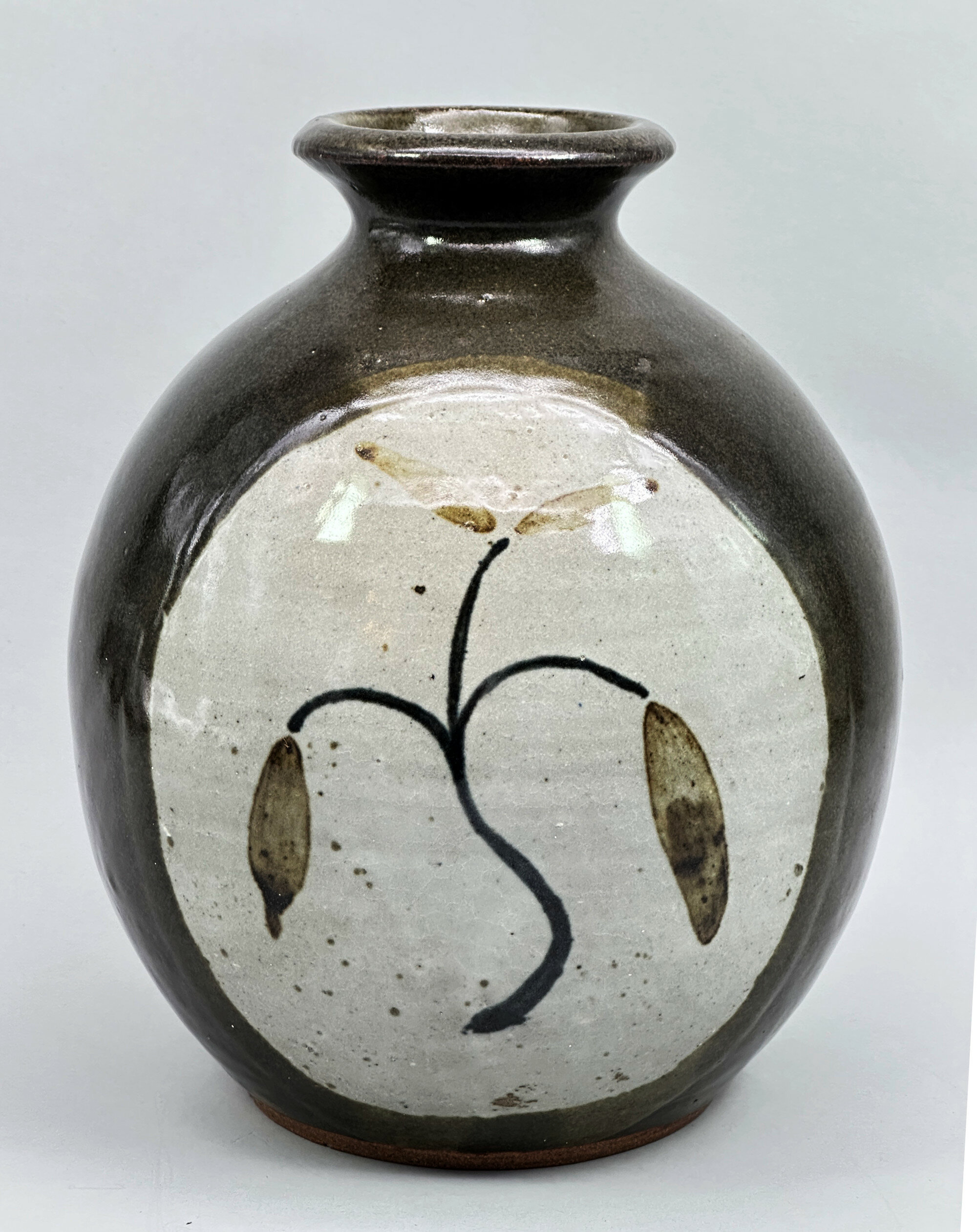
Studio Pottery Vase, Splatt Pottery, Cornwall, 1990s
Price: £55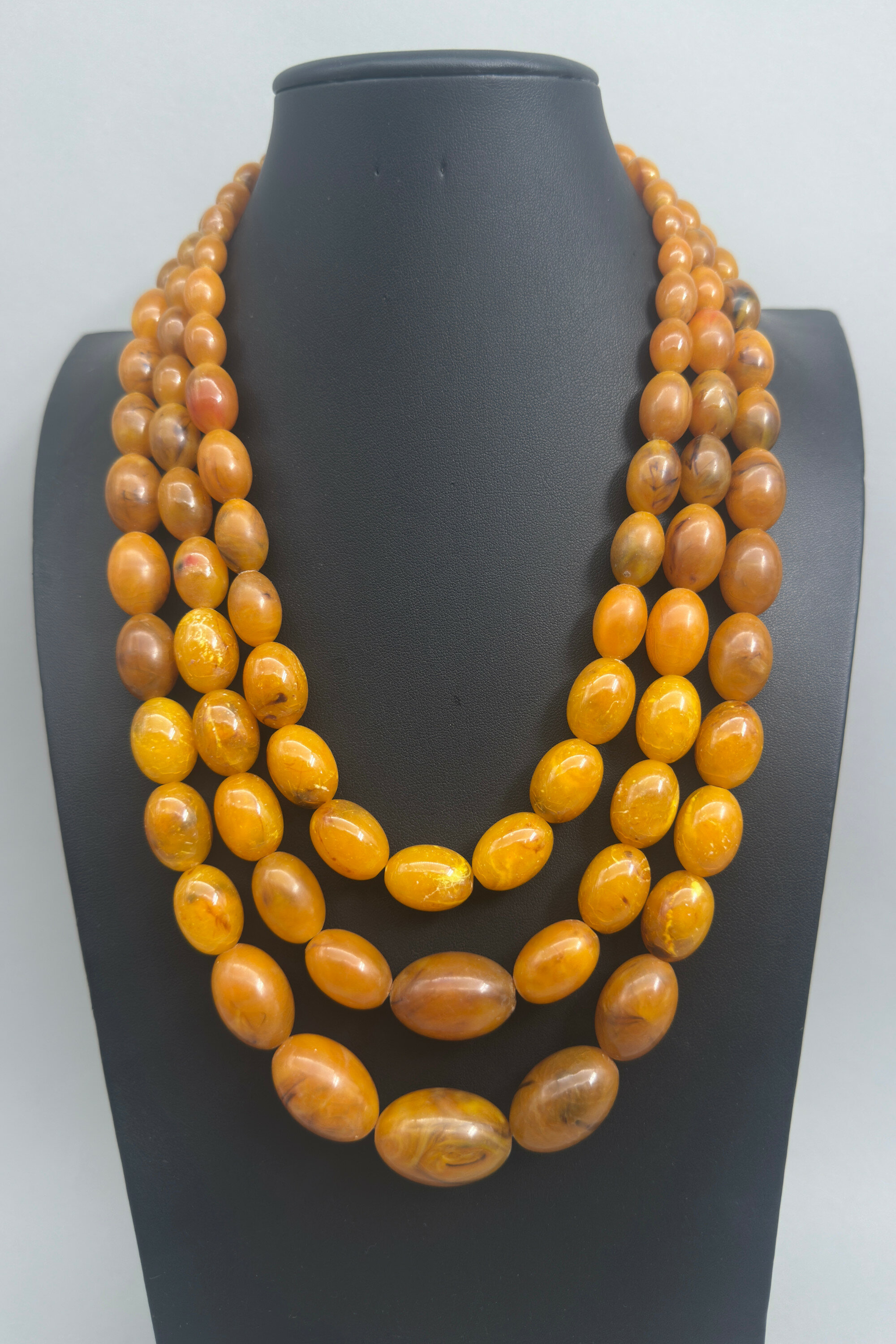
Triple strand of amber Bakelite beads, British 1930s
Price: £750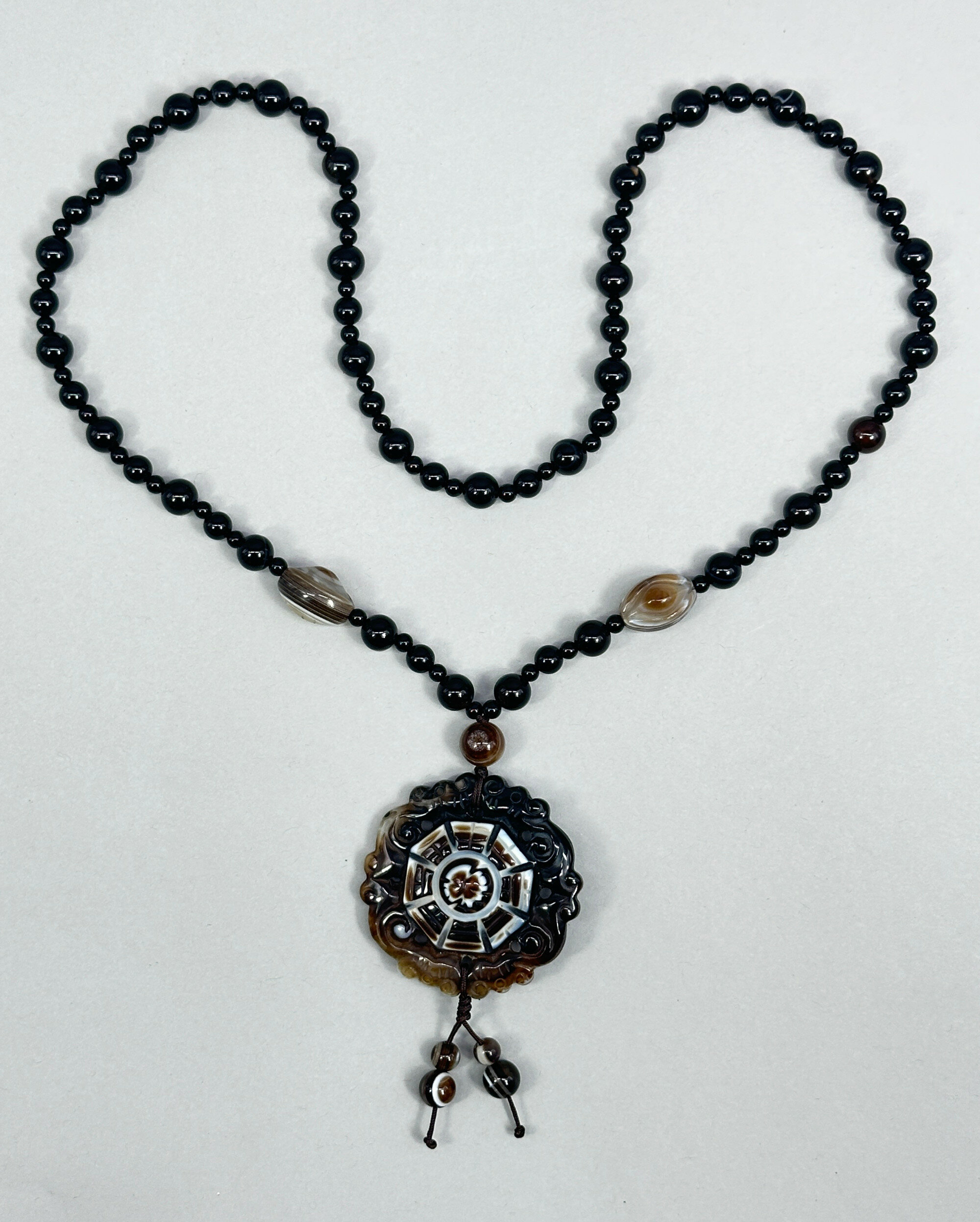
Chinese agate carving with onyx beads, 20th century
Price: £35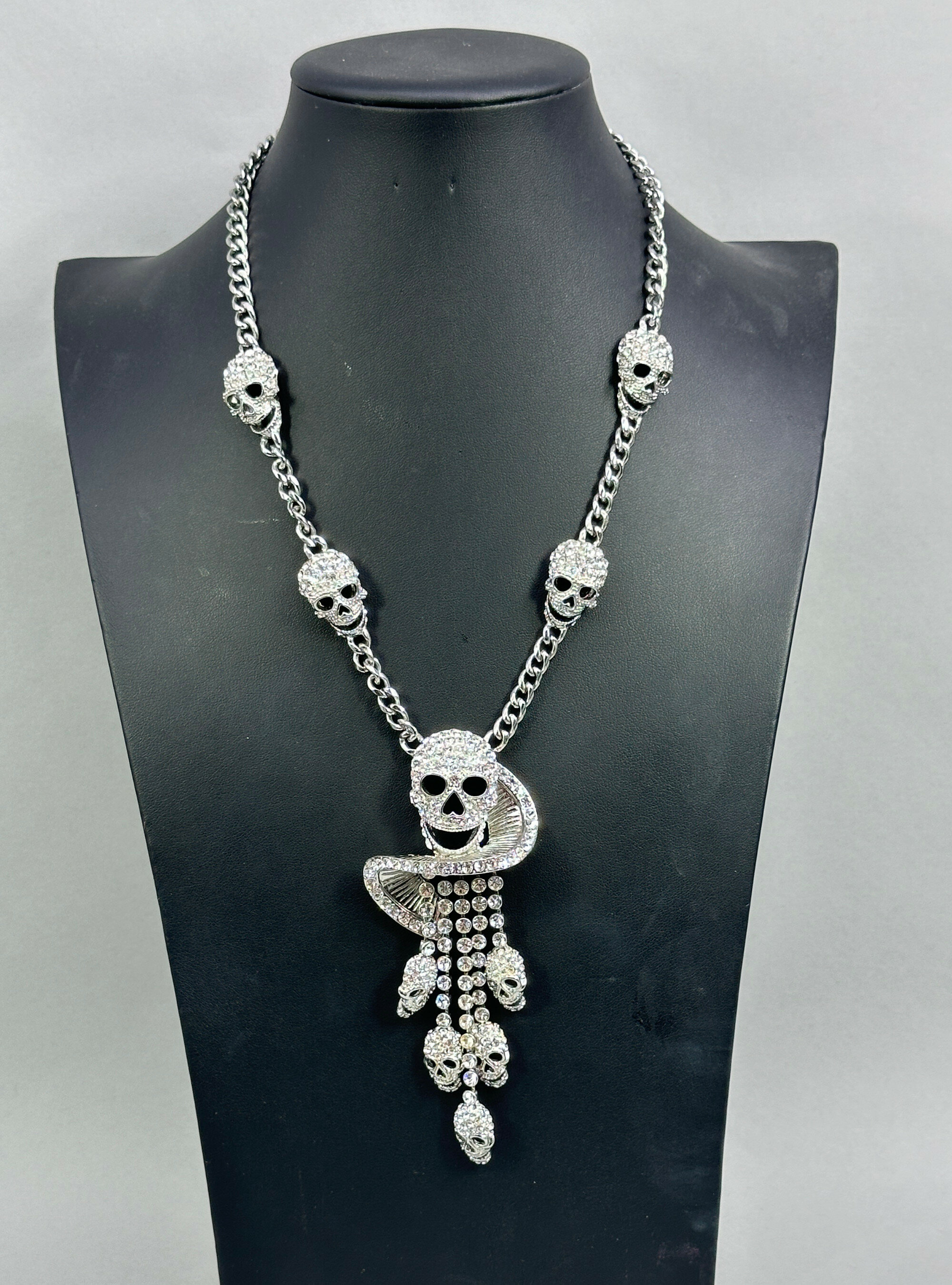
Butler and Wilson Skull Necklace, boxed, modern
Price: £125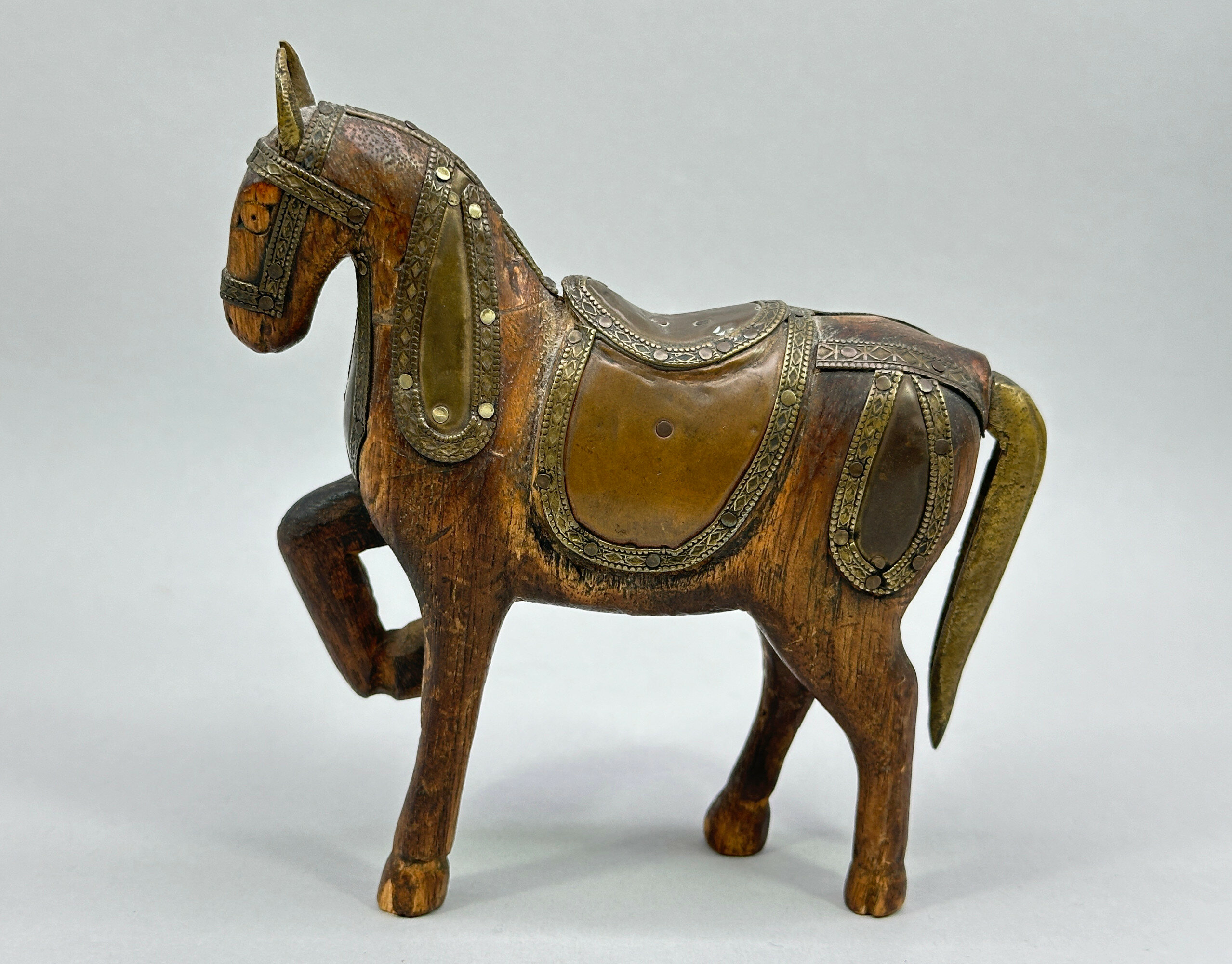
Indian wooden toy model of a Horse with metal fitments, early C20th
Price: £25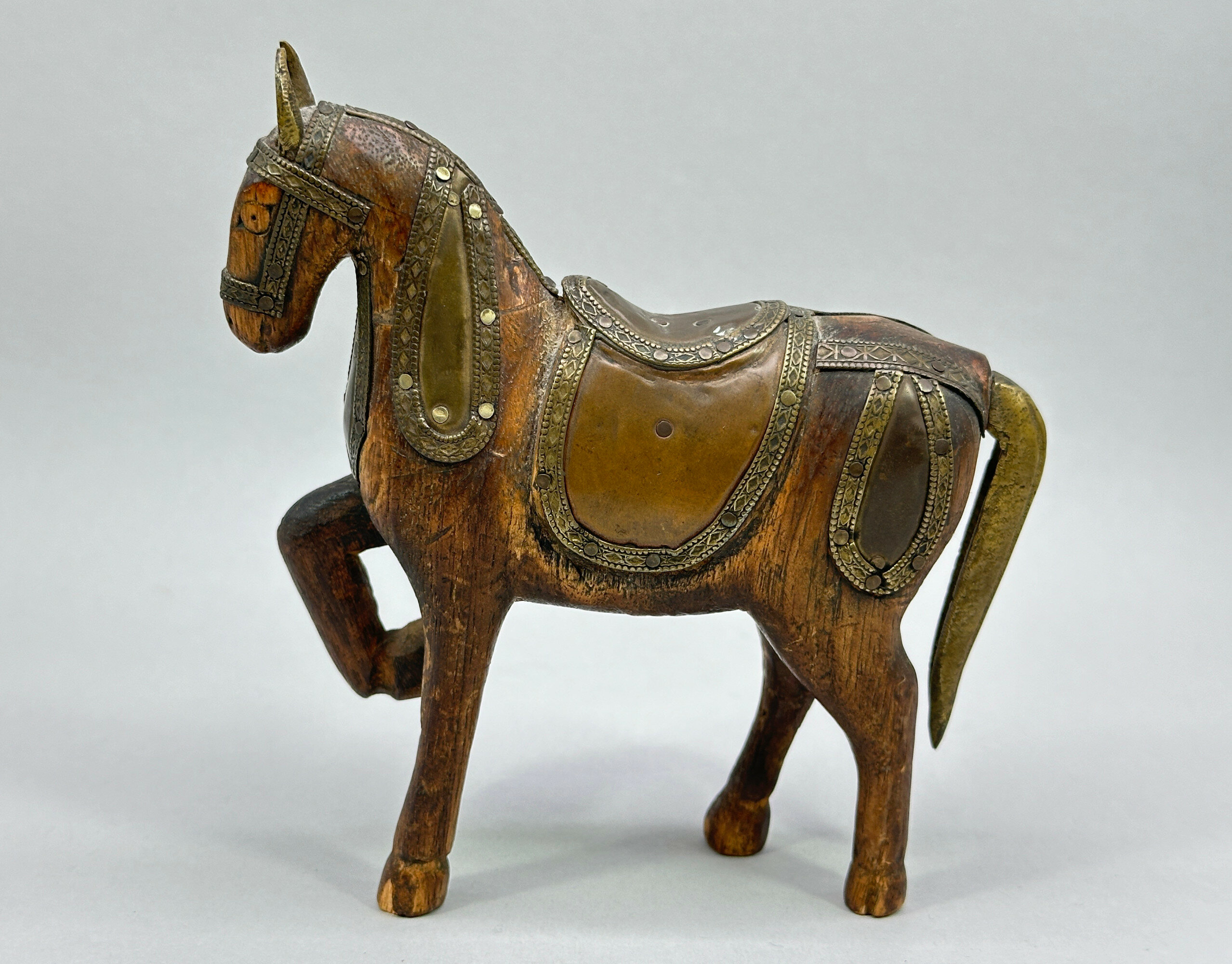
Indian wooden toy model of a Horse with metal fitments, early C20th
Price: £25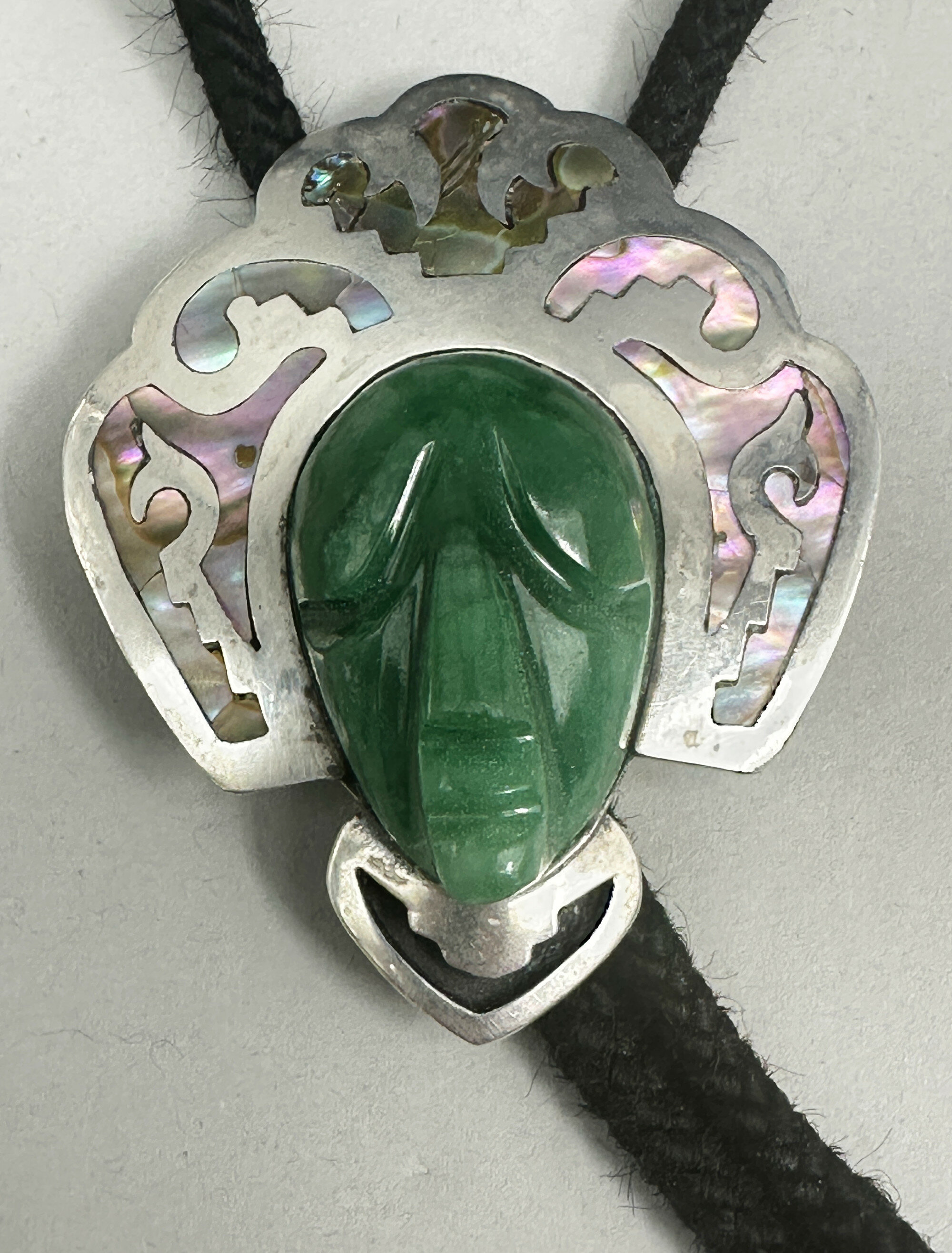
Mexican Silver Bolo Tie with Aztec mask Head, Taxco, c1950
Price: £125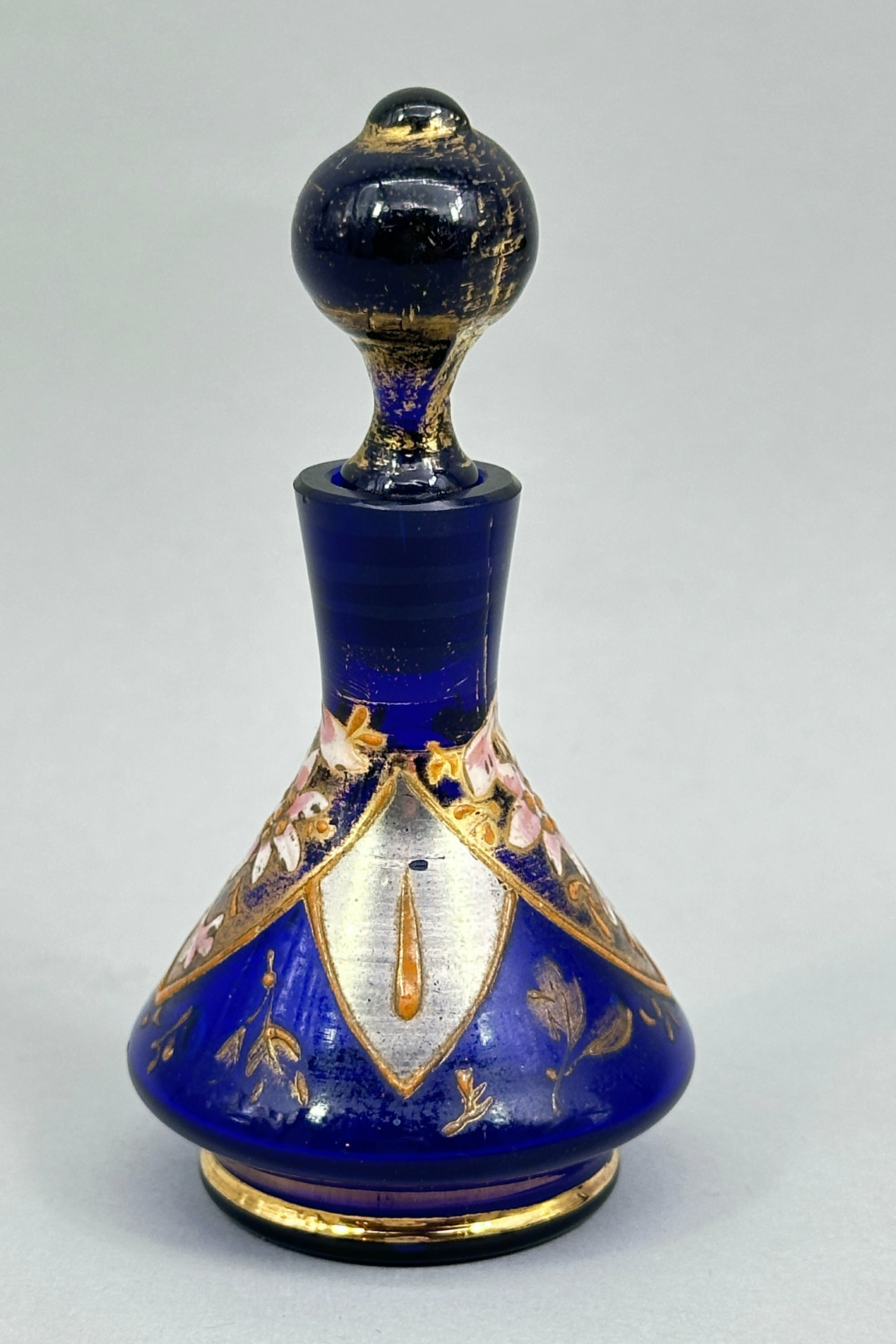
Bohemian cobalt blue Perfume Bottle and Stopper with enamel decoration, C20th
Price: £45So called ‘Bohemian’ glass was produced for export from the second half of the nineteenth century onwards by the workshops from the regions of Bohemia and Silesia, now parts of the Czech Republic. With its origins in the renaissance, Bohemian glass with its elaborate forms and colourful decoration of thickly enamelled floral subjects was made in substantial quantities to satisfy a keen demand from both Europe and America. The angular shape here along with the geometric elements to the decoration reflects the Art Deco style and suggests a dating to the 1930s.
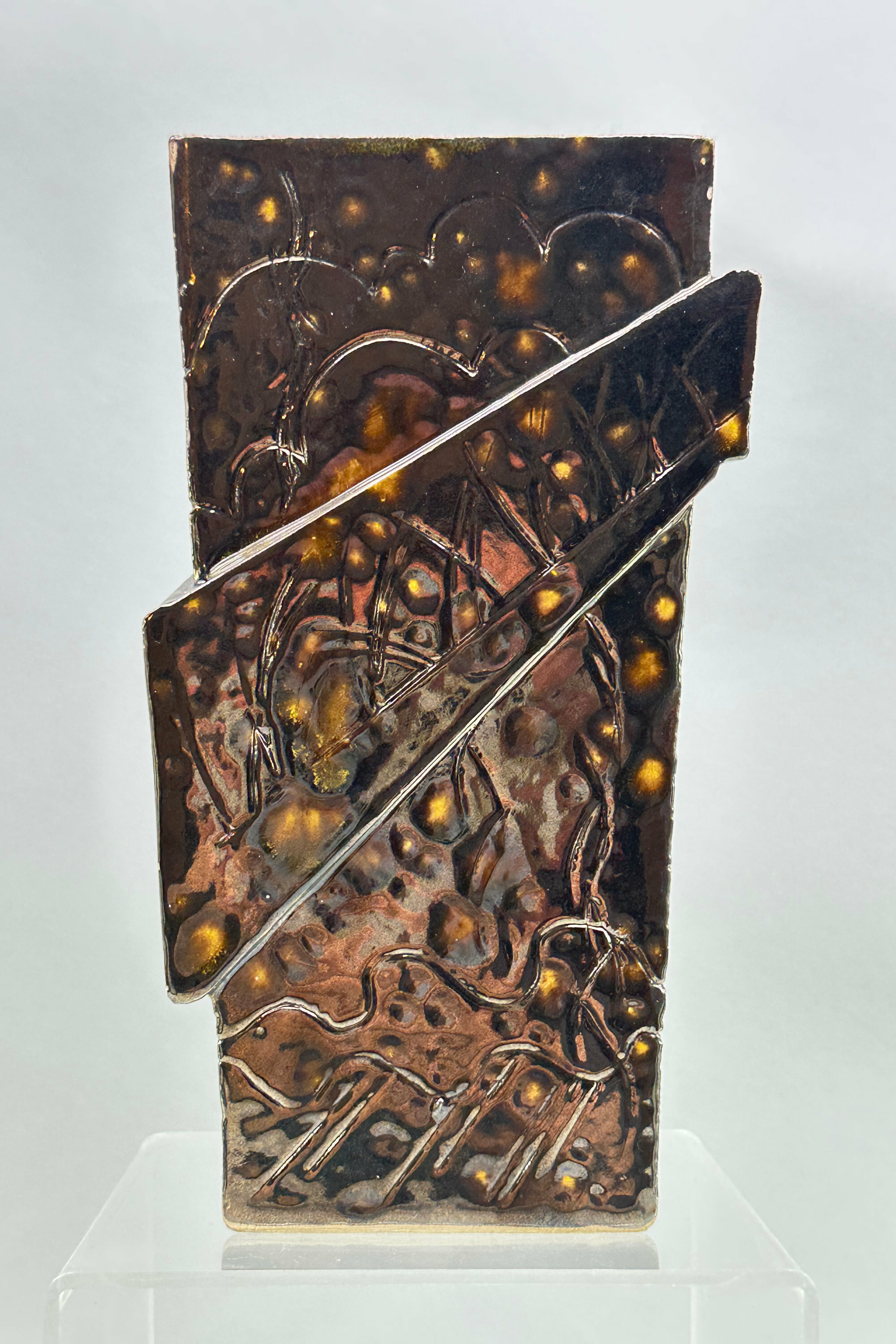
Art Deco Style brown lustre glaze triangular form Vase, signed, C20th
Price: £35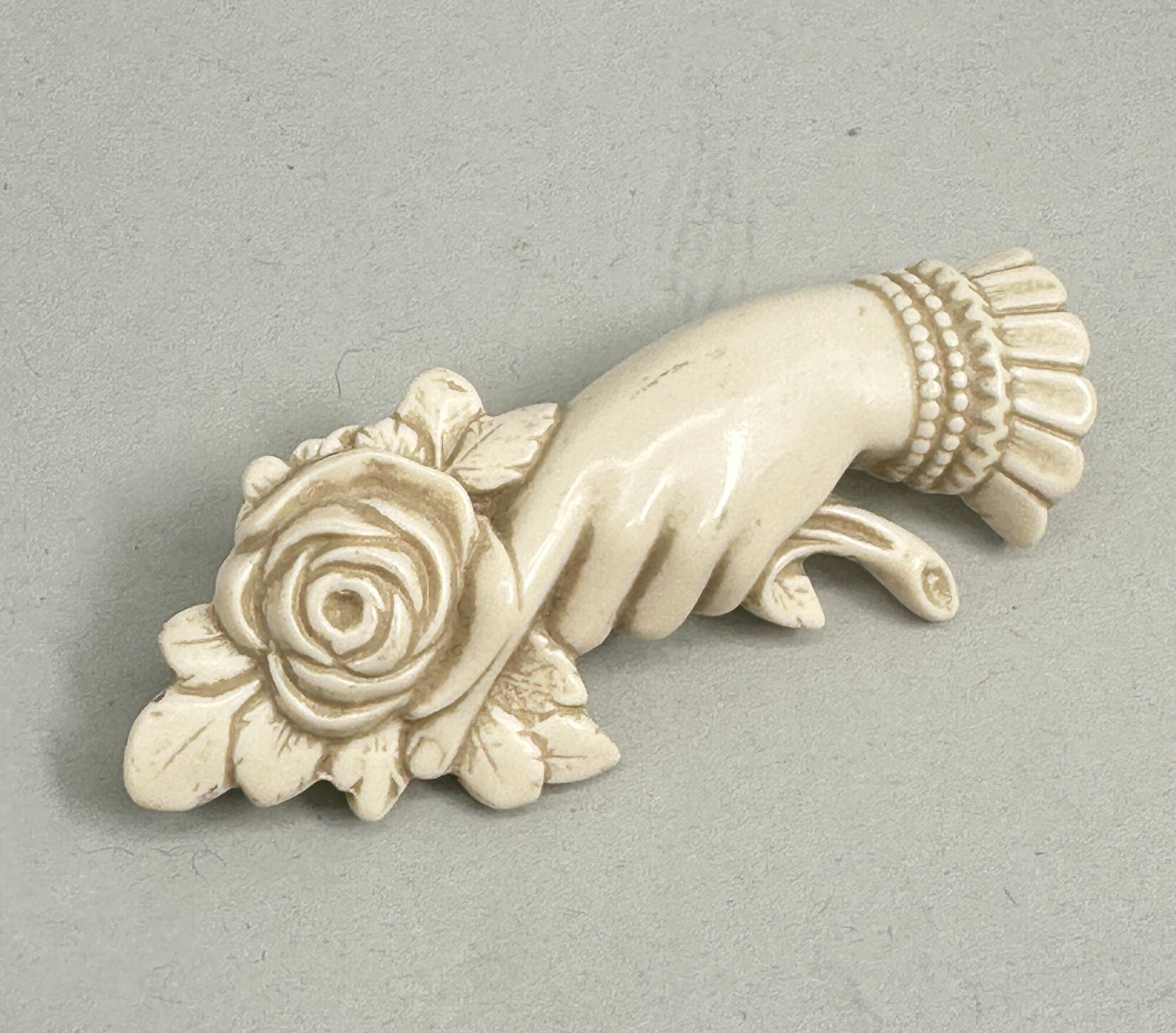
Bakelite Ivorine Mourning Brooch, British c1930
Price: £25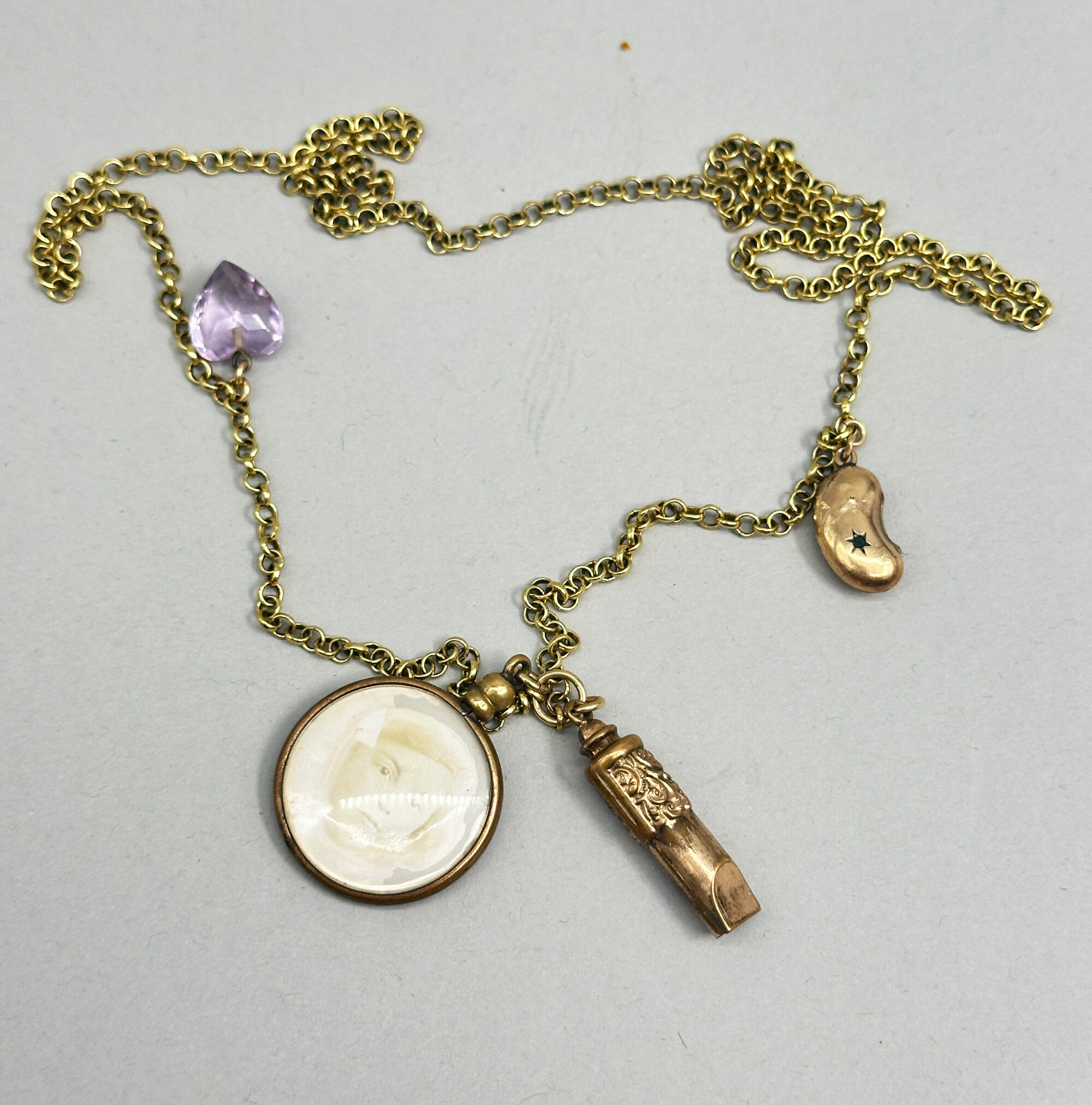
Victorian Rolled Gold Necklace with Pendants, late C19th
Price: £45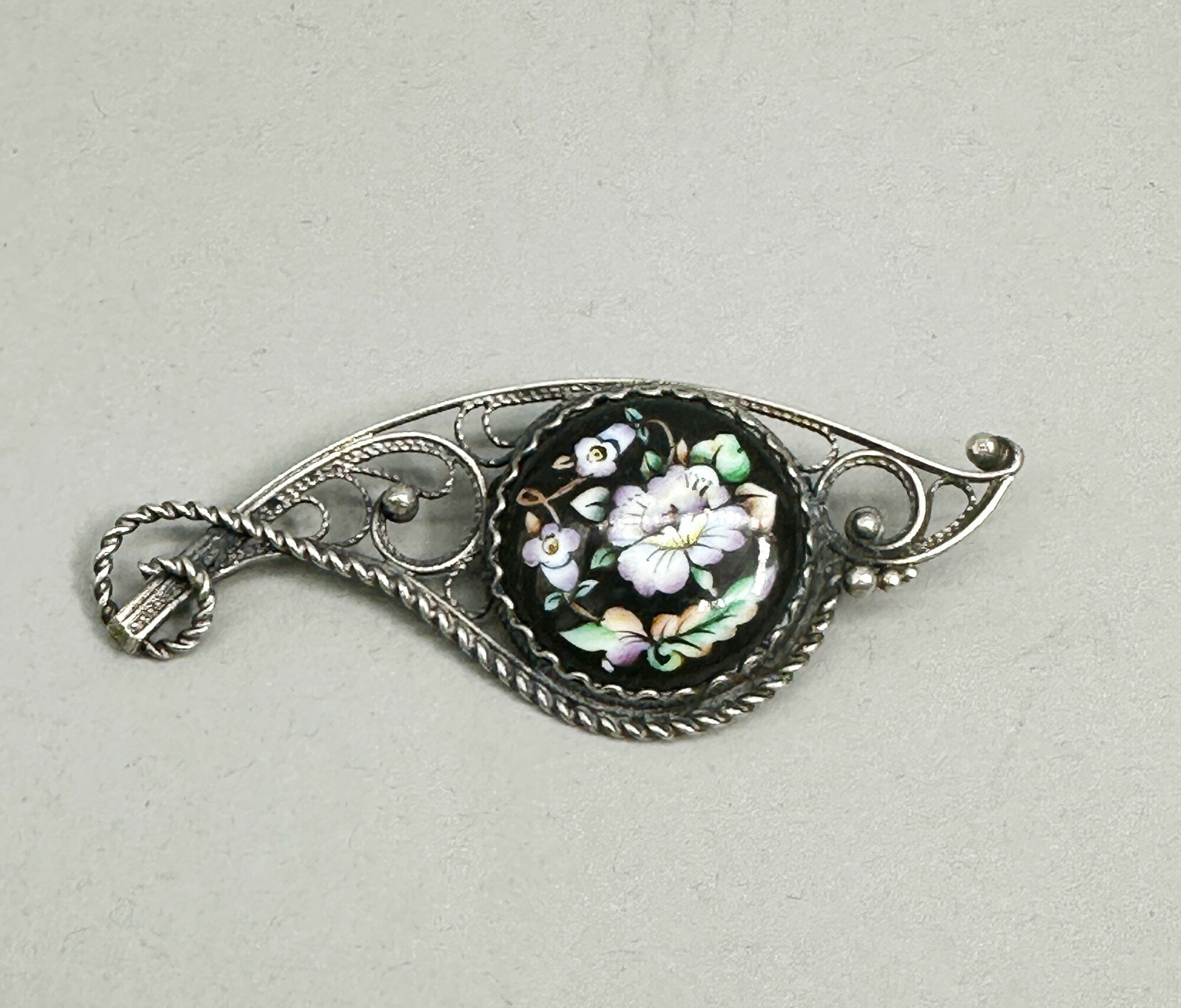
Russian Enamel Brooch, probably Rostov Finift, mid C20th
Price: £20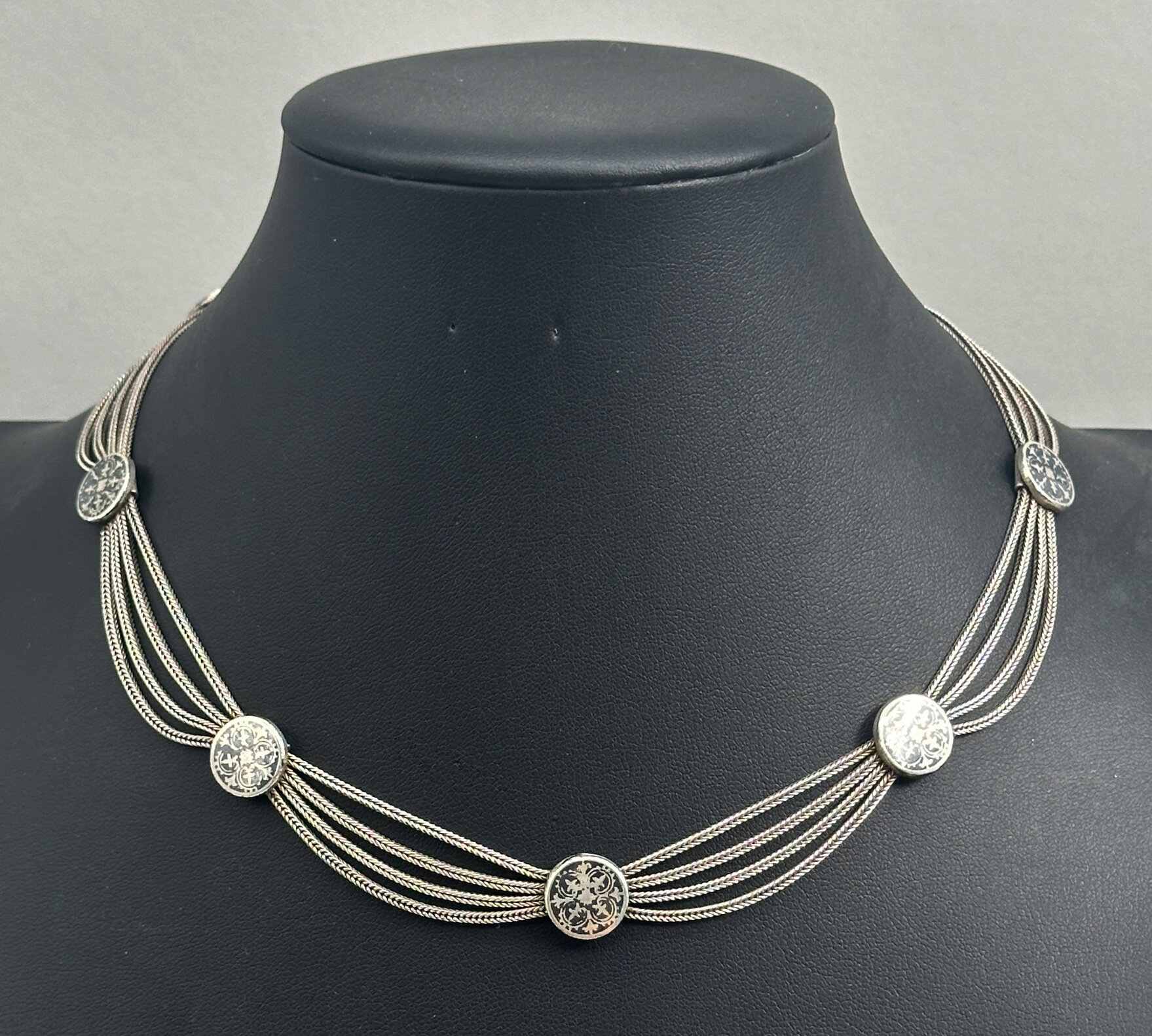
Islamic Silver Necklace with Niello work plaques, c1930
Price: £75The technique used is that of ‘niello’ work. (The word derives either from the classical Latin word ‘nigellum’ or the later mediaeval words ‘nigello’ or ‘neelo’.) Niello is a black mixture, usually of sulphur, copper, silver, and lead and used as an inlay on engraved or etched metal, especially silver. Added as a paste, it hardens to a black colour after firing and is then polished. Here it is the ground that formed from niello while the design shows though in silver, a less common version.
There is much skill in the craftsmanship here and the result is a piece of classic and timeless simplicity.
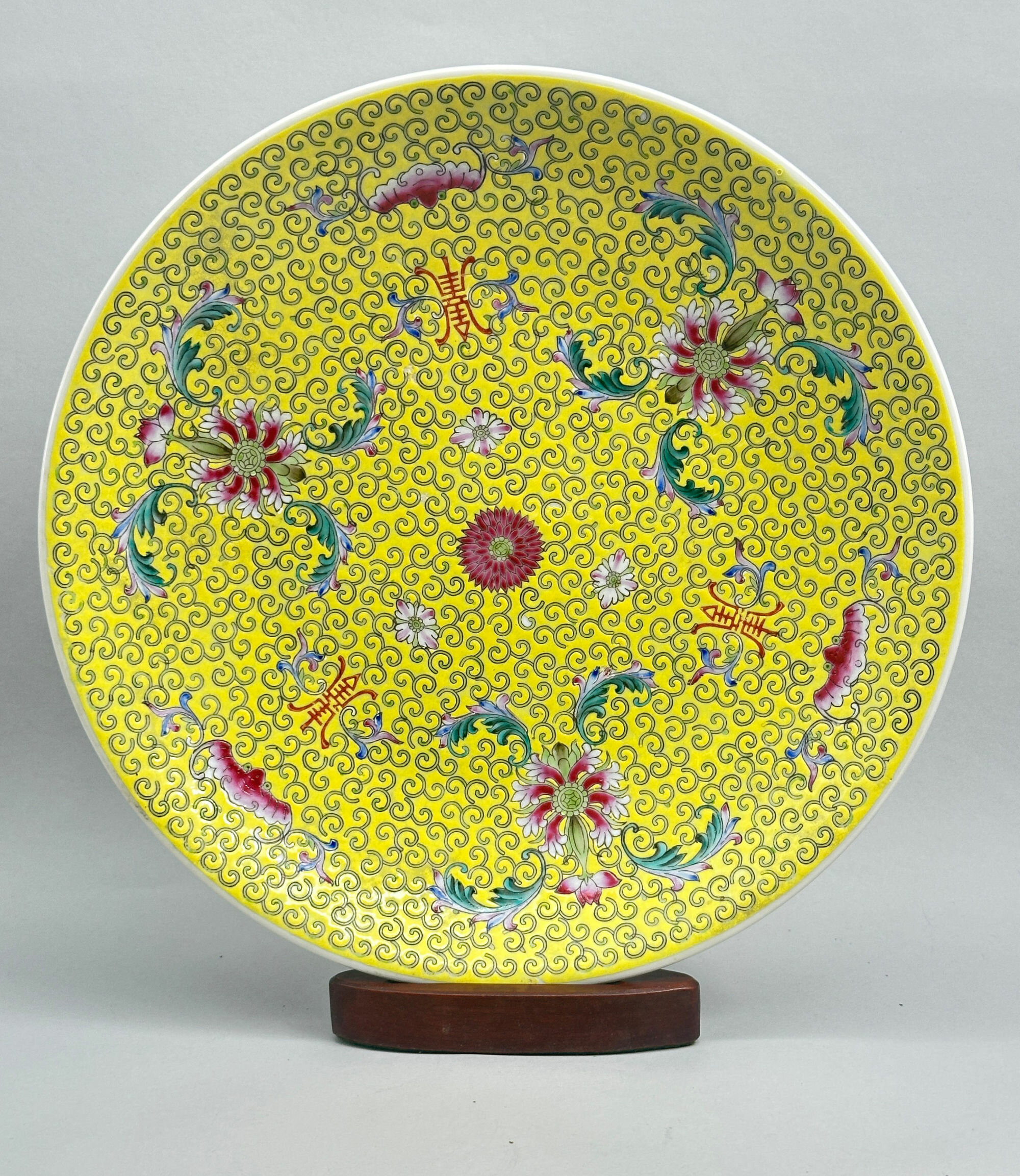
Chinese Yellow Ground Famille Rose Charger, 1950s/early 1960s
Price: £55This is a fine example of the porcelains made at Jingdezhen, for centuries the chief centre of ceramic production in China, in the early years of the People’s Republic of China (1949-). Soon after the communists took control, the kilns at Jingdezhen were organised into co-operatives, each with a number. Many of their pieces were marked and the form of the mark determines the date of production. The circular marks, as here, were the earliest allowing a dating of this charger to the 1950s or possibly the early 1960s. Some of these conglomerates, for the quality can vary, retained the skills of their predecessors and produced works of high quality. This is clearly seen here in the careful and precise enamelling and the general artistry of the design employing ‘imperial’ yellow with the symbolism of happiness (bats), longevity (shou symbols), friendship and a life of ease (chrysanthemum) and fruitfulness and offspring (lotus), all combining to produce a piece well worthy of its many predecessors.
Please note that the wood stand is for display purposes only and is not incuded with this lot.
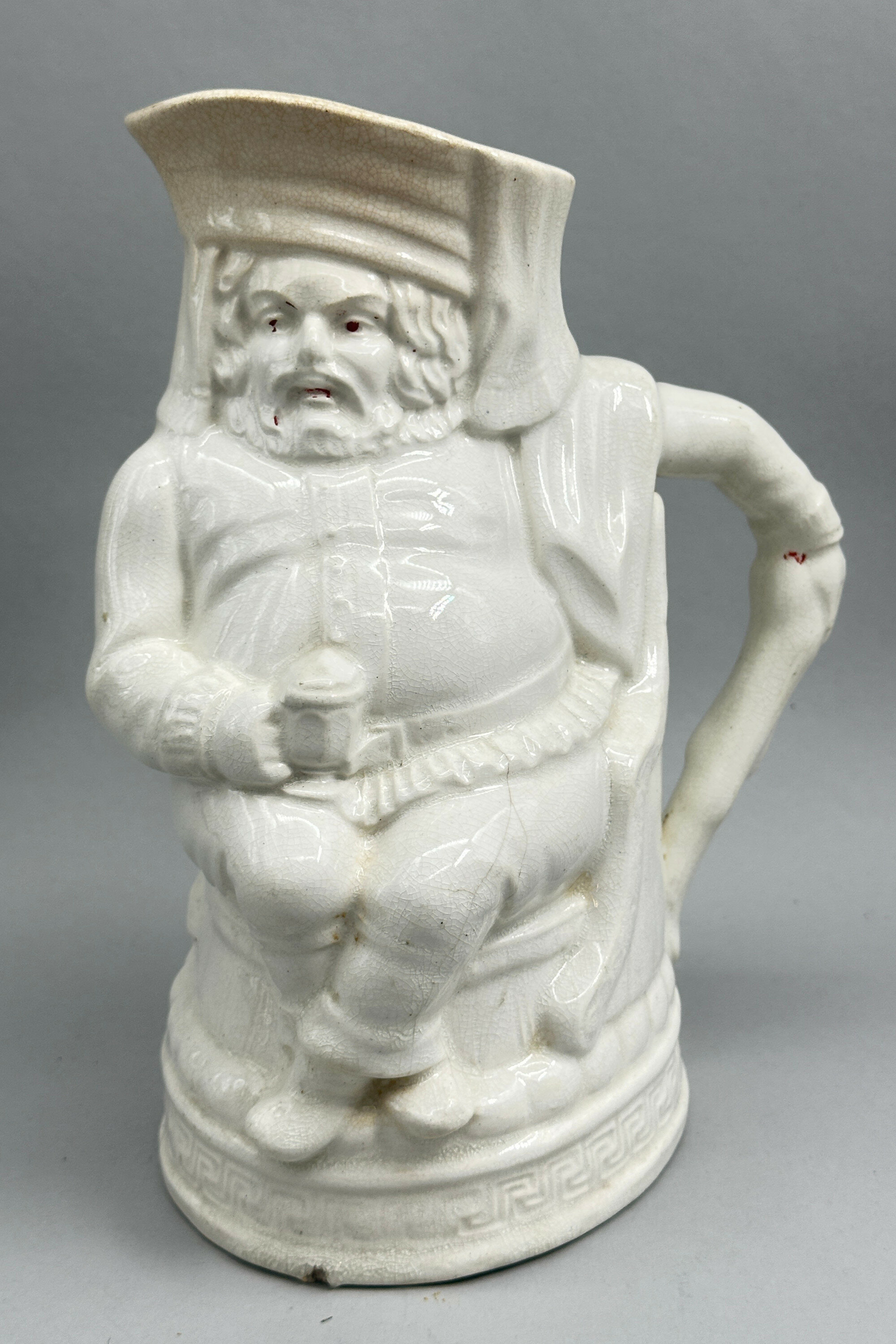
Earthenware Jug, Falstaff or Old King Cole, Furnival and Clark, mid C19th
Price: £75The design for this jug, usually termed ‘Falstaff’ but sometimes ‘Old King Cole’ is known to have been registered (Rd.No. 32601)by the firm Furnival and Clark on December 30th 1845. This was a very short lived partnership between Thomas Furnival and Richard Clark, based at the Stafford Street Pottery Works, Hanley, Staffordshire and which traded from 1844 to 1846 apparently producing just this one model, albeit in a variety of colours. Thomas Furnival had been involved in other firms before this brief venture and was to be involved in others afterwards. The dating of these mugs is usually attributed to the short period when Furnival and Clark traded but it is quite possible that more pieces were produced afterwards by Furnival himself. The paste and finish of this piece, though, which is not marked, certainly suggest a mid nineteenth century dating. In general, the model is quite rare. Some examples were fitted with a Britannia metal or pewter lid but this was never integral to the piece. This striking composition, then, is a rare and desirable item collectors with an interest in British Staffordshire wares.
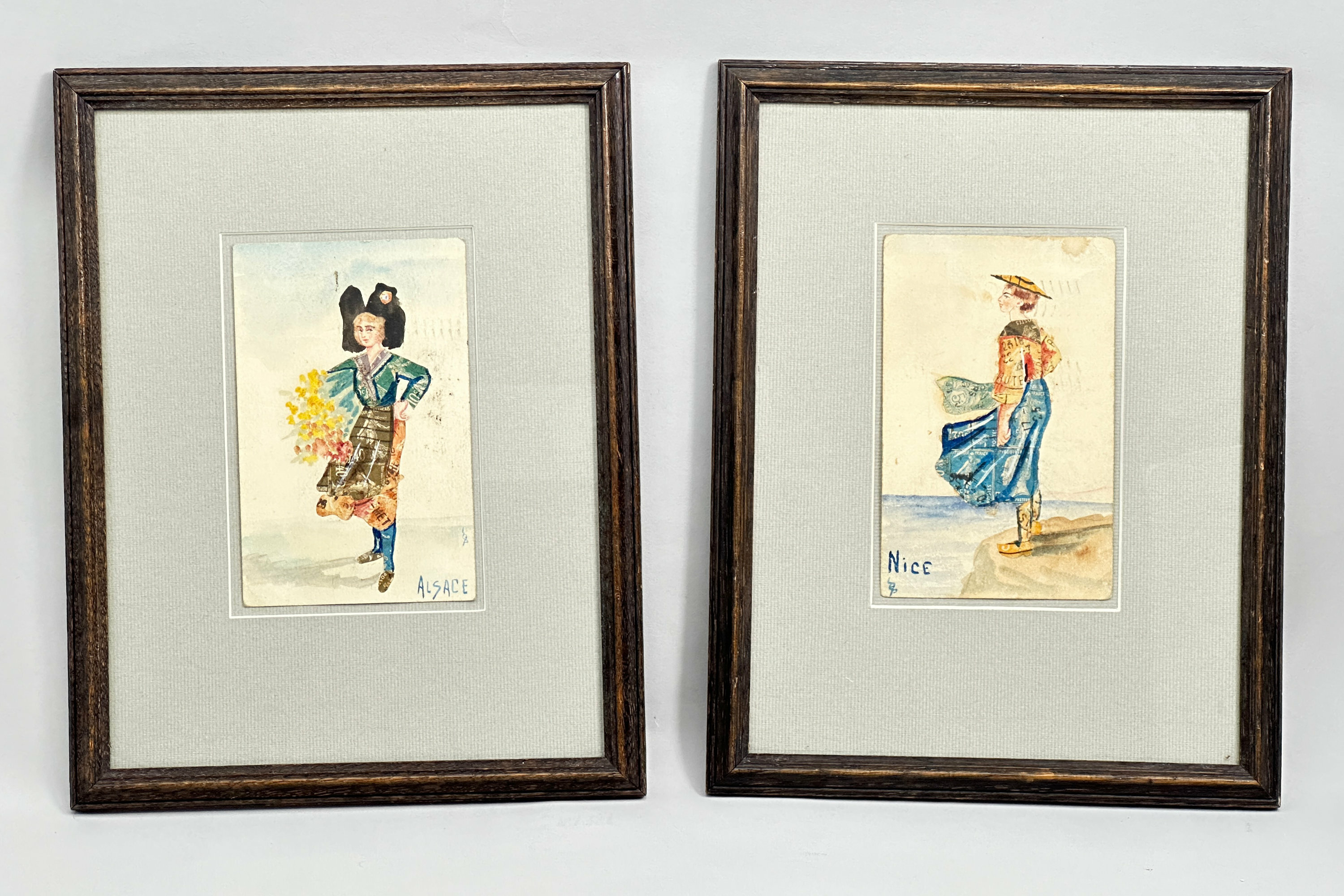
A pair of stamp collage Postcards, Alsace and Nice, framed, early C20th
Price: £45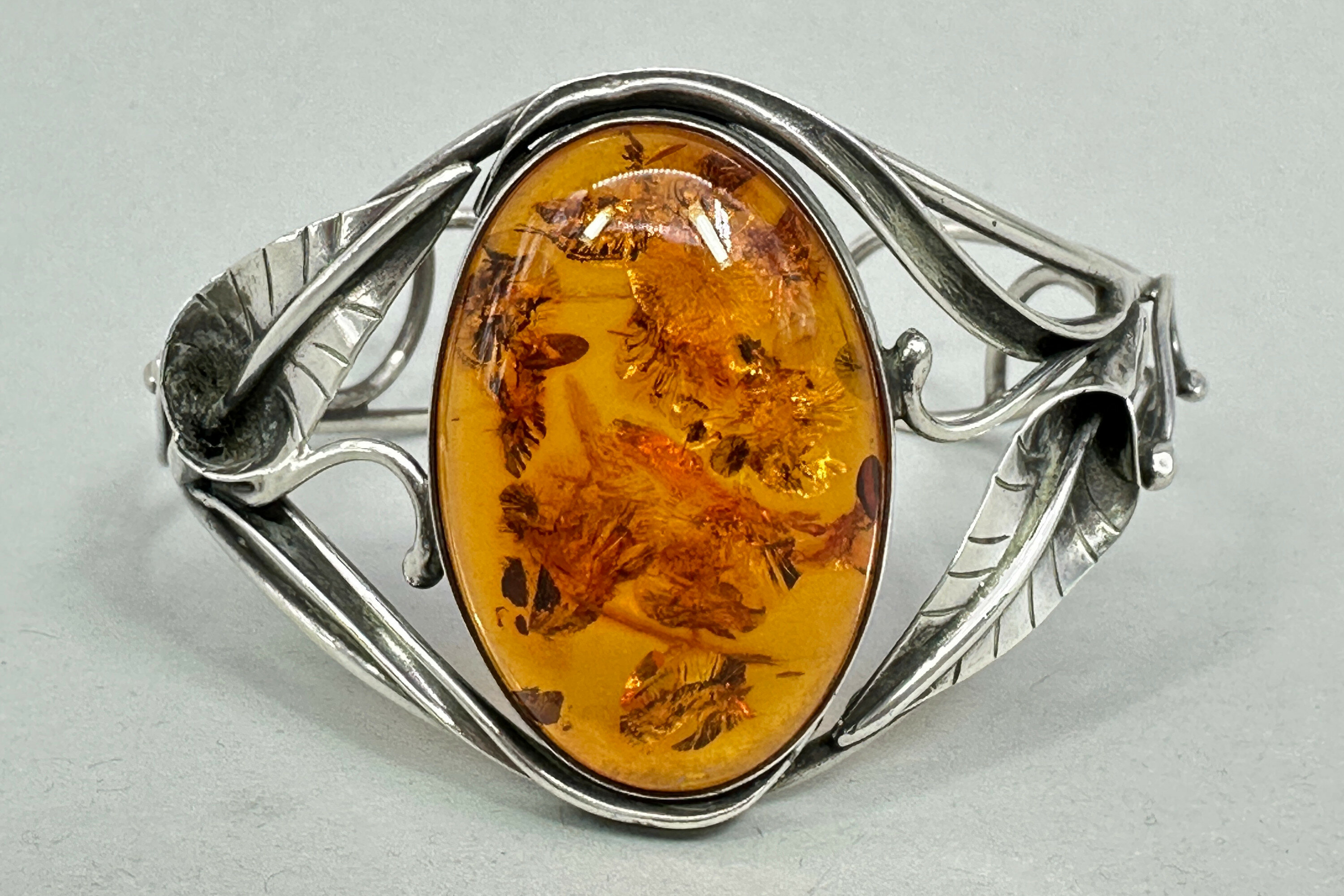
Large amber cabochon cuff Bracelet, c1970
Price: £95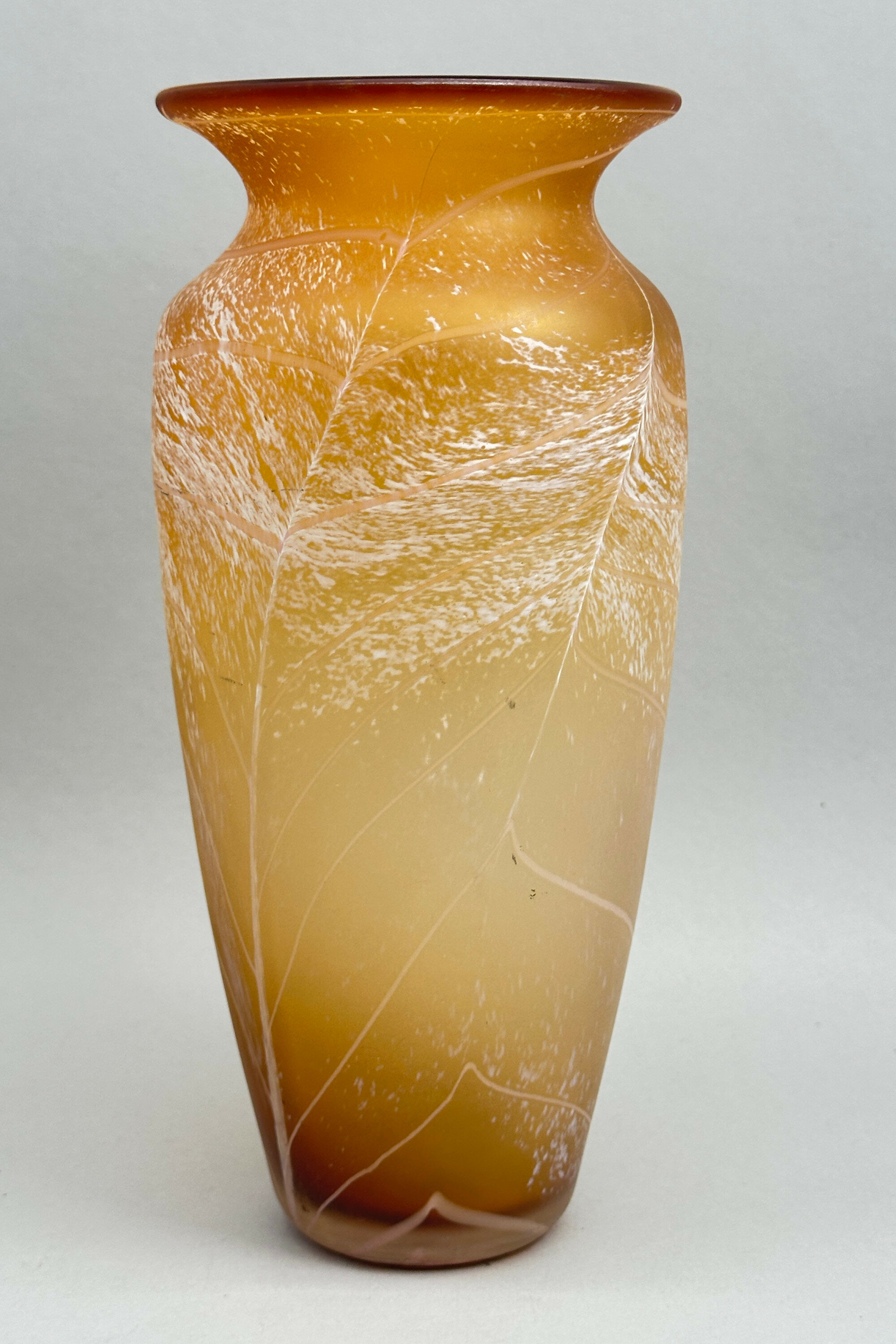
Art glass feather design Vase, probably German second half C20th
Estimate: £30 – 40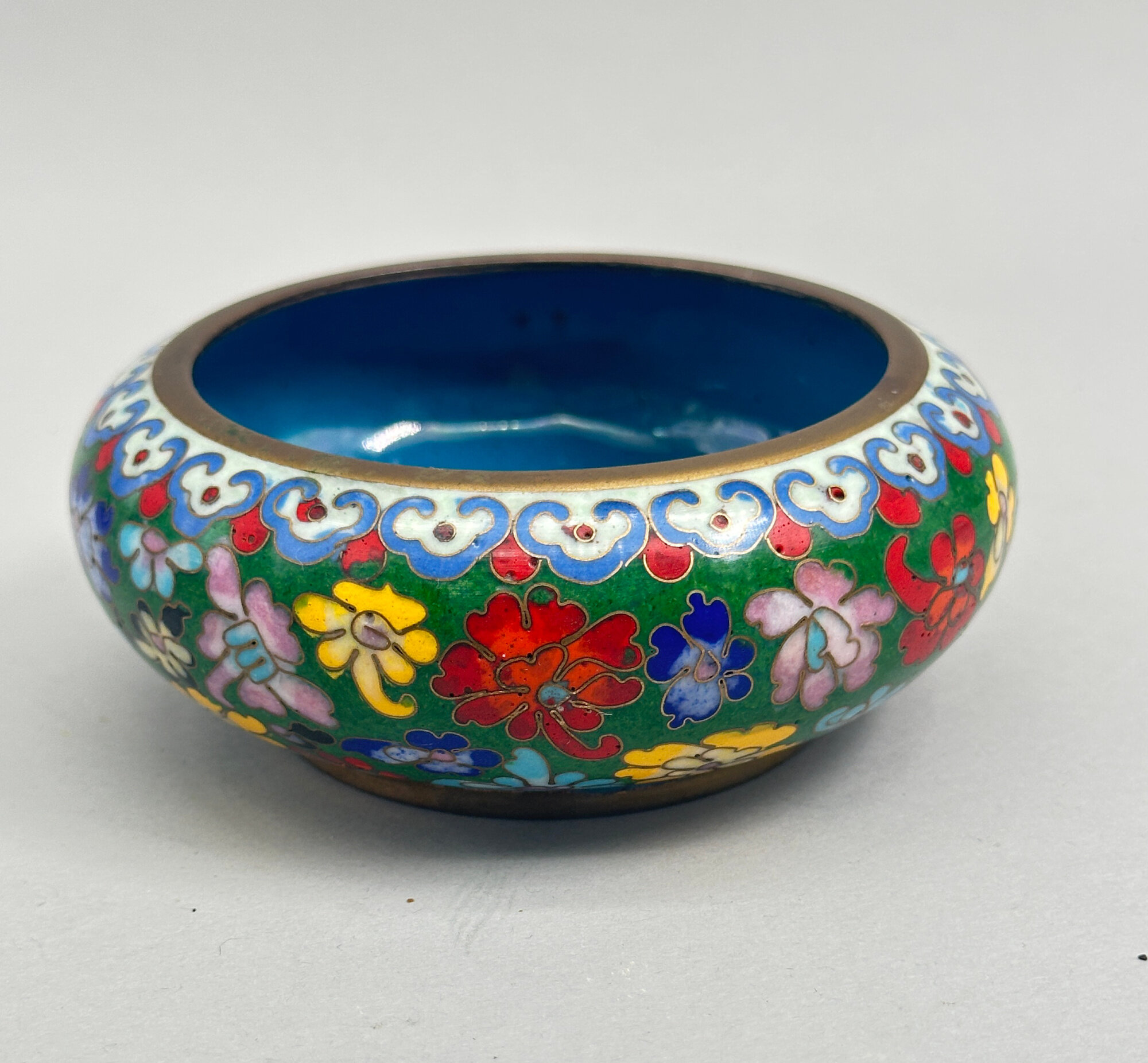
Chinese Cloisonne Shallow Bowl, C19th
Price: £45
Art Deco style Glass Box and Cover decorated with a dancing Ballerina, mid C20th
Price: £35
Art Deco style Glass Box and Cover decorated with a dancing Ballerina, mid C20th
Price: £35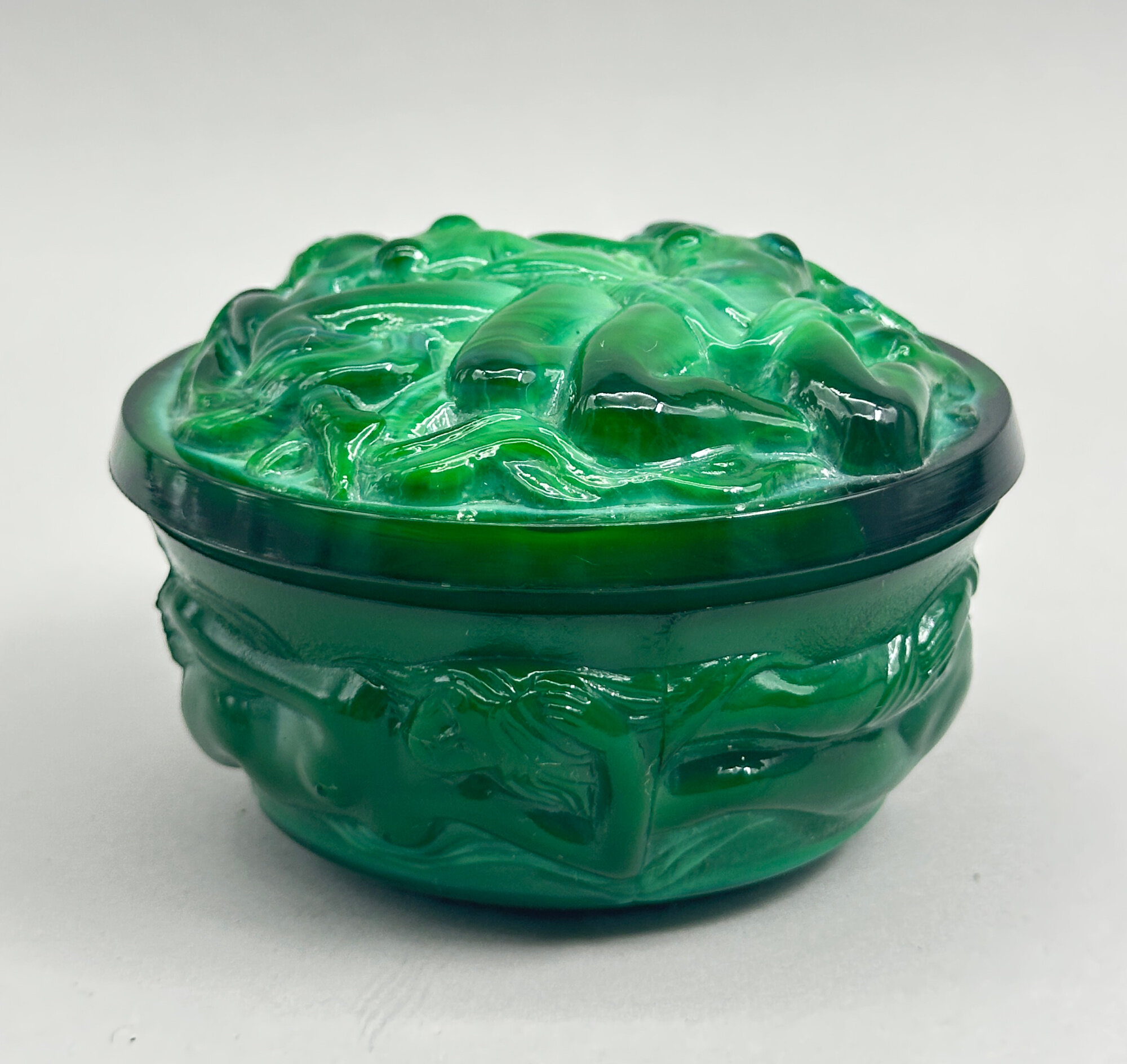
Art Deco Style Malachite Glass Box and Cover, Hoffmann & Schlevogt, C20th
Price: £55Heinrich Hoffmann (1875 – 1939) and Henry Schlevogt (1904 – 1984) were relatives as well as business partners, Schlevogt having married Hoffman’s daughter. They worked together on a variety of designs and from the moulds they produced came pieces exclusively pressed by the family glassworks of Josef Riedel established in Polaun (Polubný), Bohemia. The collection was marketed under the brand name ‘Ingrid’ and had an immediate success in Europe and the United States, being introduced at the Spring Trade Fair in Leipzig in 1934 and later in the same year presented at the Chicago World’s Fair. Hoffmann died around the time of the beginning of the second world war but Schlevogt remained in Bohemia until his capture by the invading Red Army in 1944. Eventually rescued through the intervention of influential friends, he settled in Paris and in the 1950s founded a highly successful wholesale business trading in crystals and glassware which he sold in 1972. The Czechoslovak government meanwhile nationalised the glass industry after World War II and some of Schlevogt’s moulds were reused with pressings known from the 1970s made as before at the glassworks of Josef Riedel.
Dating of the pieces is extremely difficult since the later versions resemble the earlier ones so closely and there are few firm guidelines. But the example here, even if there is the possibility that it does not date to the 1930s, is an extremely accurate reflection of the model types produced. The design is striking with the malachite effect glass formed into a two section box the deep base fitted with a shallow domed lid and both parts decorated with naked ladies swimming amidst waves in a swirling design of life and movement. The joins of the moulds can be clearly seen at the sides (see images 8 & 9). The style is quintessentially Art Deco and this is a ‘must have’ for collectors of pieces from that era.

Chinese carving of a Beggar, possibly Shoushan stone, Soapstone stand, C20th
Price: £55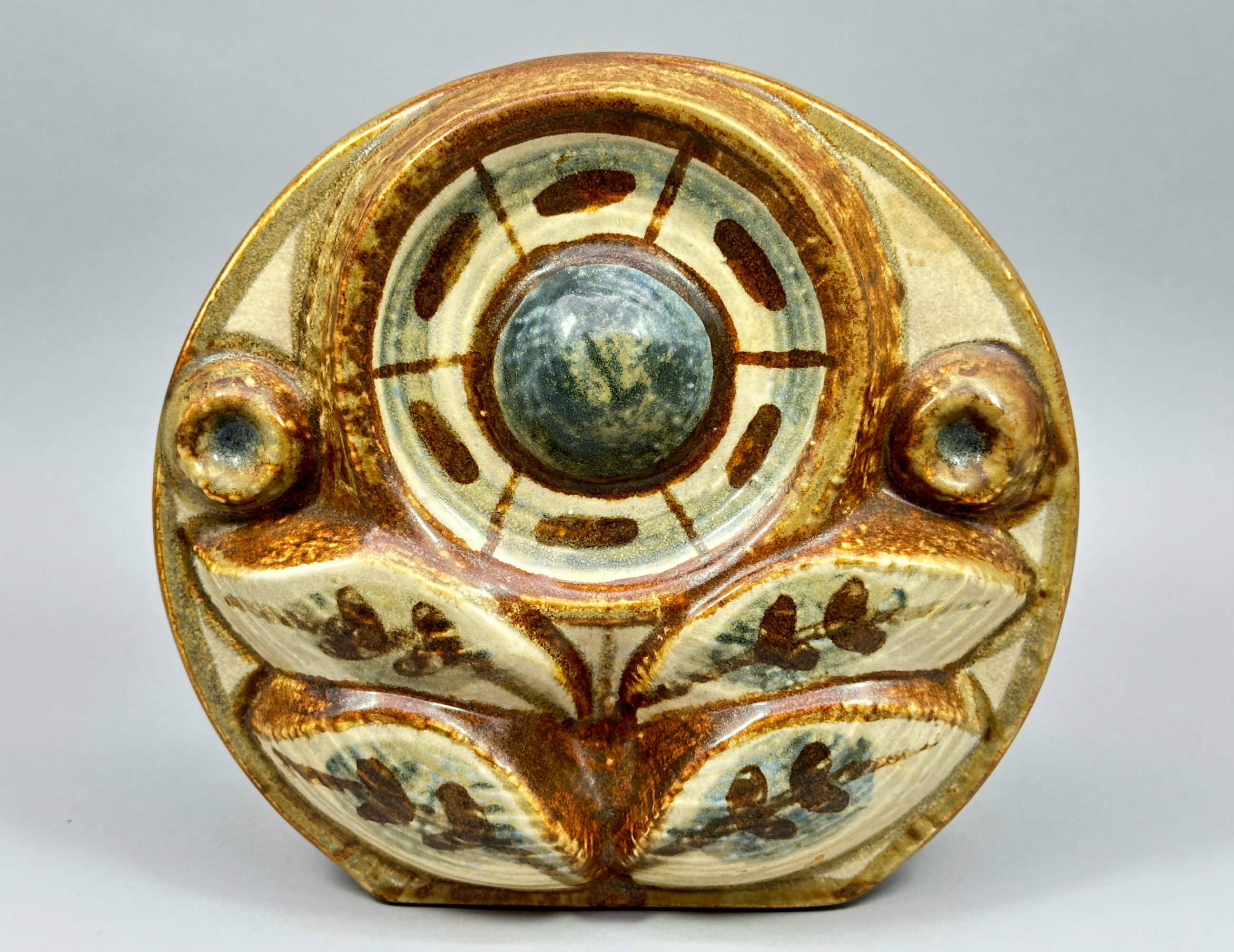
Wall Vase, designed by Noomi Backhausen, Søholm Stentøj, Denmark, late C20th
Price: £95The company Søholm Stentøj was founded by Herman Sonne Wolffsen and Edvard Christian Sonne in 1835 at Rønne, the principal town of Bornholm, a Danish island off the south coast of Sweden. One of the most respected of the Danish potteries it continued producing a wide range of ceramics until the firm closed in 1996. Noomi Backhausen was a designer for Søholm from 1966 to 1990 and set up her own pottery in Rønne in 1996 after the closure of her old employers. This wall vase is a typical example of her abstract organic designs and would be a worthy addition to a collection of twentieth century Danish design.
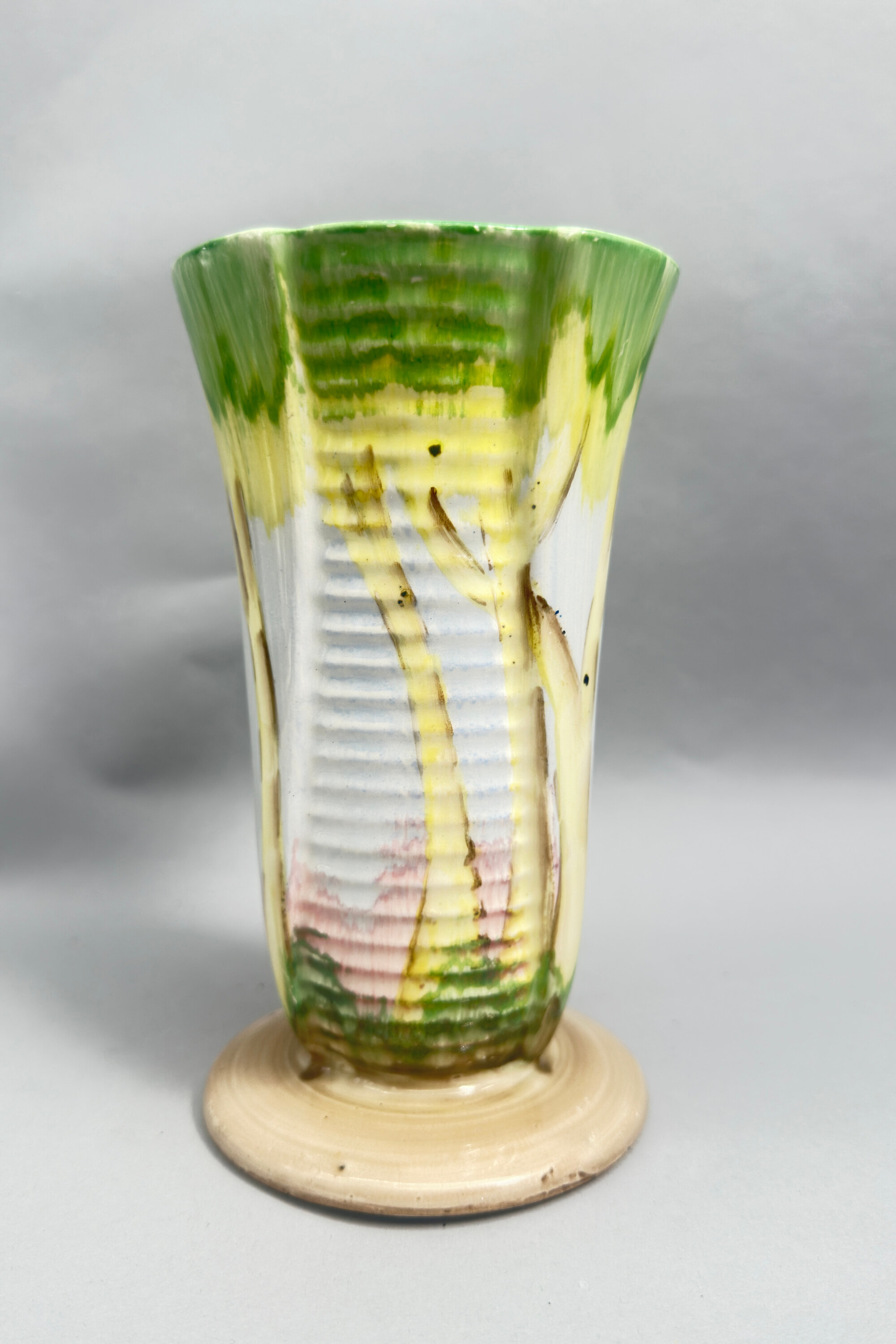
Art Deco style beaker form Vase, probably Beswick, mid C20th
Price: £35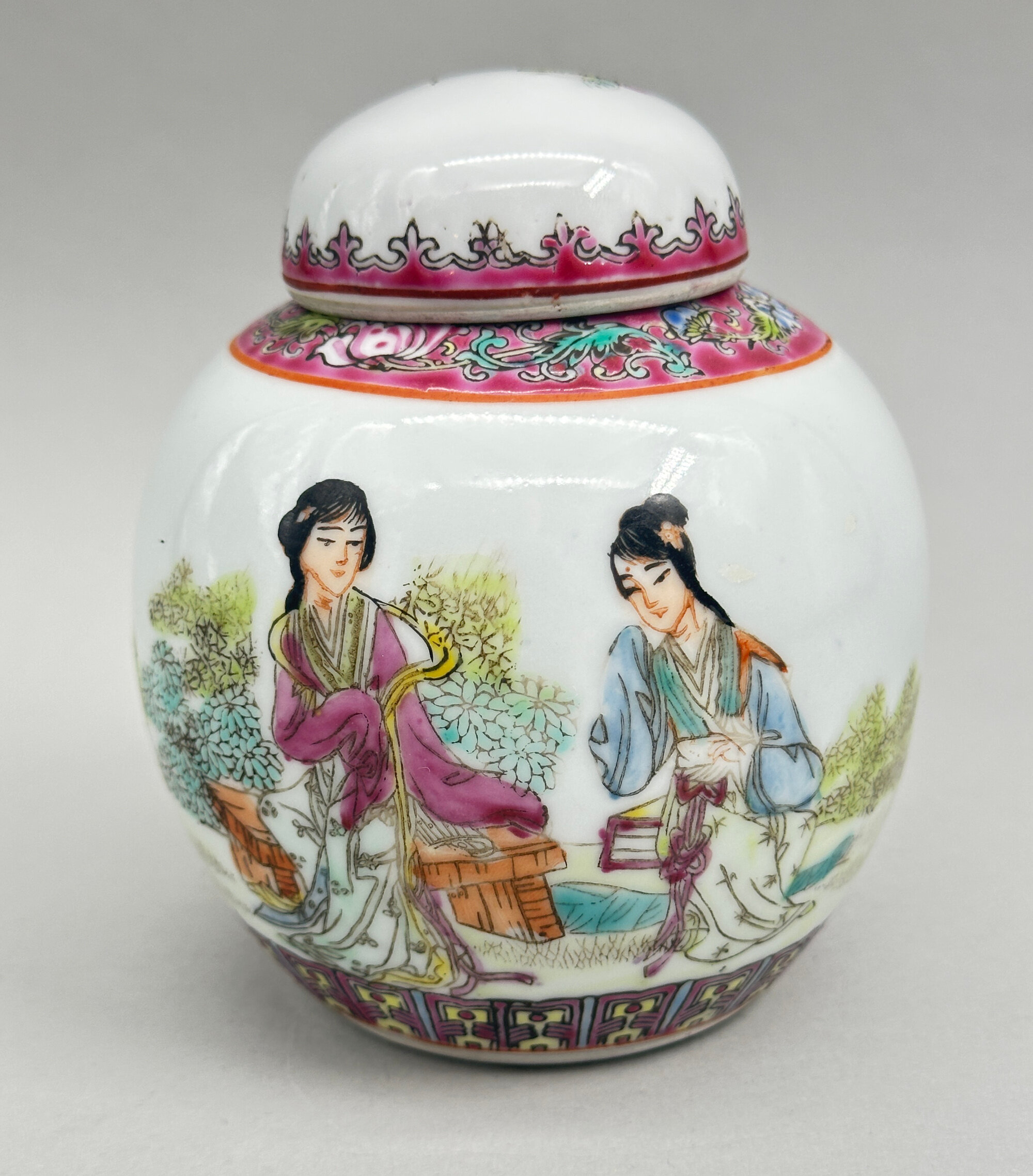
Chinese Republican Style small Famille Rose Ginger Jar and Cover, late c20th
Price: £20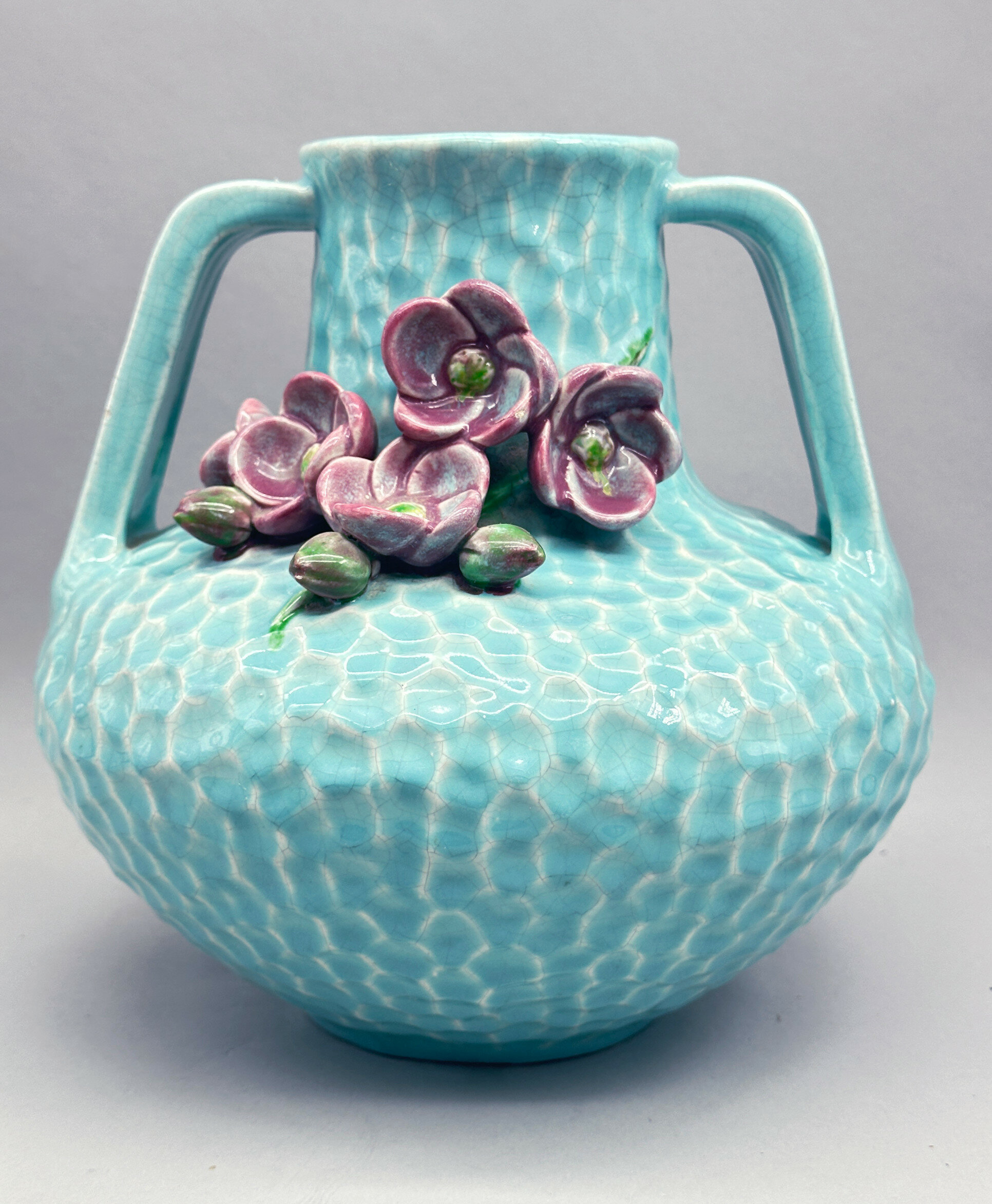
Art Nouveau style turquoise glazed Urn shape Vase, Bretby ware, early C20th
Price: £75The firm Bretby was the result of an amalgamation between Henry Tooth and William Ault who formed a partnership in 1883. Both had previously worked at the Linthorpe pottery established by Christopher Dresser in 1879 and retained a comnnection with the celebrated designer even after striking out on their own. Success came early and the firm won a gold award in the Crystal Palace Exhibition of 1884, patenting their trademark with its sunburst design above the name Bretby in the same year. Ault left the partnership in 1887 to set up his own business under his own name but Henry Tooth continued to oversee production until his death in 1918, the business then remaining under the control of the Tooth family until it was sold in 1933. Production continued, though, well into the twentieth century until the firm closed around in the late 1990s.
This piece is typical of their earlier work with a nod to both the art nouveau style and Dresser himself, particularly in the shape of the handles. ‘Hammered’ decoration was typical of the Arts and Crafts movement popular at the time and the applied floral decoration has some parallels with Japanese pieces again much in vogue at that period. Similar pieces are known with the same shape and pattern number (1742) which seems itself also to indicate an early twentieth century dating, but the applied decoration seen here is unusual.
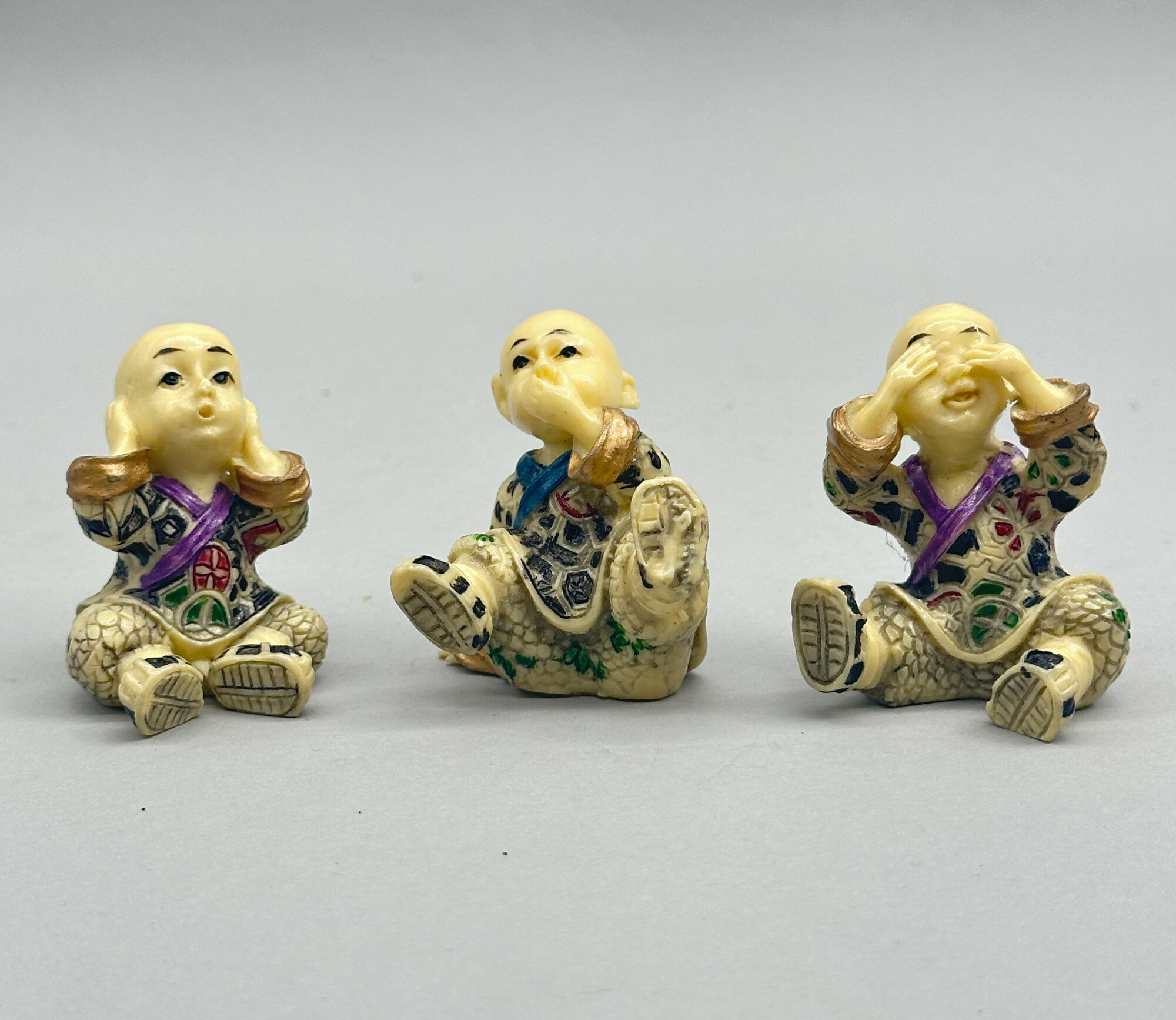
Set of Three Celluloid Figures of Monks, Japanese, first half C20th
Price: £45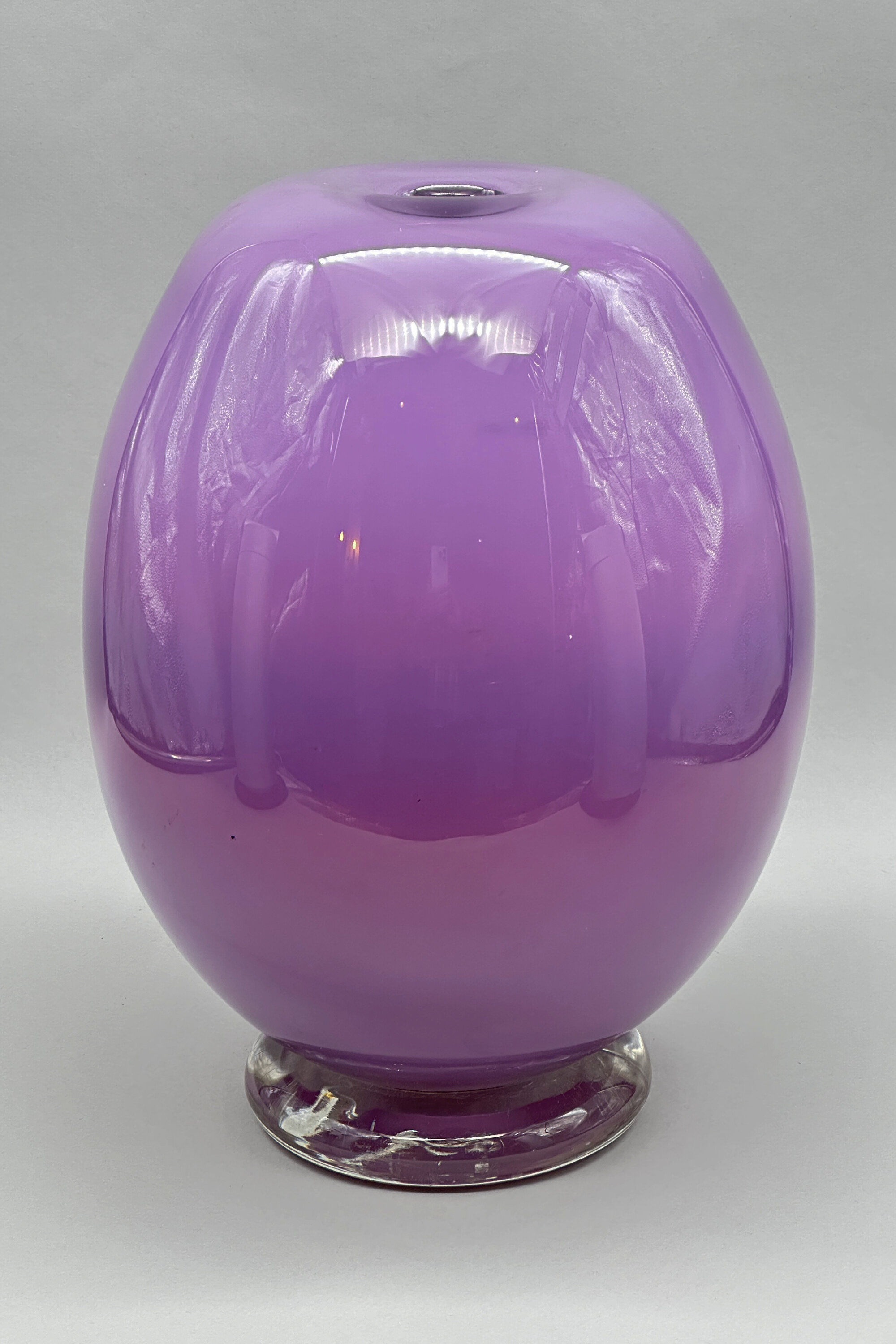
Purple Art Glass Vase by Anthony Stern, late C20th
Price: £150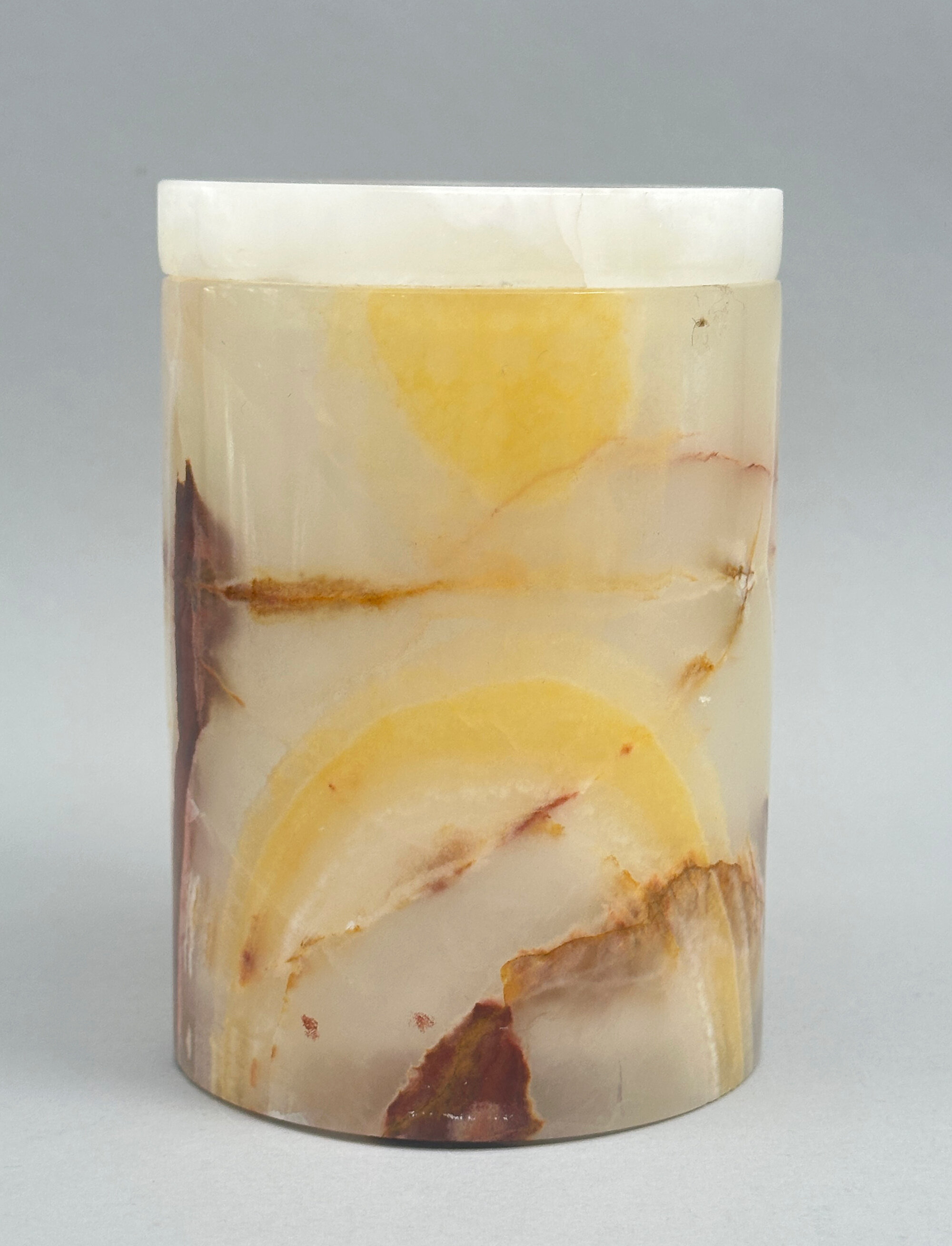
Tubular Onyx Box and Cover, 1960s
Price: £35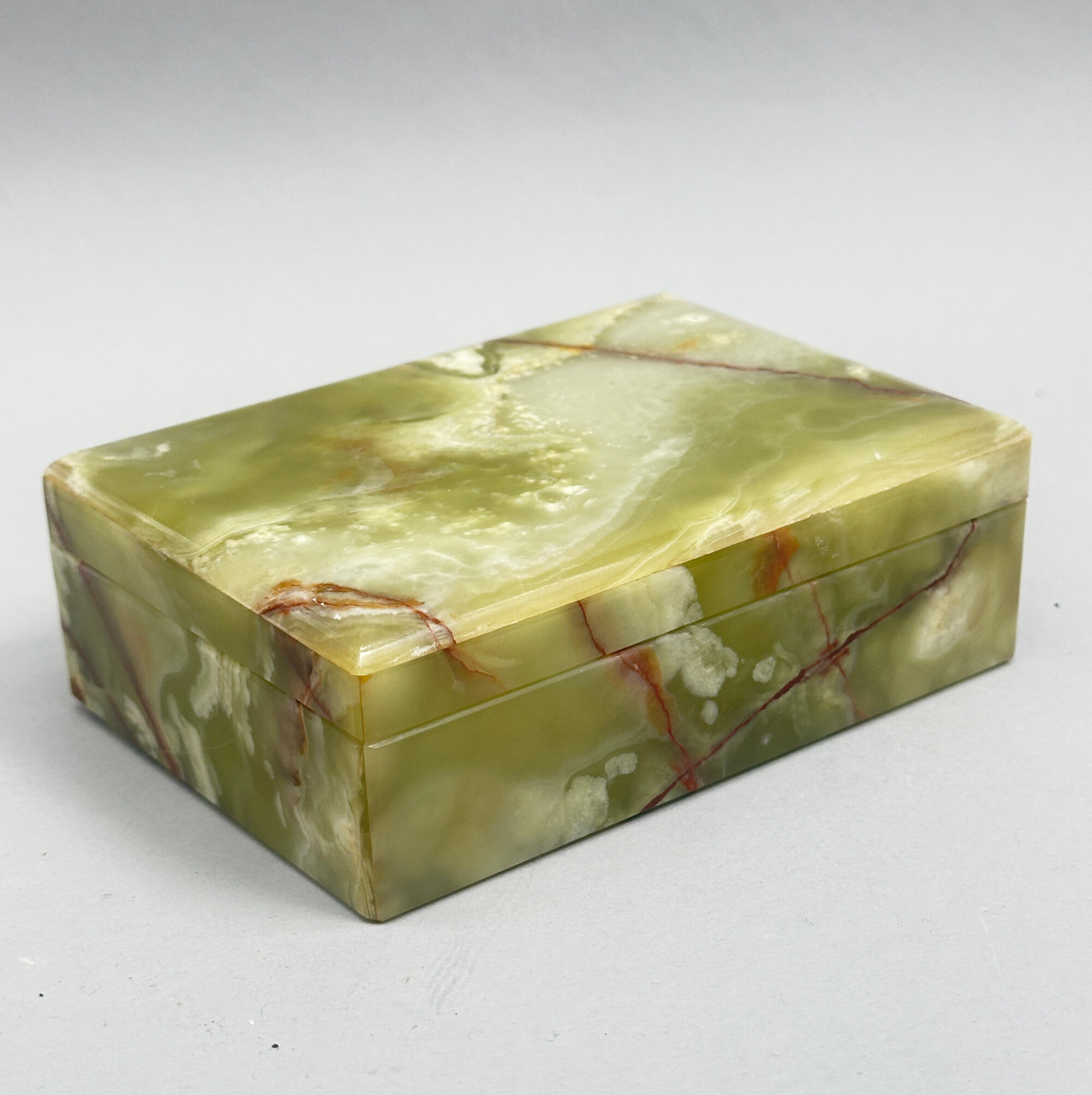
Rectangular Green Onyx Box and Cover, 1960s
Price: £35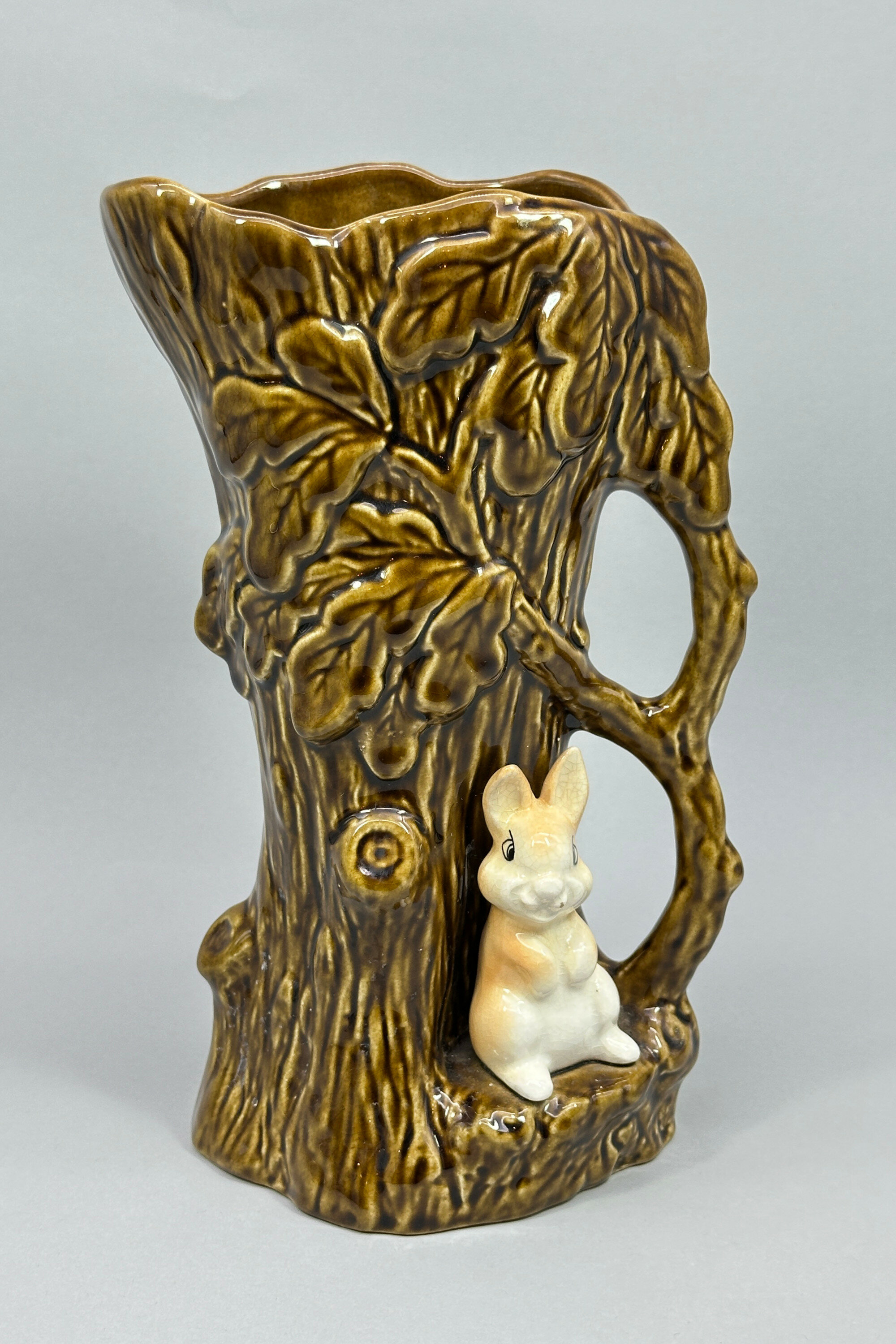
Sylvac woodland range Rabbit and Tree Jug, 1950s
Price: £35‘SylvaC’ (the name was written with a capital ‘C’ after registration of the trademark in 1938) was a trade name of Shaw and Copestake, a company formed by Mr. William Shaw and a Mr. Copestake around 1900. Mr. Copestake sold his shares to a Mr. Richard Hull after about six months of business and this partnership continued until Mr. Hull’s death in 1935. He was succeeded by his son, Mr. Richard Hull junior. In the following year, the business became a limited company. Various mergers and acquisitions followed and in the 1950s new premises were built and production expanded considerably continuing until the early 1980s when changing markets and increased competition forced the company into liquidation.
Sylvac were famous for imaginative glazed wares, particularly animals, and this jug is a typical and pleasing example of their work.
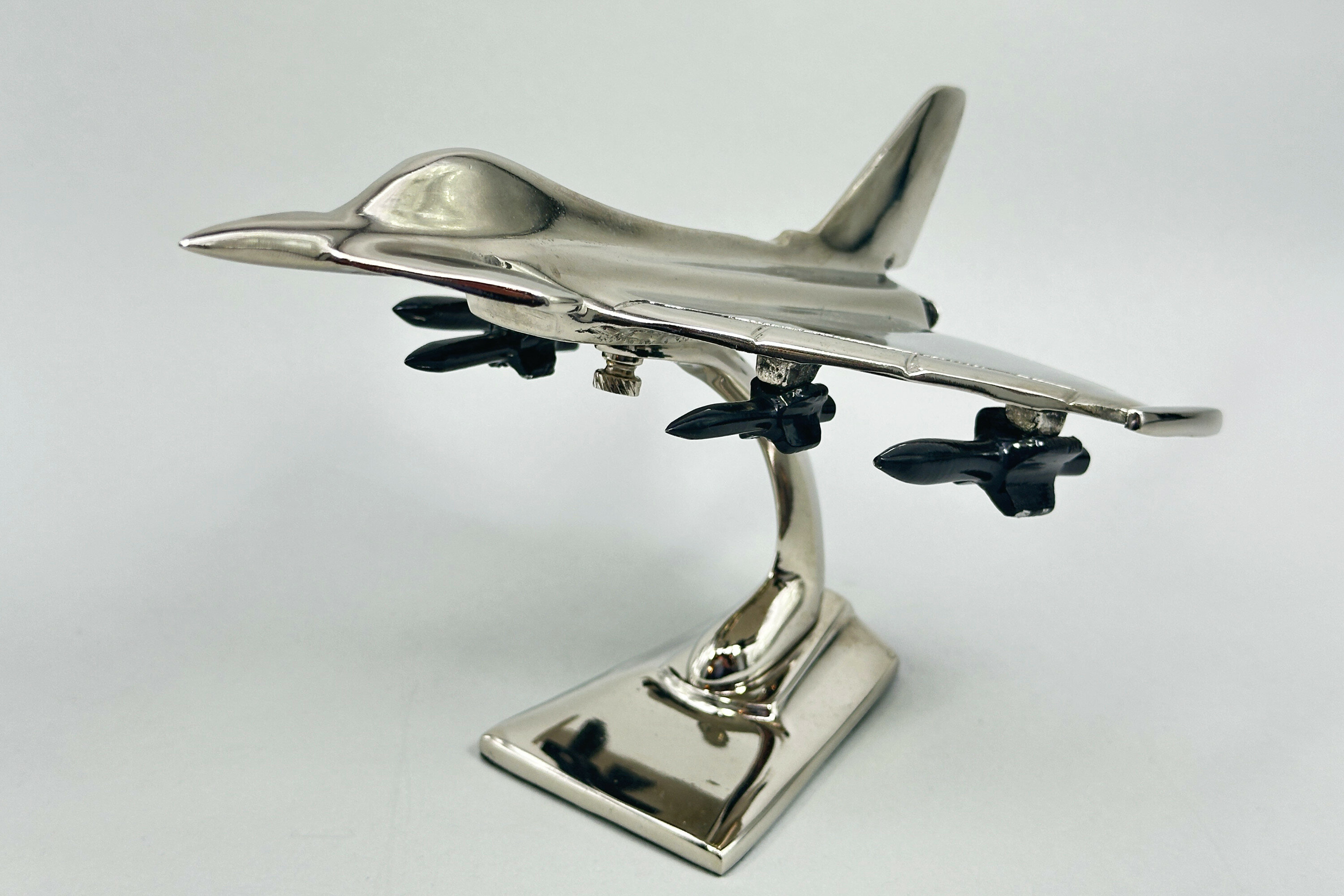
Desktop Model of a Typhoon Bomber Plane, Modern
Price: £45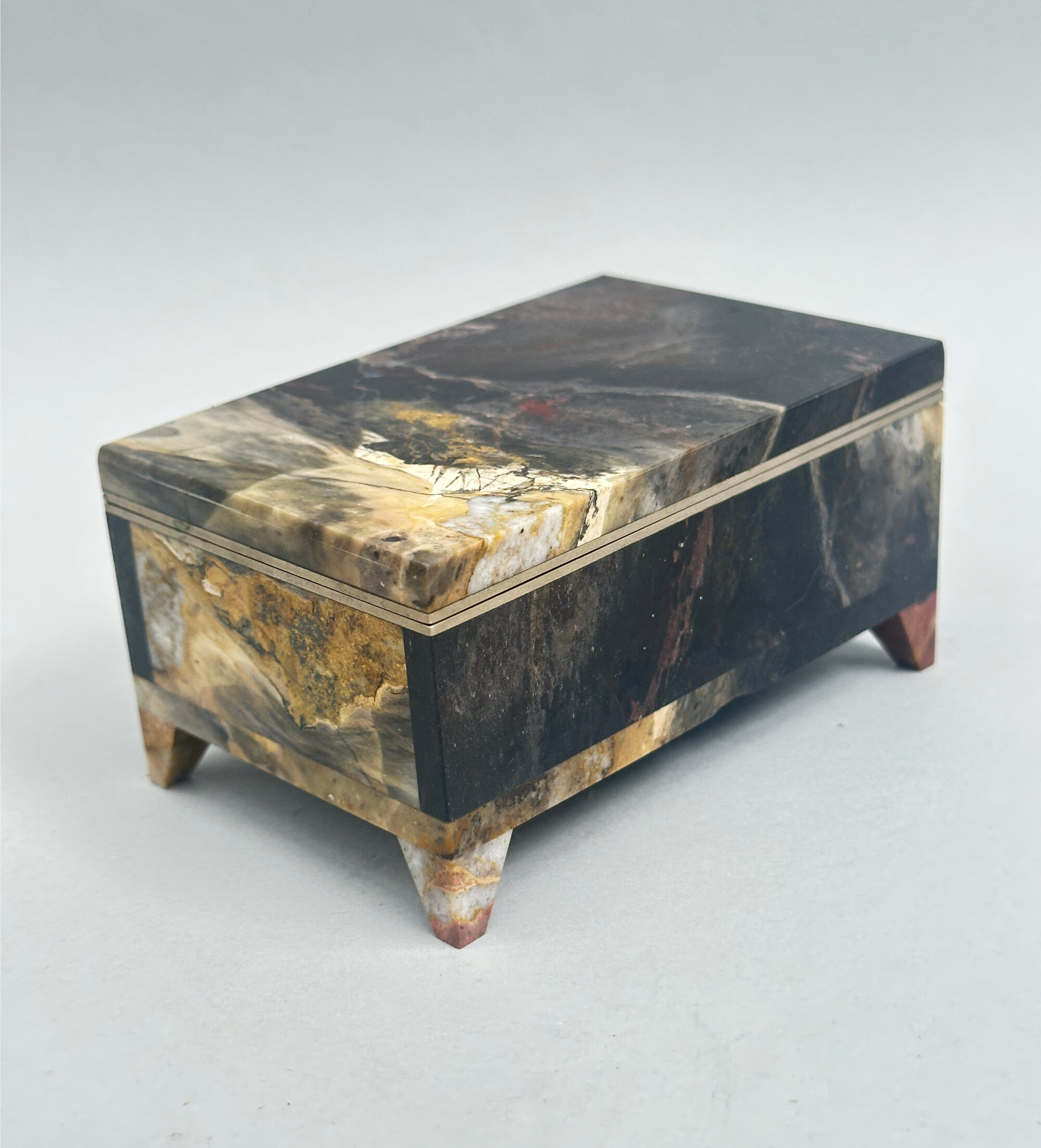
Rectangular Box and Cover, Basanite Jasper, C20th
Price: £95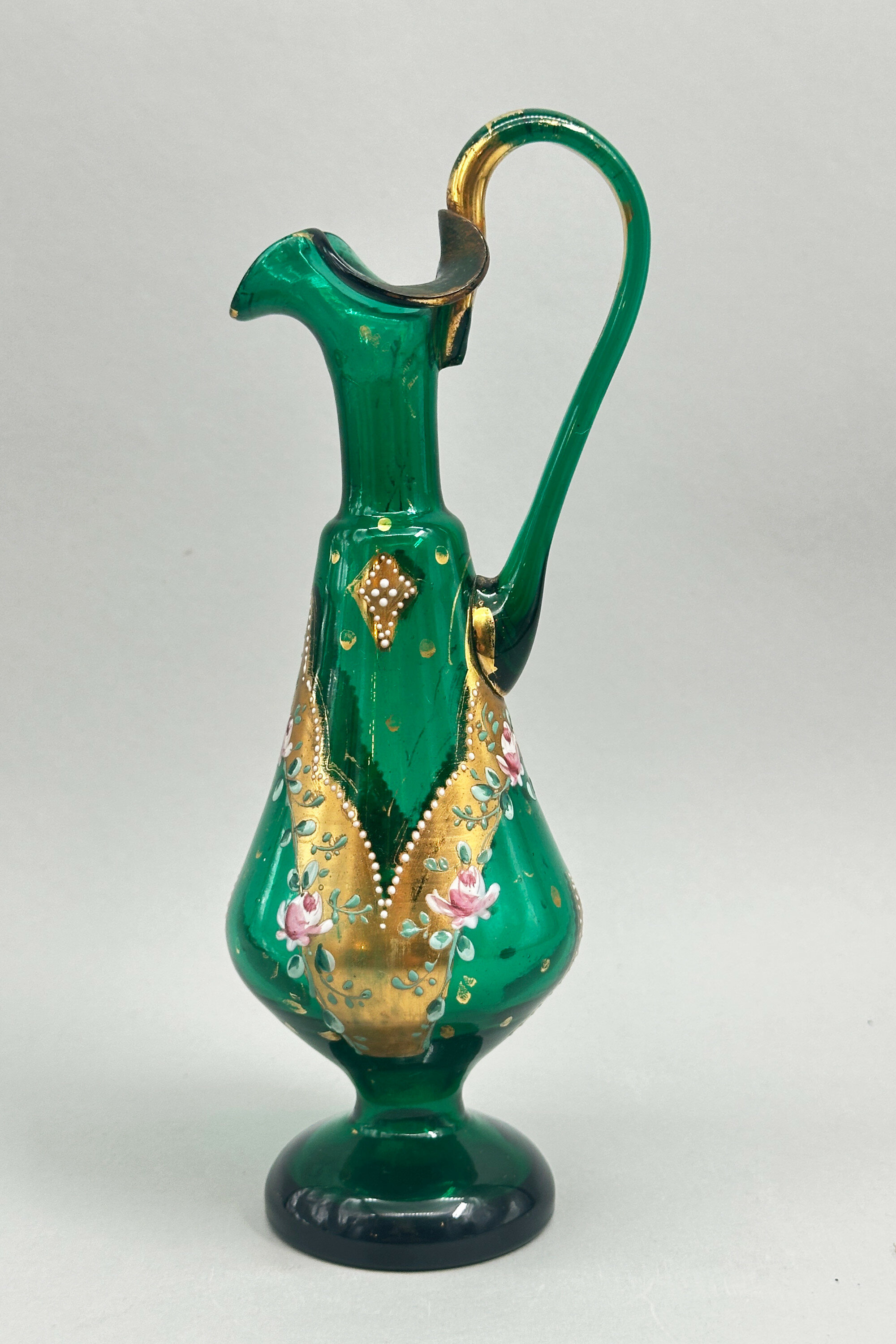
Bohemian Green Glass Moser style Ewer, late C19th
Price: £35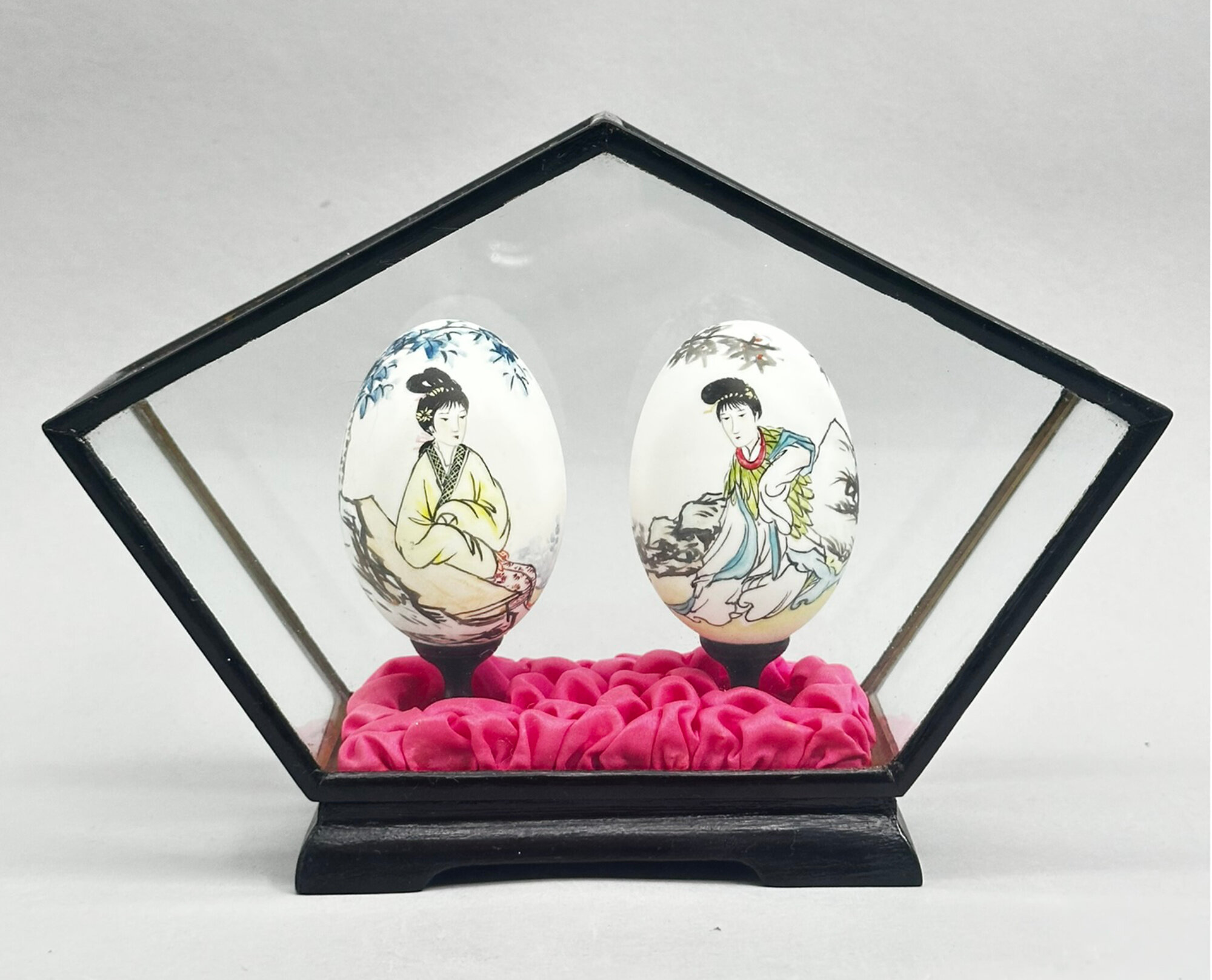
Pair of Chinese Hand Painted Eggs in Case, 1970s
Price: £25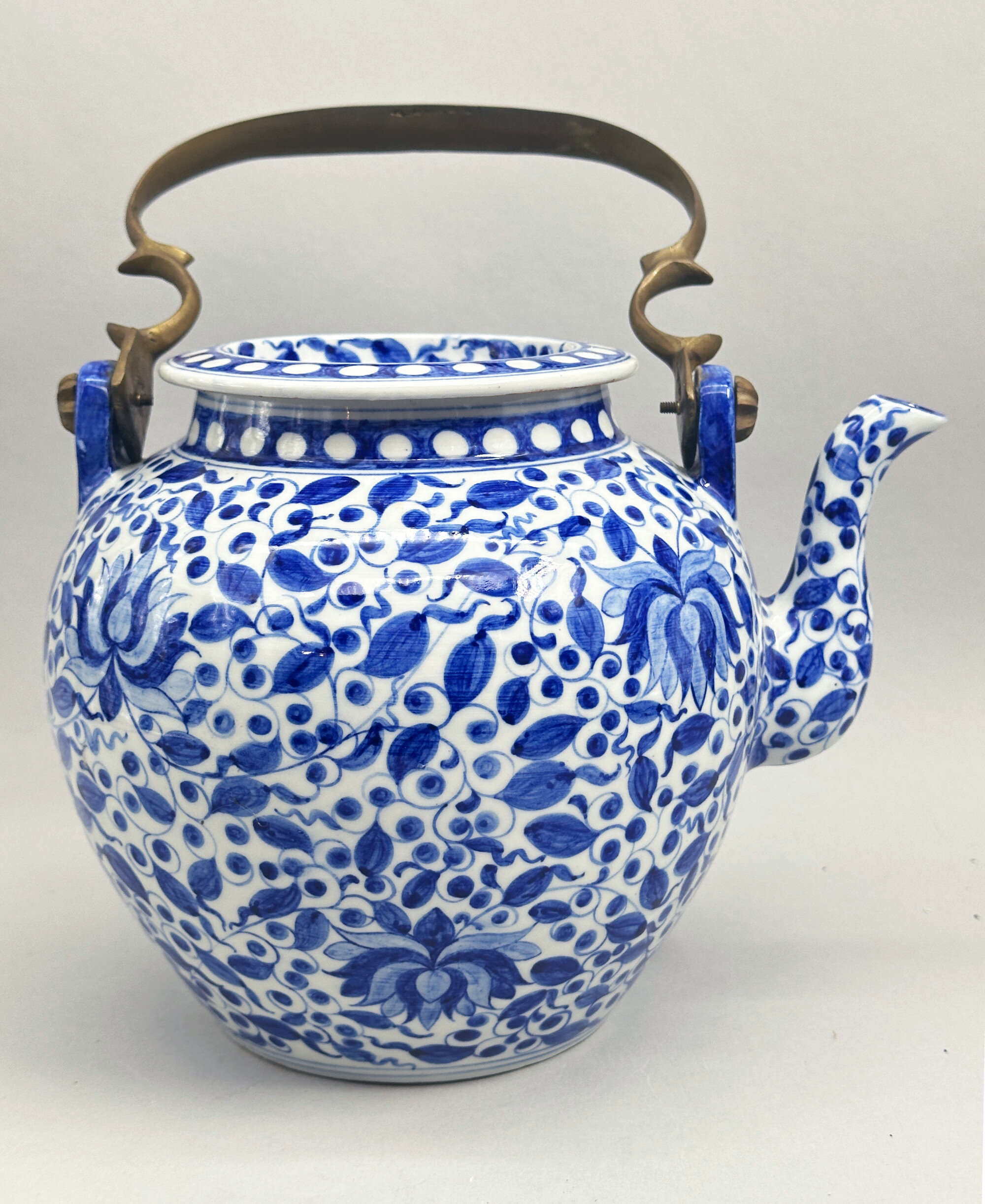
Exceptionally large Chinese Blue and White Teapot with metal handle, C19th
Price: £350The form here, without a ceramic handle but with an attached carrying handle, suggests a travelling teapot, a well known variation of the teapot type produced in China but rarely found on such an epic scale. Presumably this piece was intended for use at a rather large gathering or banquet so that a multitude of guests could be served at once! The paste of the footrim, style of decoration and clearly visible hand thrown potting rings (see images 8 and 9) all point to late nineteenth century work which is confirmed by the minute vertical lines seen on the exterior which are often found on blue and white pieces from that period. It is sometimes suggested that these brass handles, for similar examples can be found, were made in Thailand but there is little evidence for this. However, a local audience rather than an international one seems more than likely since there would have been little call for such a serving item in Western homes.
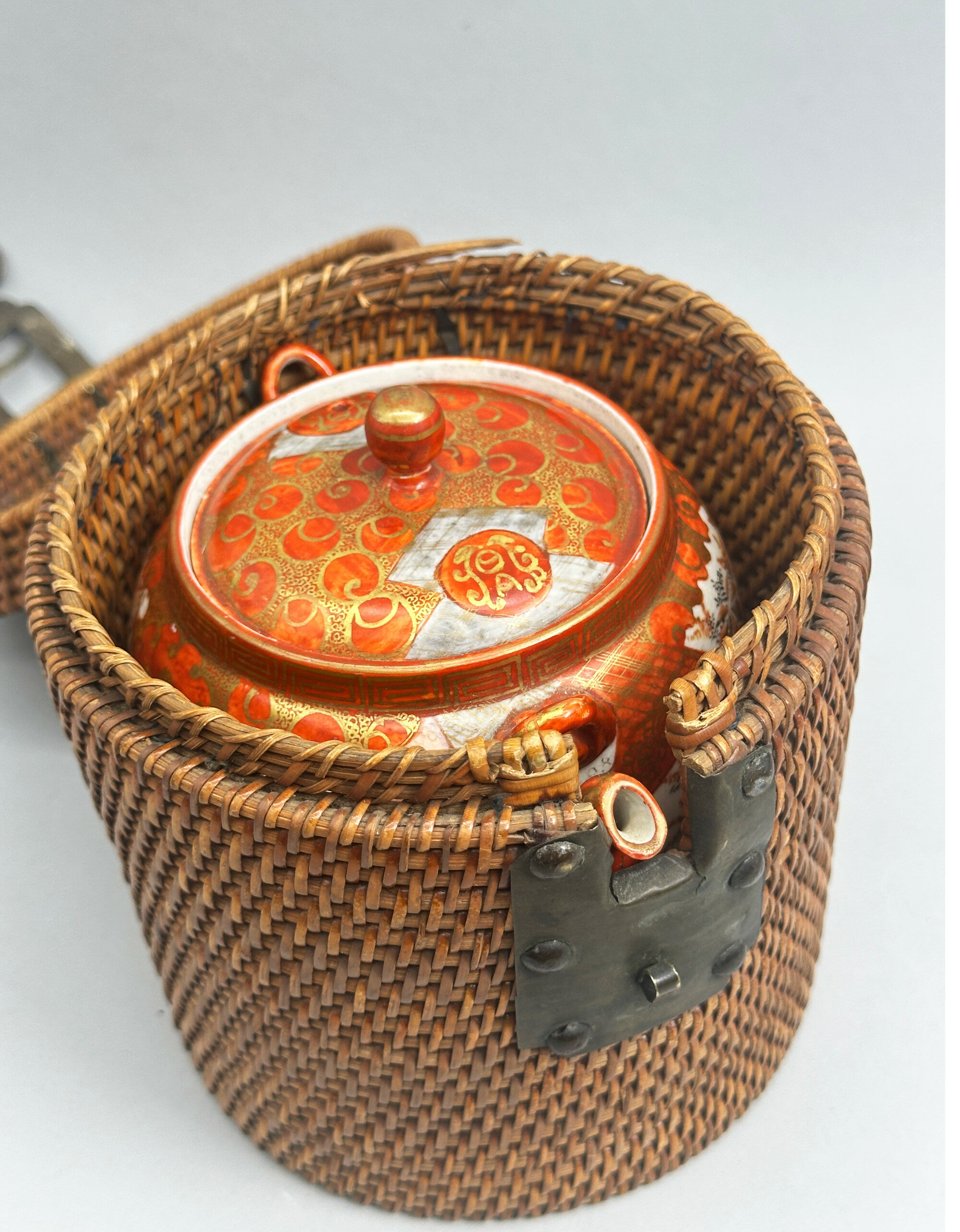
Japanese Kutani Teapot in a carrying Basket, circa 1900
Price: £45Kutani (the word means 'nine valleys') porcelain was made at various factories in the former Kaga province of Japan. The earliest pieces were in a completely different style employing a palette of colours emphasising green, the so called 'Ko Kutani'. Production of this ceased around 1730, and manufacturing was not revived until the early nineteenth century when the more familiar colourings of iron red and gold were introduced. Vases, bowls and plaques are found in this style but also teapots of which this is a typical example. The decoration is of birds and flowers on a faintly craquelure glaze ground and the lid has a complementary ‘brocade pattern’ design. The base has a two character mark reading ‘ku’ ‘tani’ as is often found. The basket is of tightly woven wicker with the metal fitments as described and is probably Chinese in common with many similar examples, although the Japanese did, of course, have a basket weaving tradition of their own. Slight damage means that the ensemble has to be of decorative value rather than practical use but it remains an interesting and entertaining souvenir item from the orient.
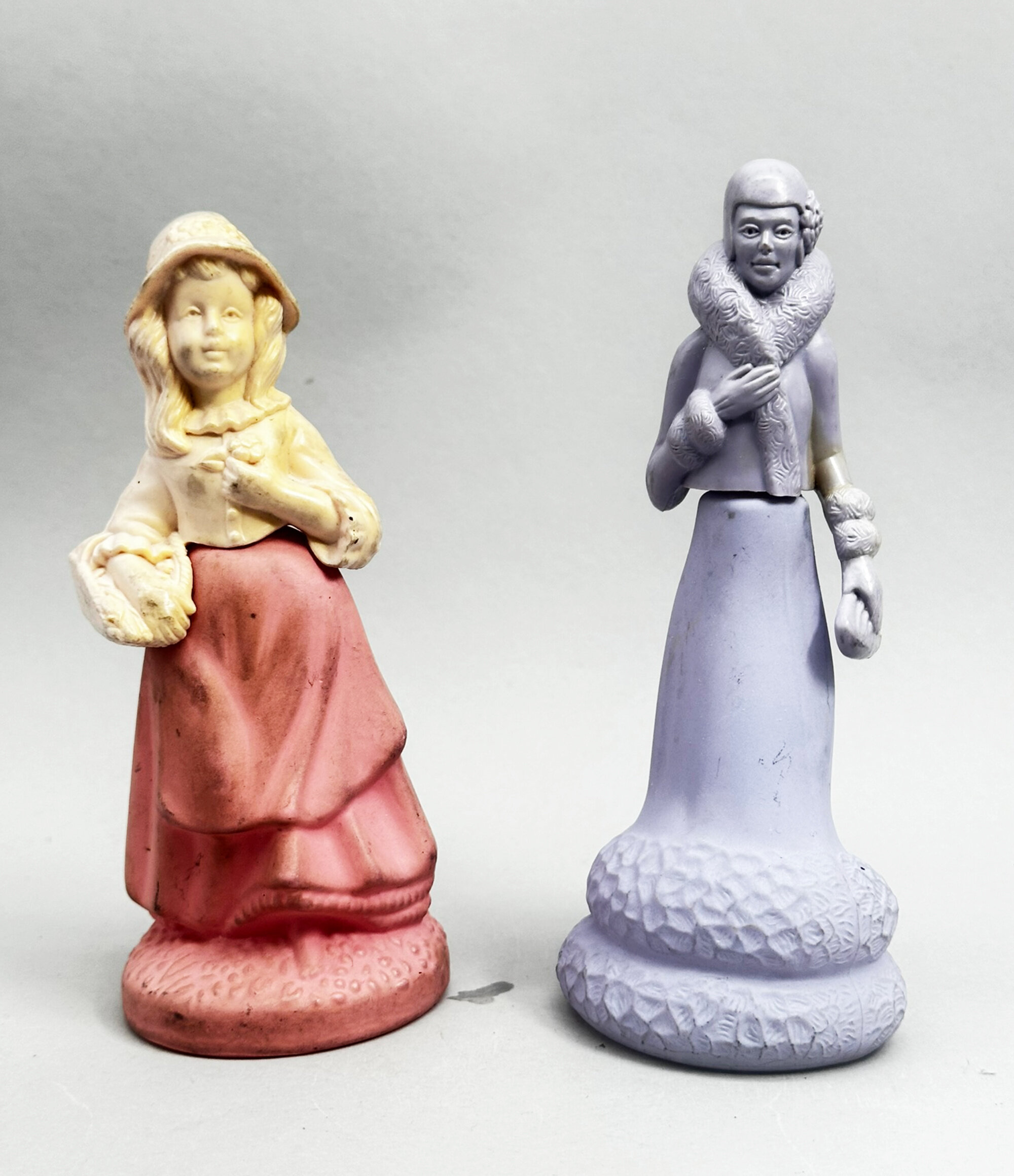
Two Avon Perfume Bottles, Lady and a Girl, 1970s
Price: £20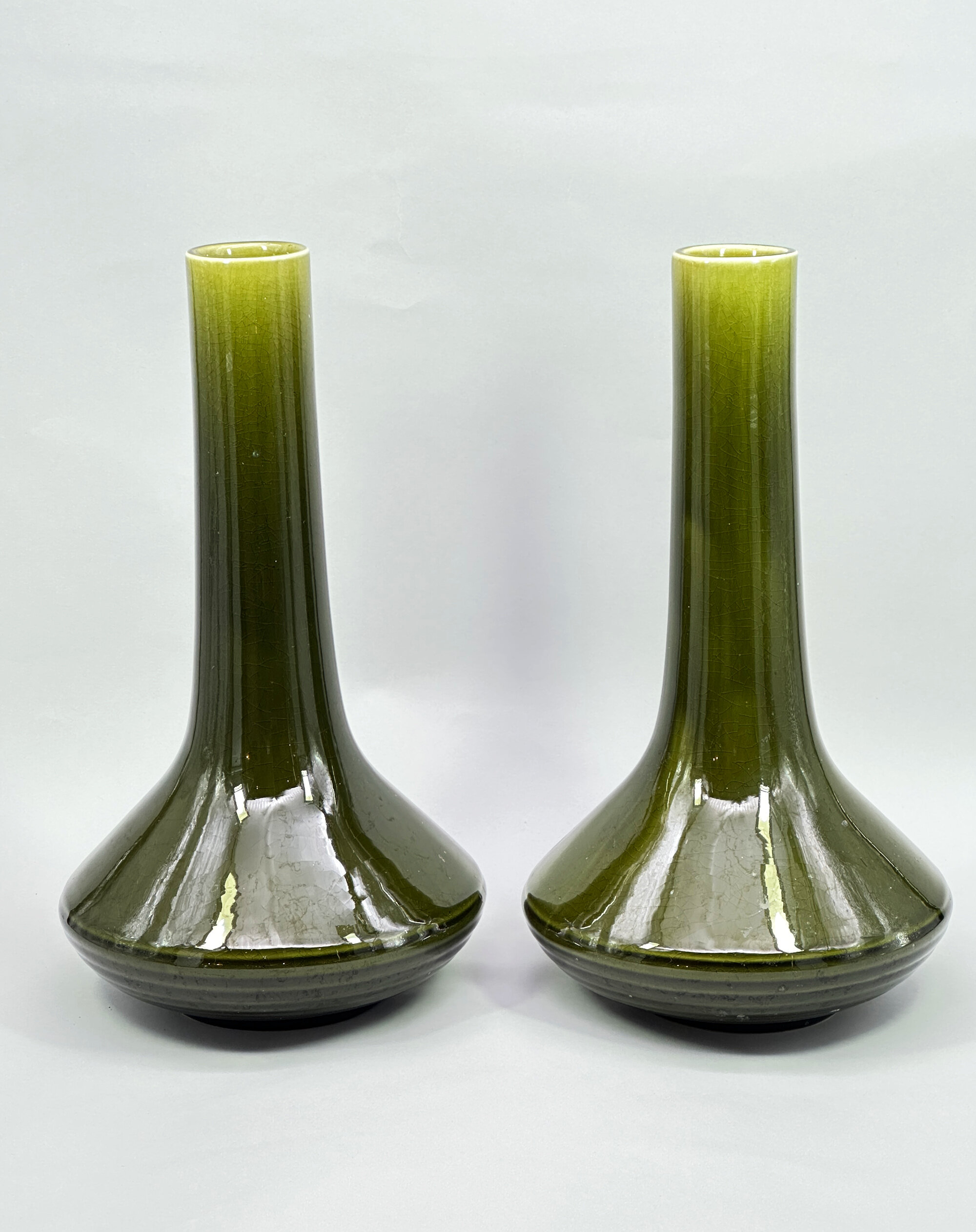
Pair of Green Glazed Bottle Vases, possibly French C20th
Price: £180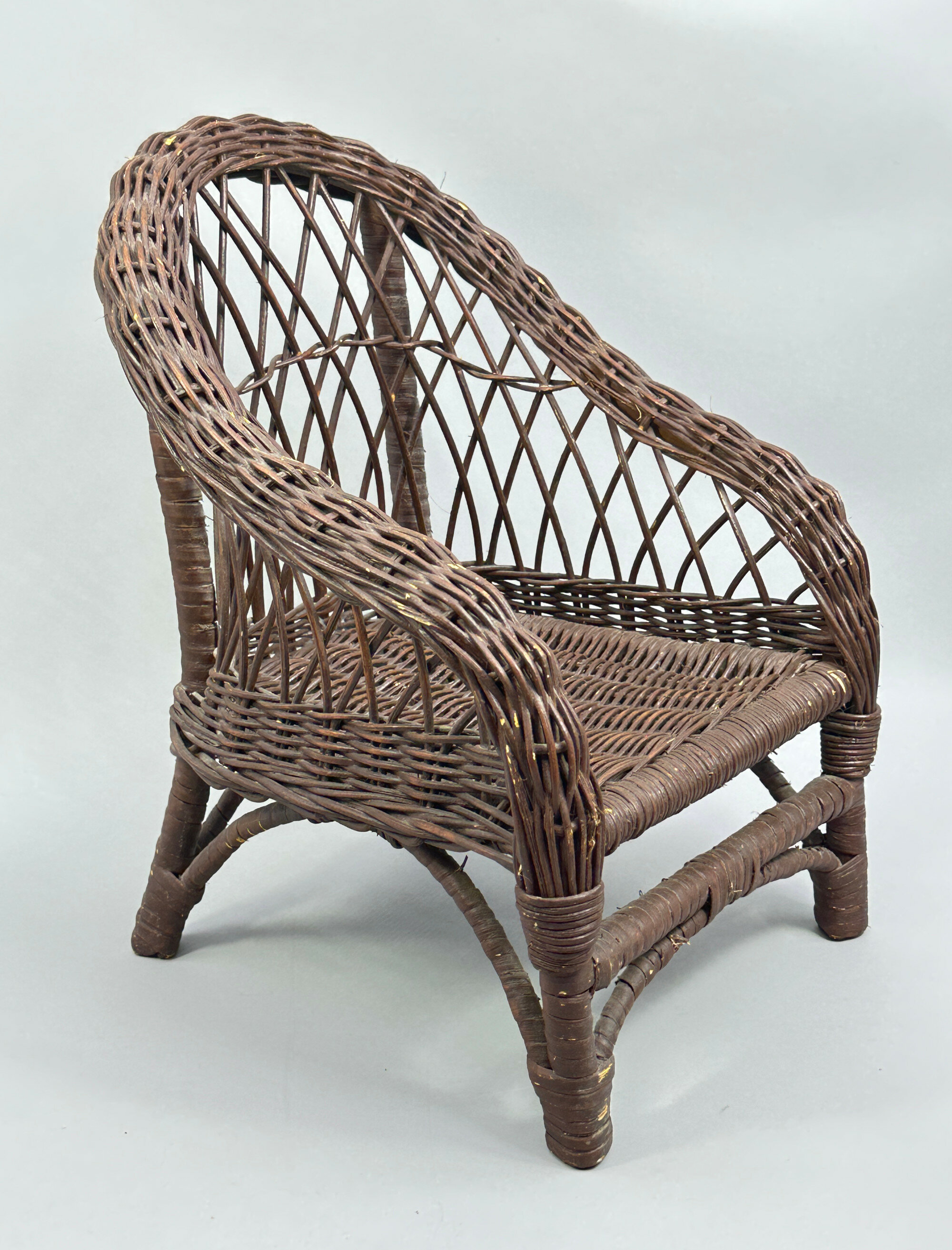
Toy Wicker Chair, mid C20th
Price: £35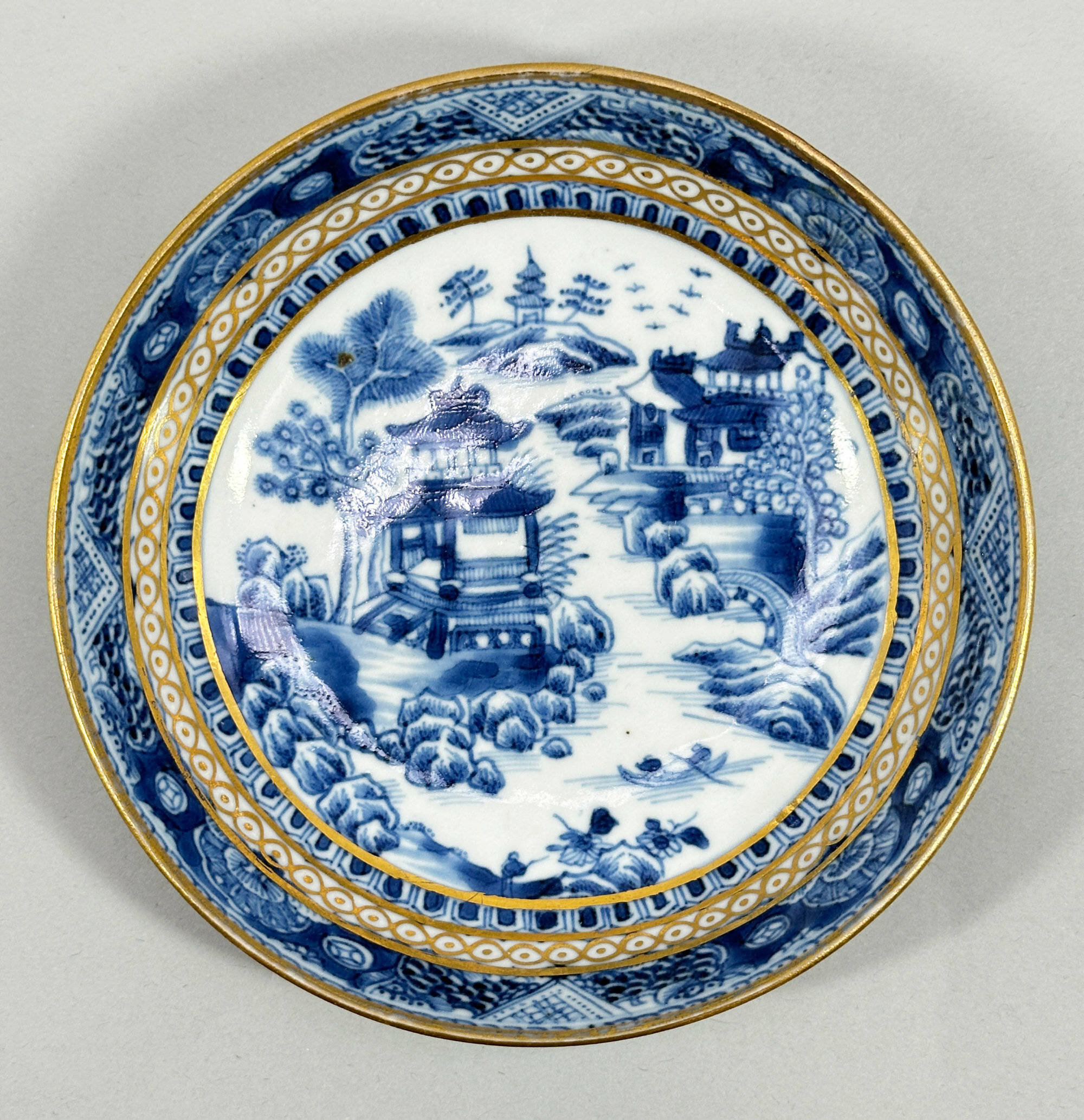
Chinese Export Nanking Pattern Saucer, Qianlong period (1736-1795)
Price: £75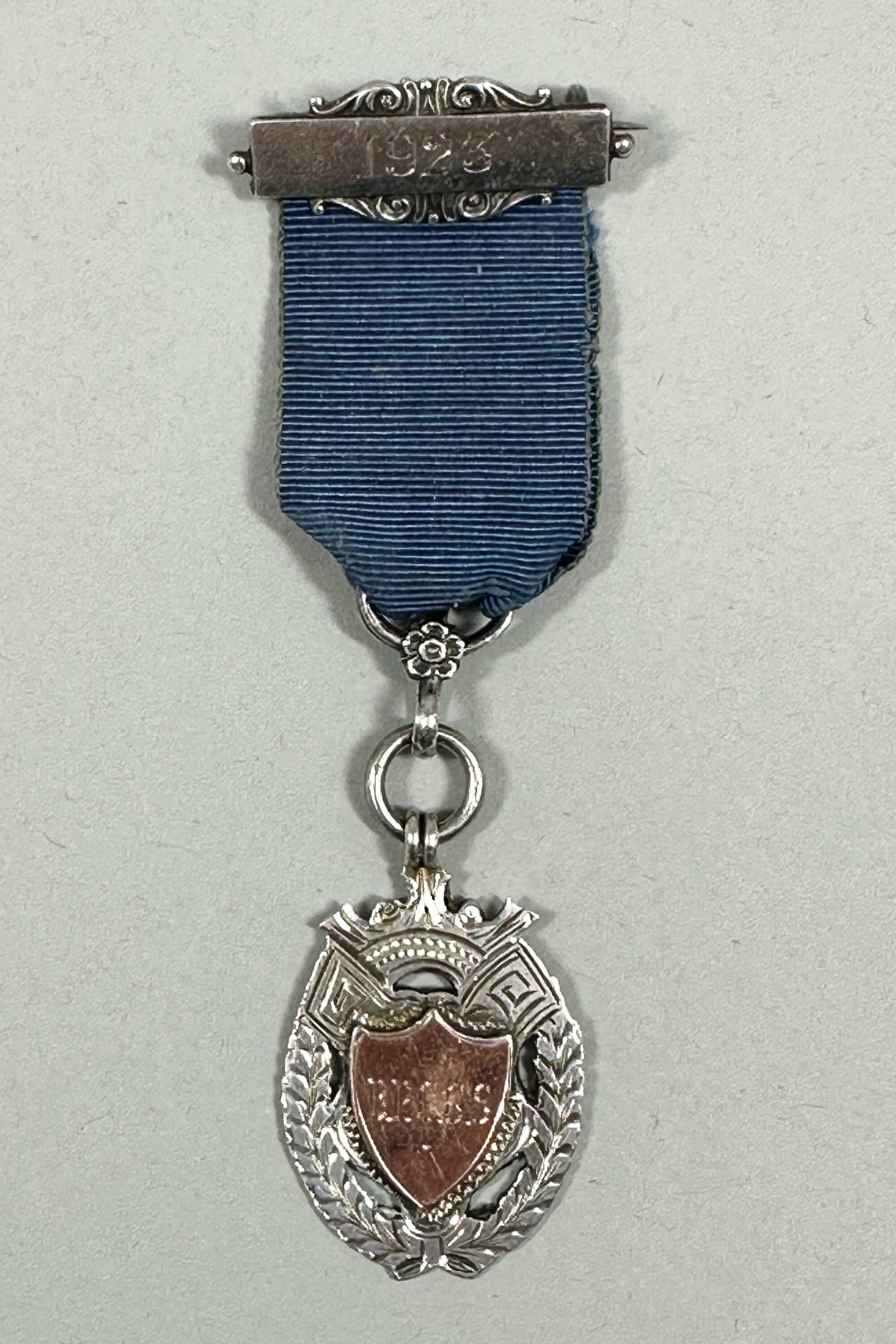
Silver Medal or Watch Fob dated 1923, B.P.C.G.S.
Price: £35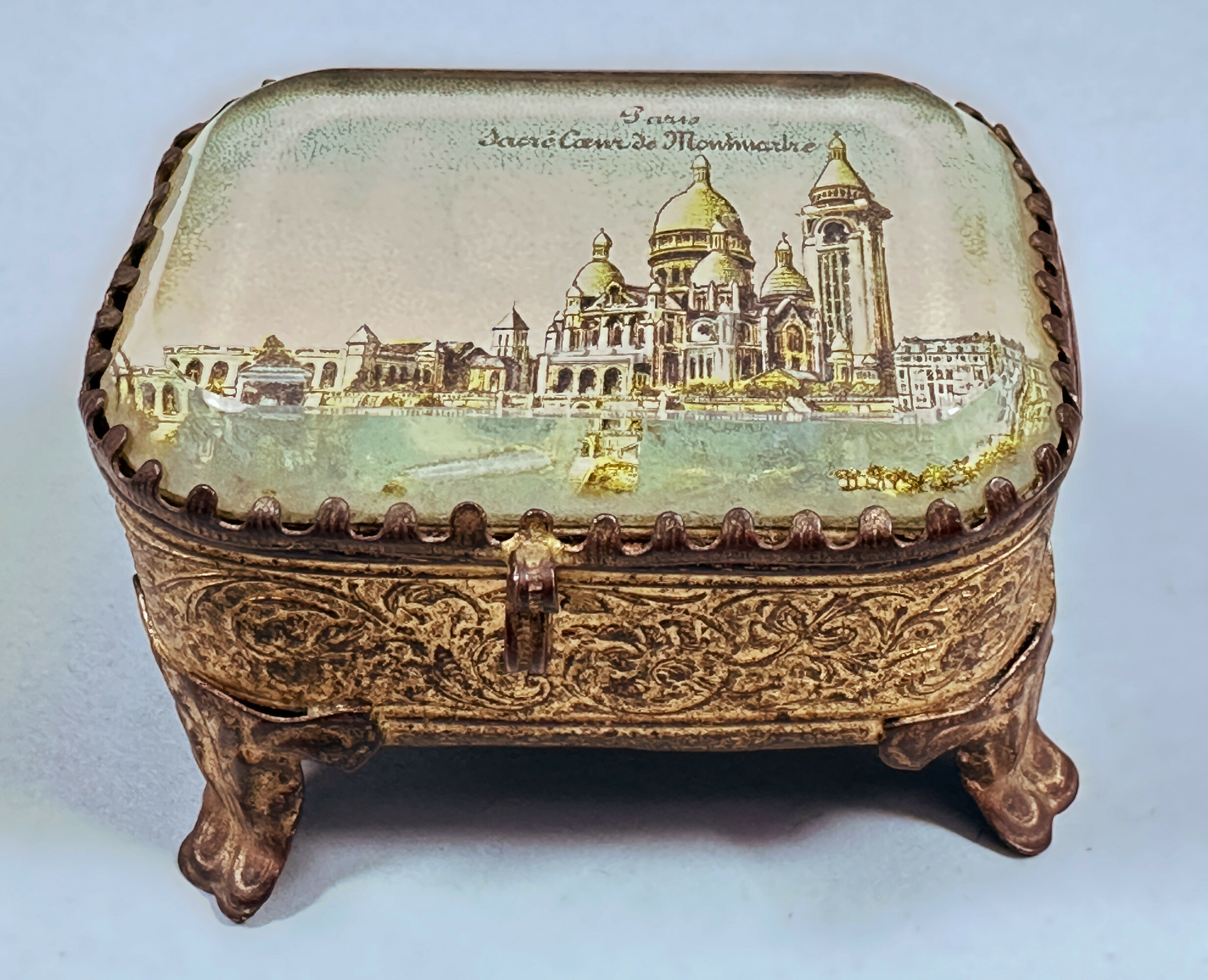
French Souvenir Verre Eglomise Box and Cover, Sacre Coeur de Montmatre, circa 1900
Price: £55
French Souvenir Verre Eglomise Box and Cover, Sacre Coeur de Montmatre, circa 1900
Price: £55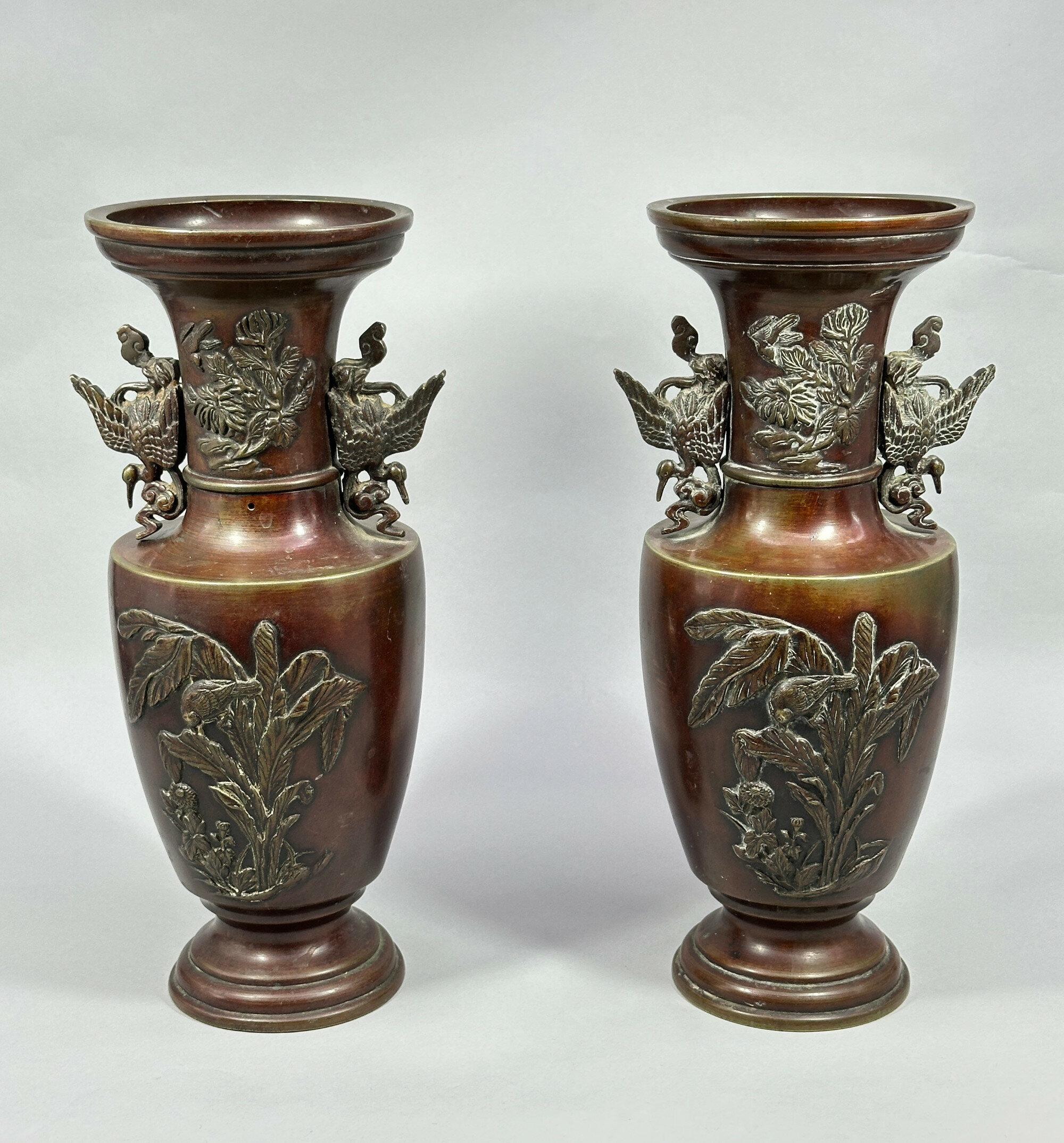
Pair of fine quality Japanese Bronze Vases decorated birds, circa 1880
Price: £220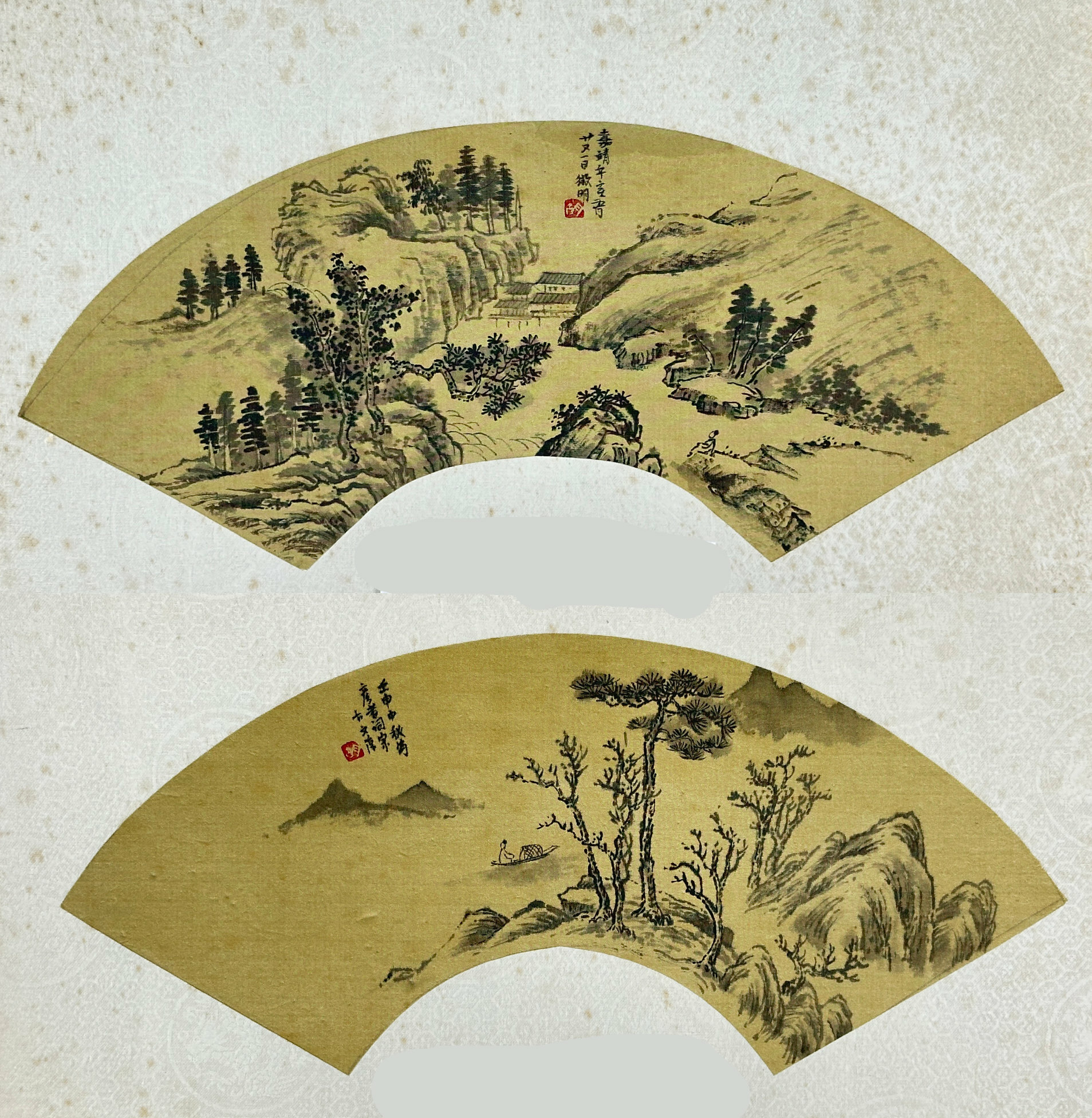
Two Chinese folding Fan Leaves with landscape scenes, now mounted, C20th
Price: £25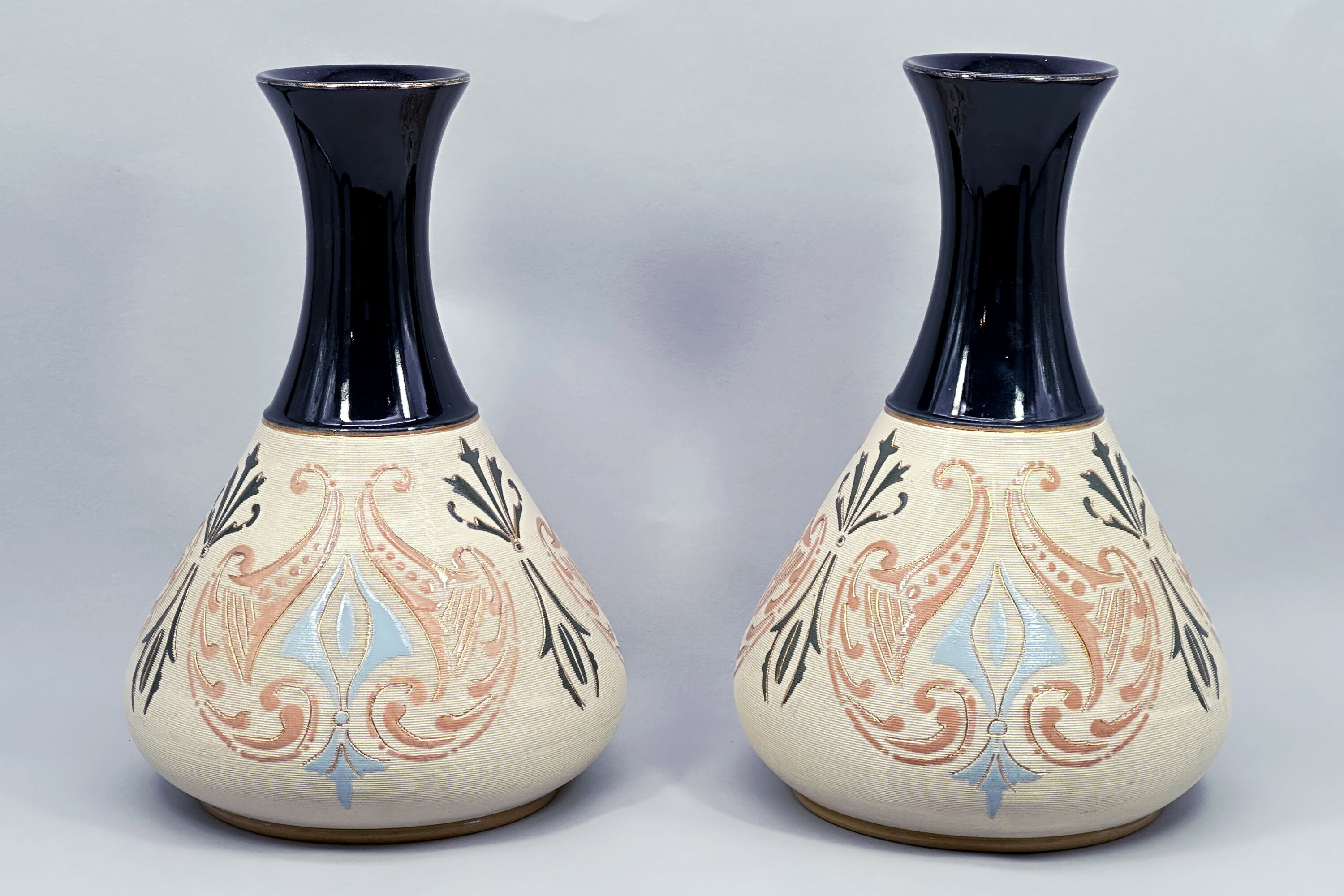
Pair of Lovatt and Lovatt Earthenware Vases, early C20th
Price: £95The Langley Mill Pottery was located in Langley Mill, Derbyshire on the Derbyshire – Nottinghamshire border. From its establishment in 1865 to its final closure in 1982, it went through five distinct periods of ownership, producing a wide range of stoneware ranging from utilitarian items and to high quality art pottery. This pair of vases dates from the third company that traded there, Lovatt and Lovatt. The Lovatt family had entered into partnership with the owner of the founding business at Langley Mill, James Calvert. From 1895 the business was in sole control of the Lovatt family and traded as ‘Lovatt and Lovatt’ until 1935. The early years of the twentieth century proved to be something of a zenith for them and a wide range of art pottery pieces were made which enjoyed great popularity. Production techniques were streamlined without a reduction in quality and in 1905, leadless glazes were introduced. These are proudly announced on the base of this pair of vases which are a fine example of the Lovatt and Lovatt style and probably date to 1913, indicated by the impressed numbers for that year.
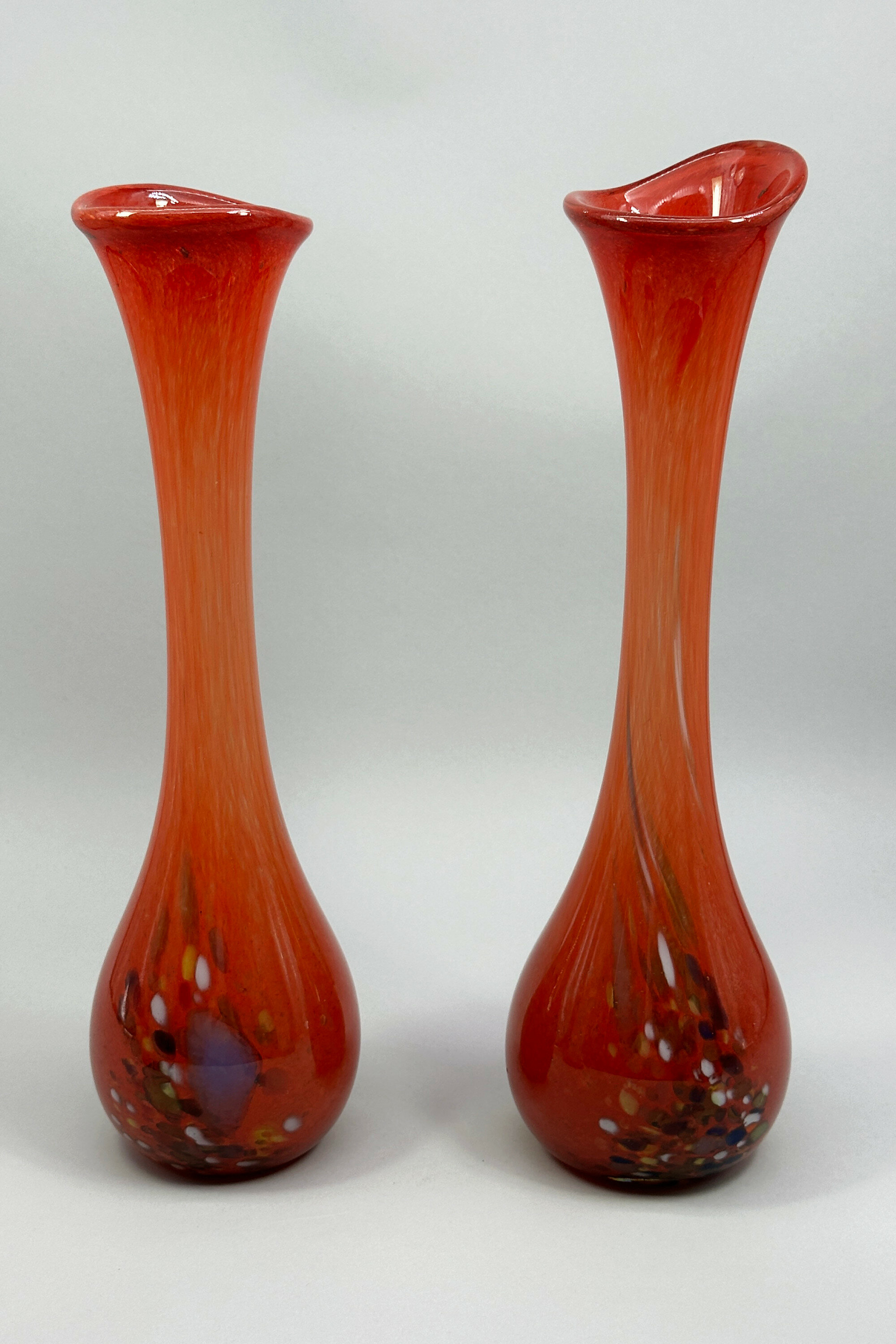
Pair of slender red glass bottle Vases, probably Joska Kristall, Germany, late C20th
Price: £85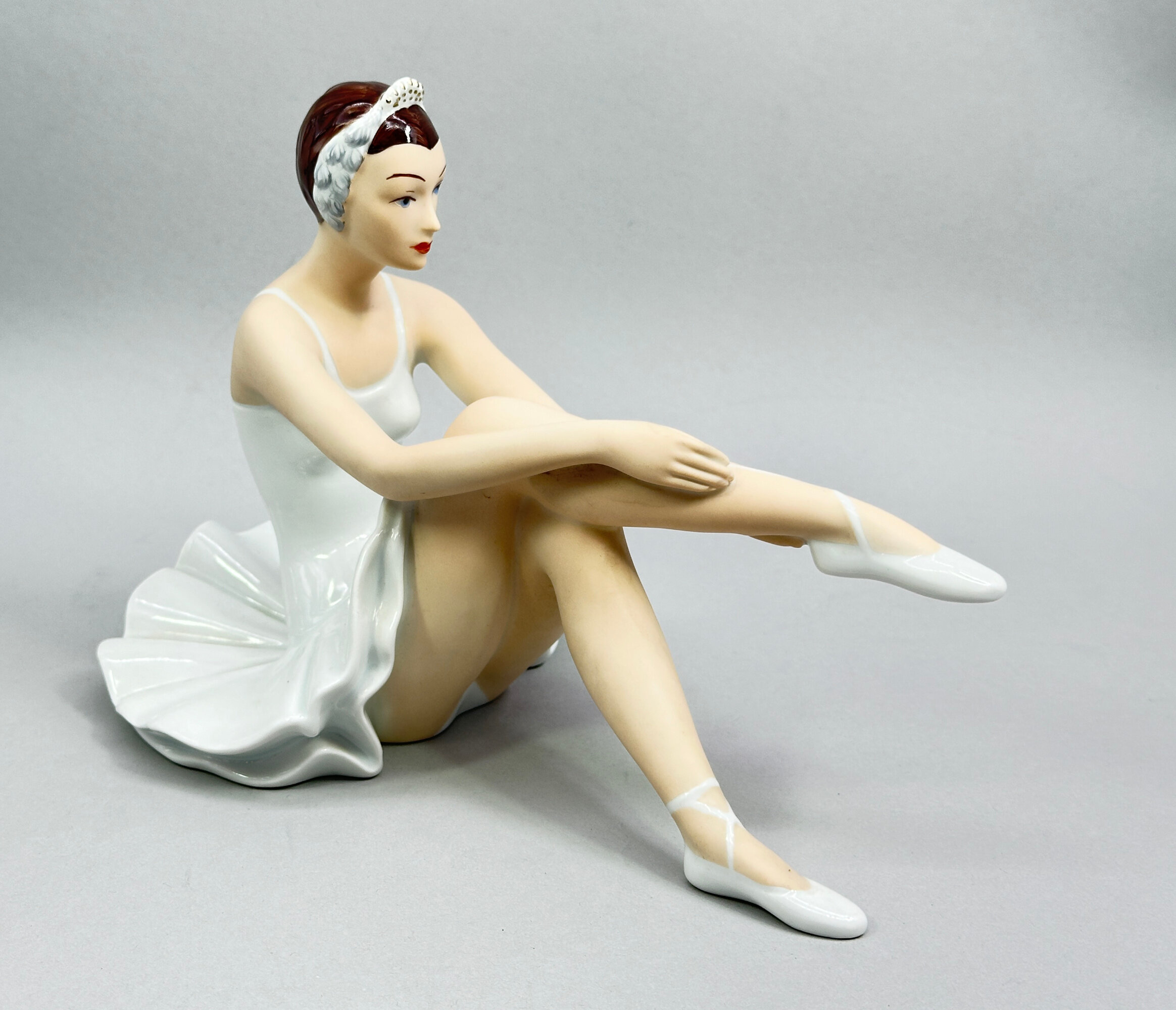
Figure of a Seated Ballerina, Royal Dux, late C20th
Price: £75Duxer Porzellanmanufaktur, or the Dux Porcelain Manufactory, was started in 1860 by Eduard Eichler in what was then Duchov, Bohemia, later to become part of Czechoslovakia. Production was to continue until the beginning of the second world war and beyond and their later pieces are now generally referred to by the abbreviated name, ‘Royal Dux’. The distinctive pink triangle plaque mark was first used in the late nineteenth century but appears on pieces from all dates, the version found here indicating late twentieth century work which is also confirmed by the rather indistinct stamped mark comprising a triangle surrounded by the wording ‘Hand Painted Made in Czech Republic’. The artist is named as ‘V.David’ and there seem to be two other companion pieces in different poses. The quality is quite excellent and explains the original popularity of the firm when it began manufacturing in the nineteenth century and produced highly successful imitations of its contemporary rivals.

Art Deco style Ceramic Bowl and Cover by Louis Dage (1885-1961), early/mid C20th
Price: £180……………………………………………………………………………………....................................................................................……
Born in 1885 at Lille, France, Louis Dage was early known as a ceramics artist, describing himself on the birth registration of his daughter in 1906 as a ‘decorator on faience’. In 1920 he joined with Louis Fontinelle (1886-1964) to create a faience factory in Antony, near Paris, but the venture was short lived and they parted company two years later. In 1930, Dage set up his own studio at Saint-Sever in company with his brother and daughter becoming managing director of the firm three years later. There then followed a little over thirty years of production under his direction until his death in 1961. Art Deco designs with their simple lines and bold decoration were produced initially to be followed by pieces of more rugged shapes and patterns, partly resulting from the shortage of conventional raw materials during the second world war.
This bowl and cover represents the best of Dage’s earlier work. The base has straight sides curving in slightly towards the base and has a flush fitting flat and gently domed cover overhanging slightly at the edge. The piece is covered overall with a mottled glaze in tones of blue and light aubergine on which are painted maple leaves in green with bright blue berries, a design which can be found on some of Dage’s other pieces (see image 13). The lid carries his signature ‘DAGE’ with a flowing line underneath, a much less common version of the Dage mark but which can be found elsewhere (see image 14). More normally pieces are signed ‘L.Dage’, the name being in lower case rather than capitals.Form and decoration combine to produce a striking object, characteristic of the fashions of the time of its production and a worthy tribute to its maker.
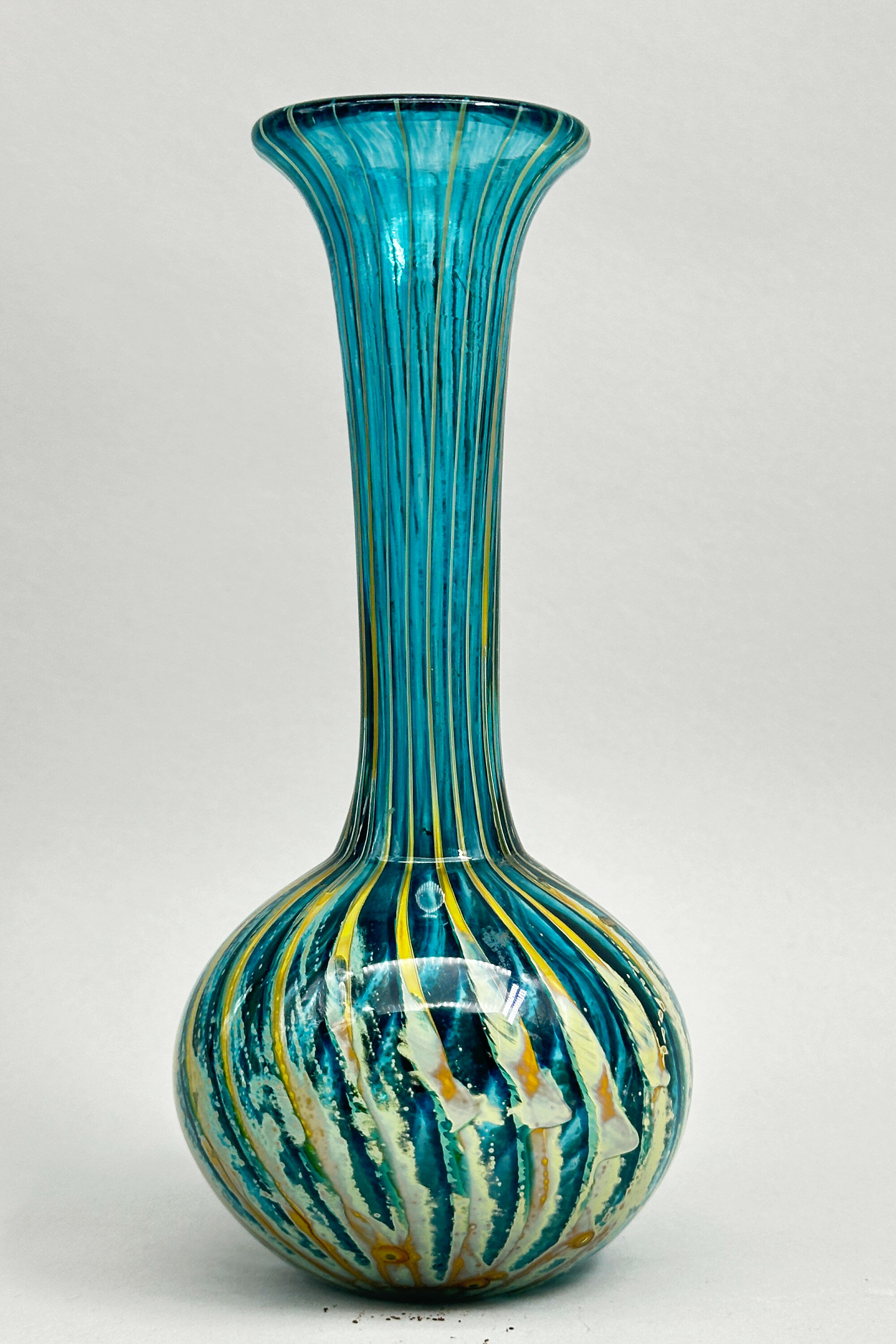
Phoenician Glass Vase, signed, late C20th
Price: £45Phoenician Glass was founded on Manoel Island, Malta in the 1980s by Leonard Sullivan, who had worked previously at Mdina Glass and many of his designs resembled those of his old employers. Certainly, the influence of Mdina and perhaps that of one of its founders, Michael Harris, can be seen here. Phoenician Glass took its name from the ancient Phoenician civilisation, which colonised Malta during the first millenium BC.
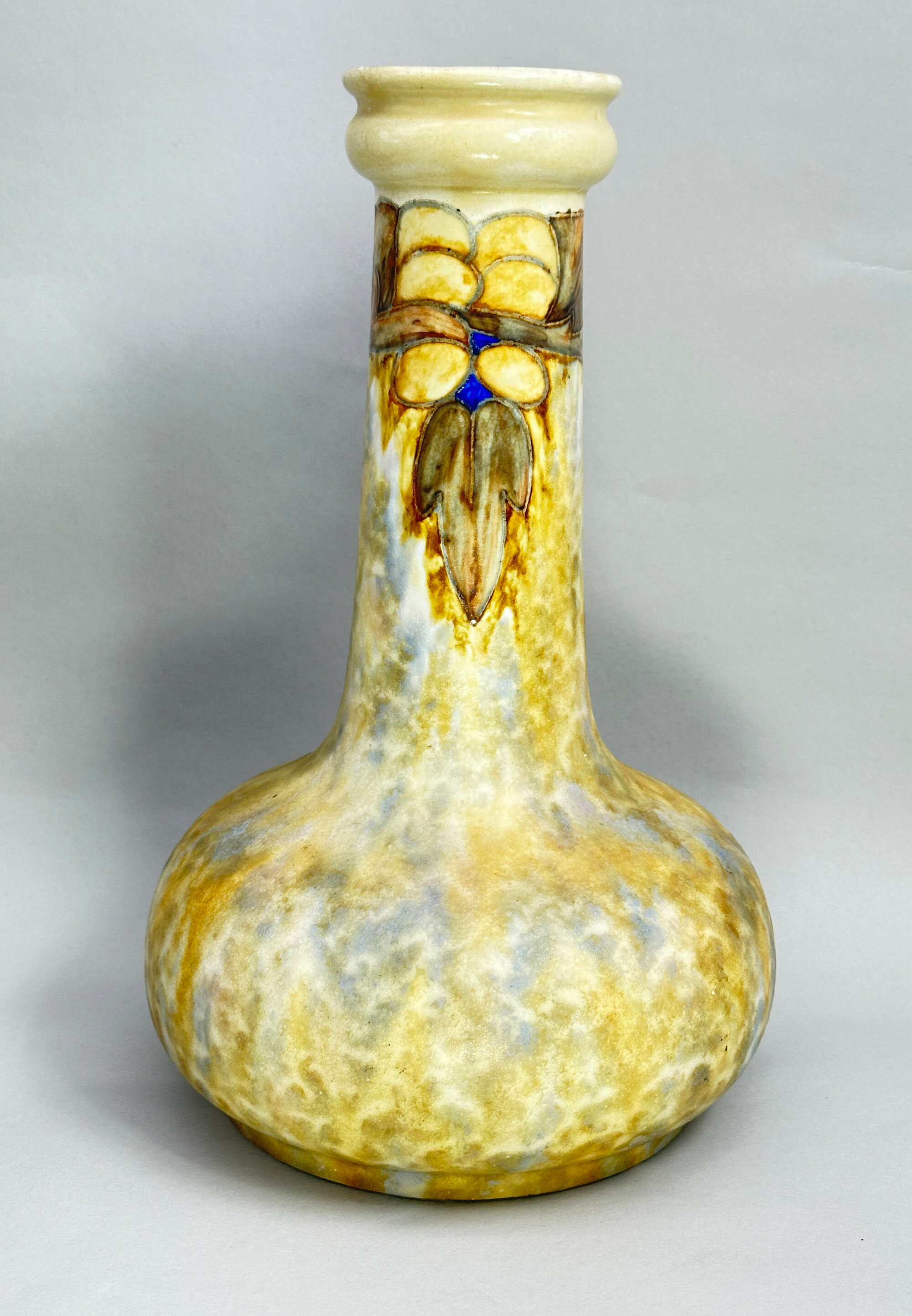
Cranston Ware Art Nouveau Style Vase, early C20th
Price: £95Cranston Ware was one of the ranges produced by the Pearl Pottery Company, based in Hanley, Stoke on Trent. Founded in 1892, the firm produced a varied selection of ceramic wares, often following contemporary fashions, until its closure in 1947. This vase is demonstrably in the Art Nouveau style and would have been produced when it was at its zenith in the early 1900s. The pattern was known as ‘Tukan’ ware and some of the pieces, but not all, have an impressed mark displaying this. This is an excellent example of the type with the glazes and decorative detail well rendered and certainly deserves the attention of collectors of Art Nouveau.
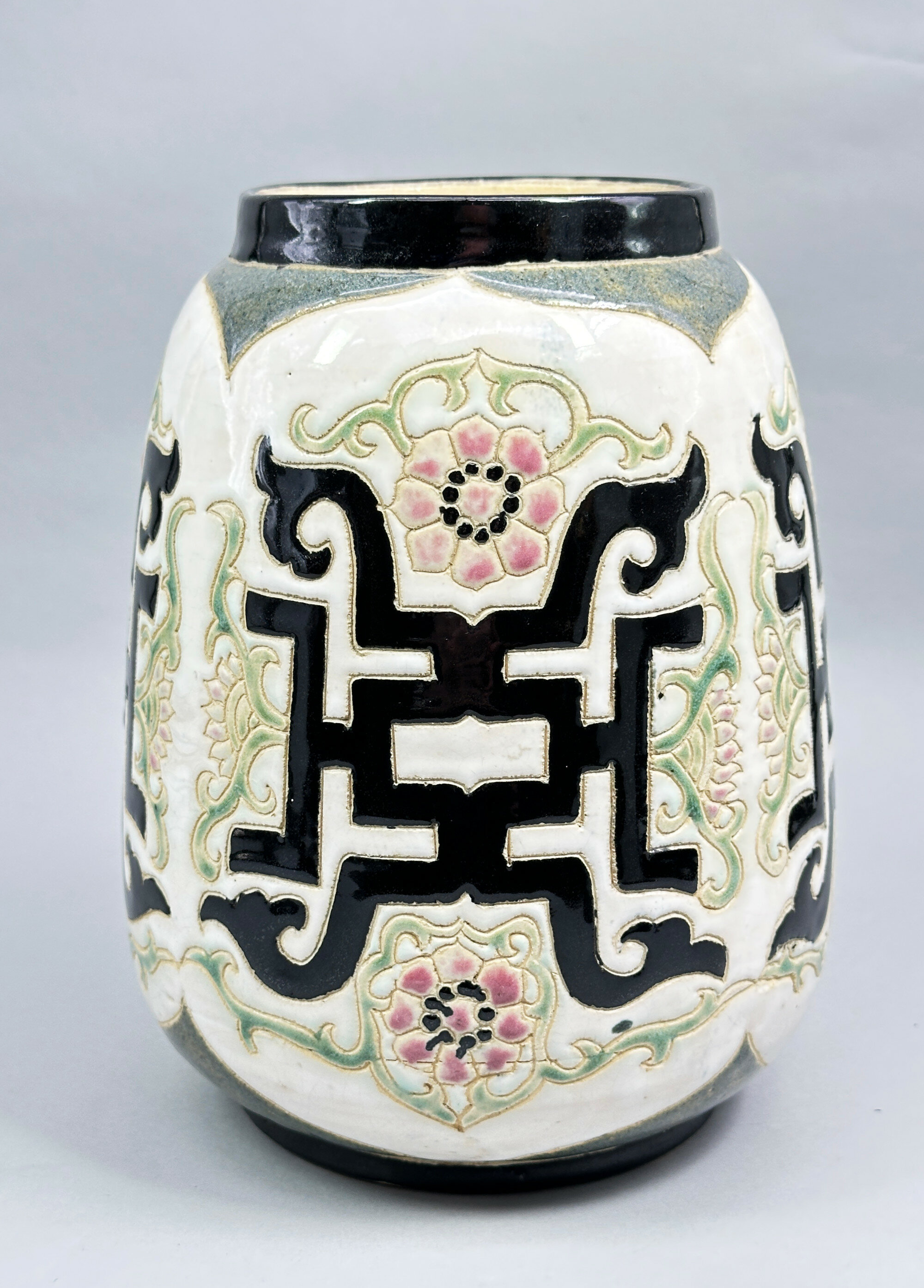
Continental Earthenware Vase with geometric motifs in the style of Amphora, C20th
Price: £45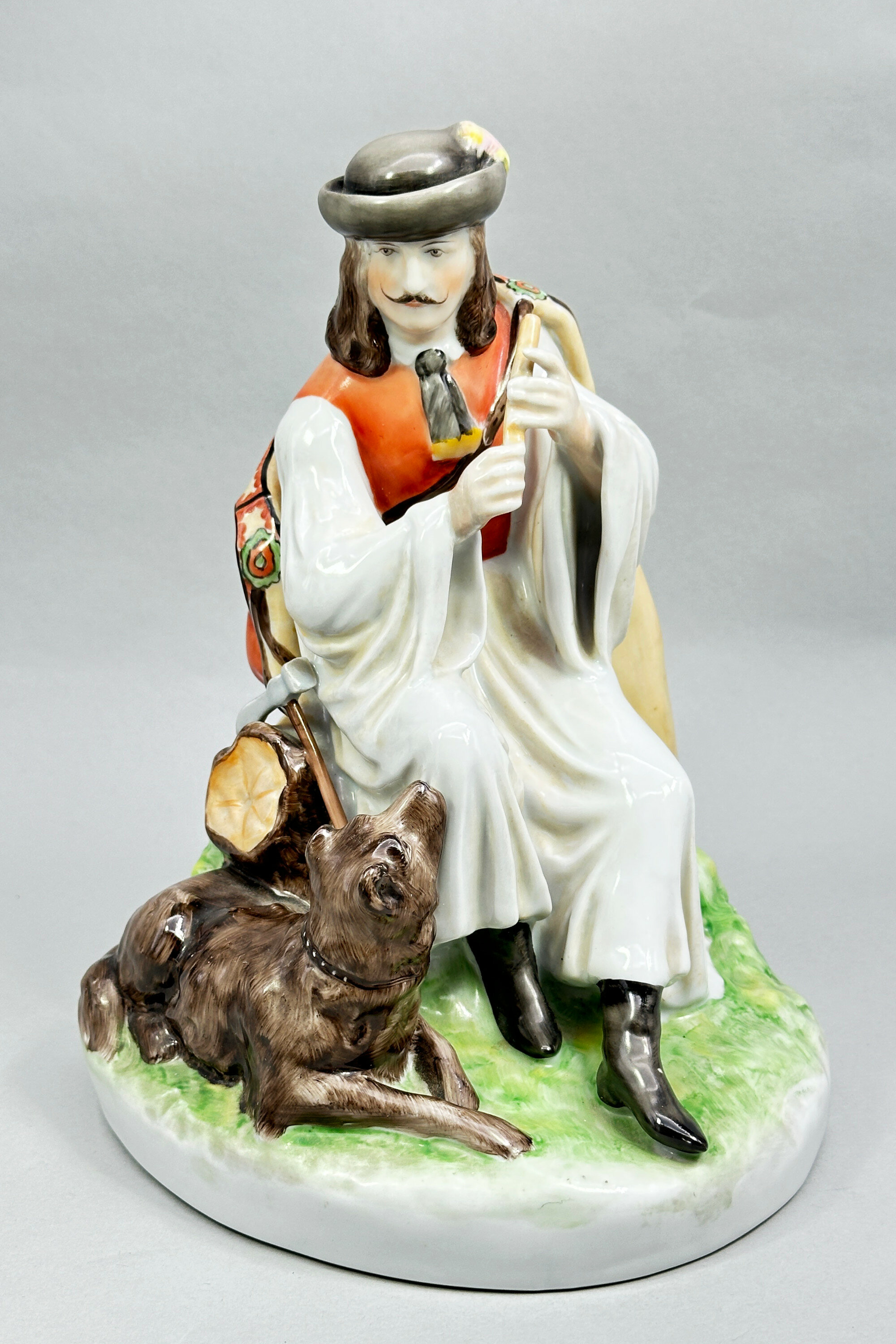
Figure of a Seated Huntsman, Zsolnay Pecs, 1970s
Price: £55The mark is for the well known ceramics manufacturer Zsolnay, based in Pecs, Hungary. Founded by Miklos Zsolnay in 1853, the firm gained a worldwide reputation in the late nineteenth century exhibiting at international fairs and exhibitions. Production declined after the first world war and the factory was bombed during the second. Revived under communism in 1948, the firm started to produce utilitarian pieces under the name ‘Pécs Porcelain Factory’ but gradually their traditional wares were revived and the Zsolnay name was restored in 1982.
This figure is one of the products of Zsolnay’s late renaissance but dating to the 1970s, as indicated by the form of the mark, it still carries only the Pecs brand name. But the quality typical of Zsolnay is emphatically there with fine quality porcelain and careful modelling and decoration all combining to produce a most decorative and attractive composition.
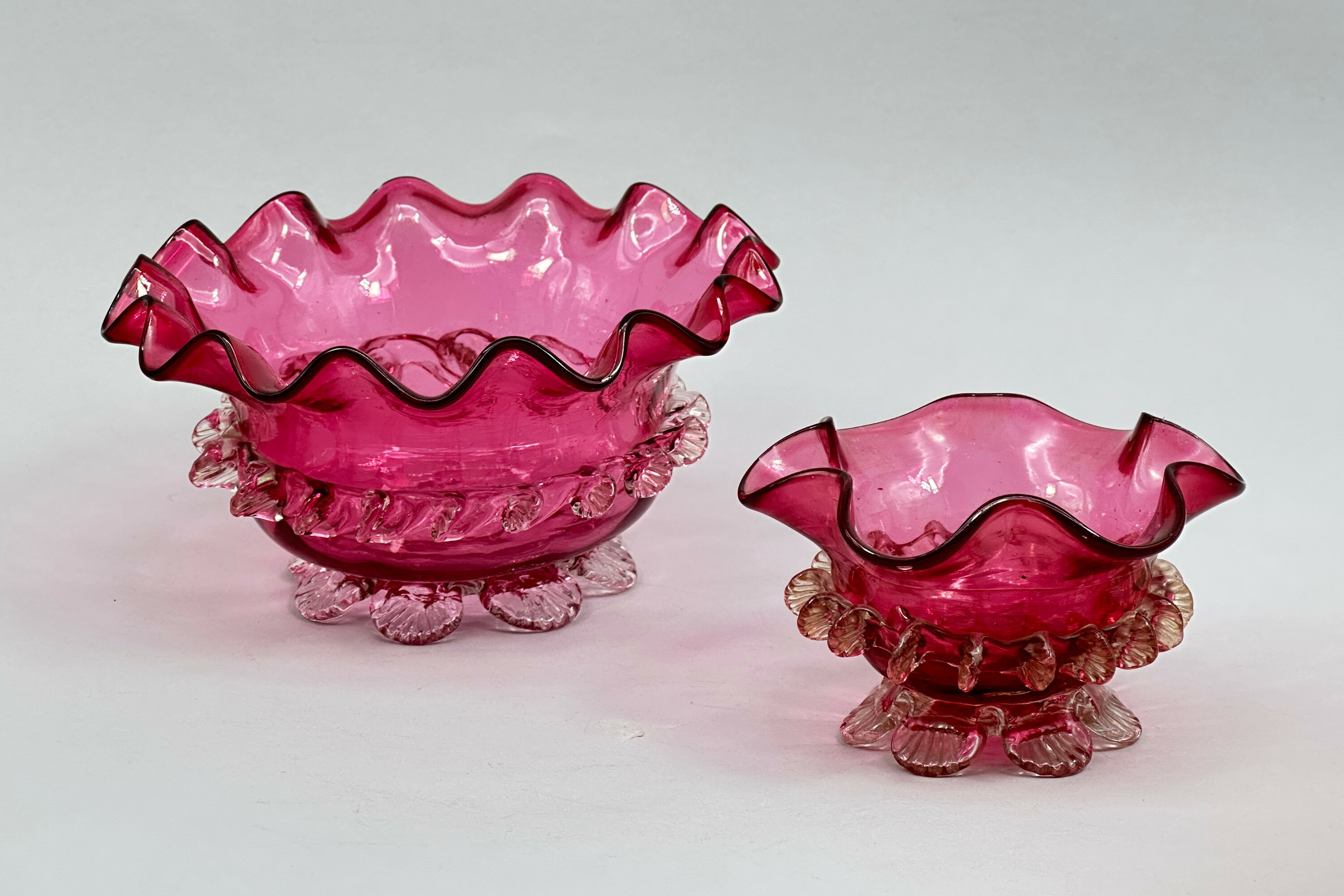
Two Victorian Cranberry Glass Bowls, late C19th
Price: £75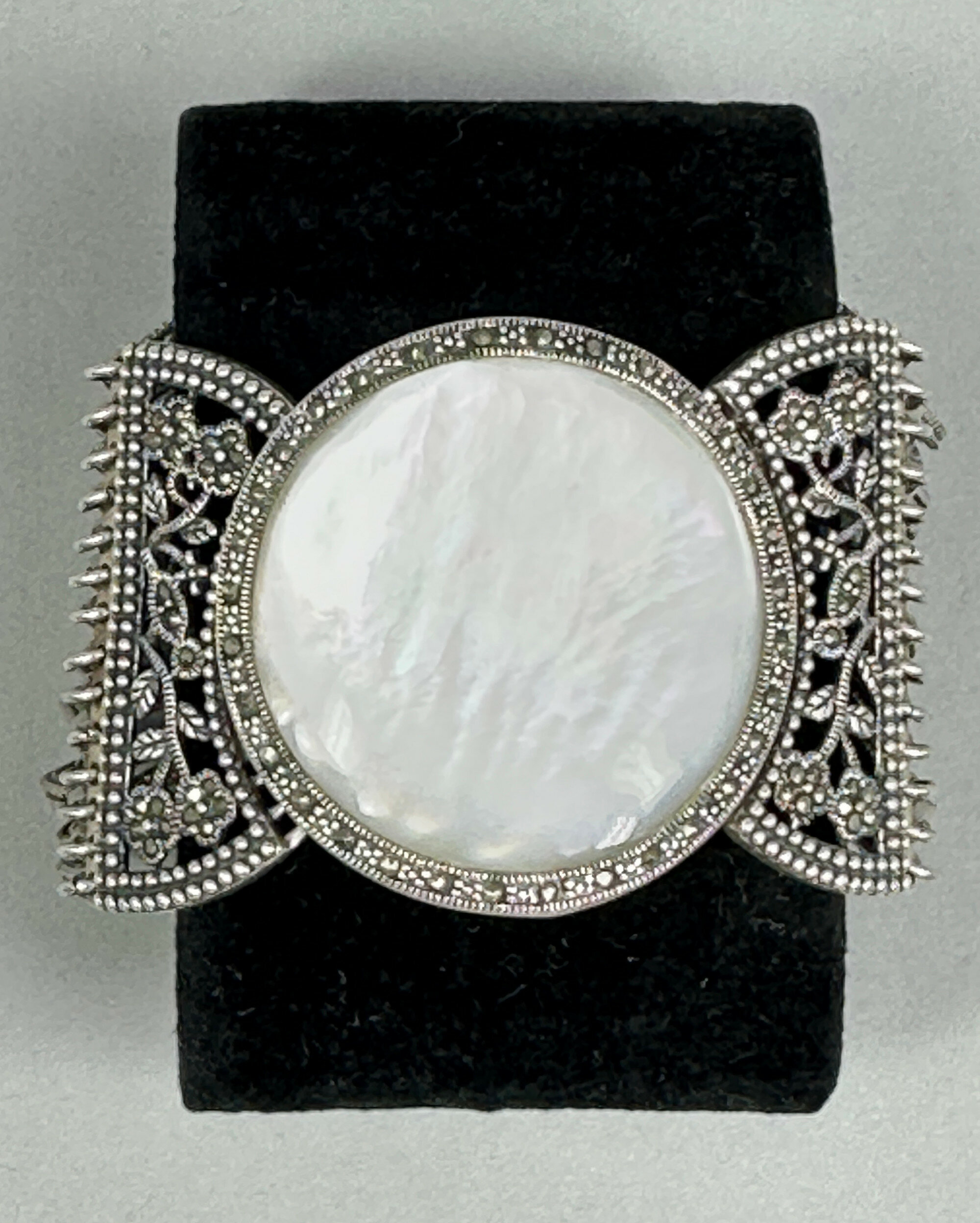
Victorian style Bracelet in Mother of Pearl and Silver, modern
Price: £95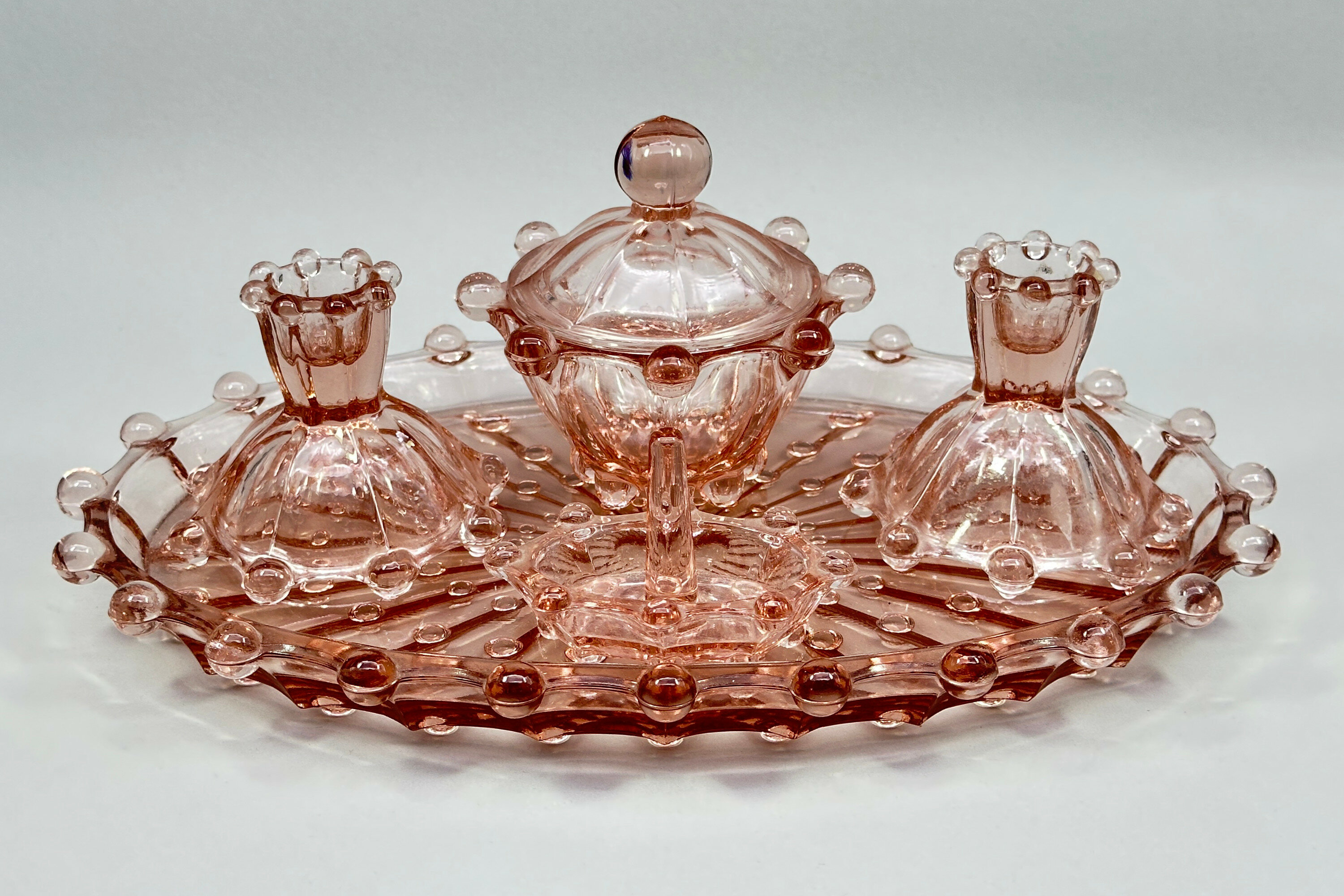
Pink pressed glass dressing table set, Libochoviche, Czech, 1950s
Price: £35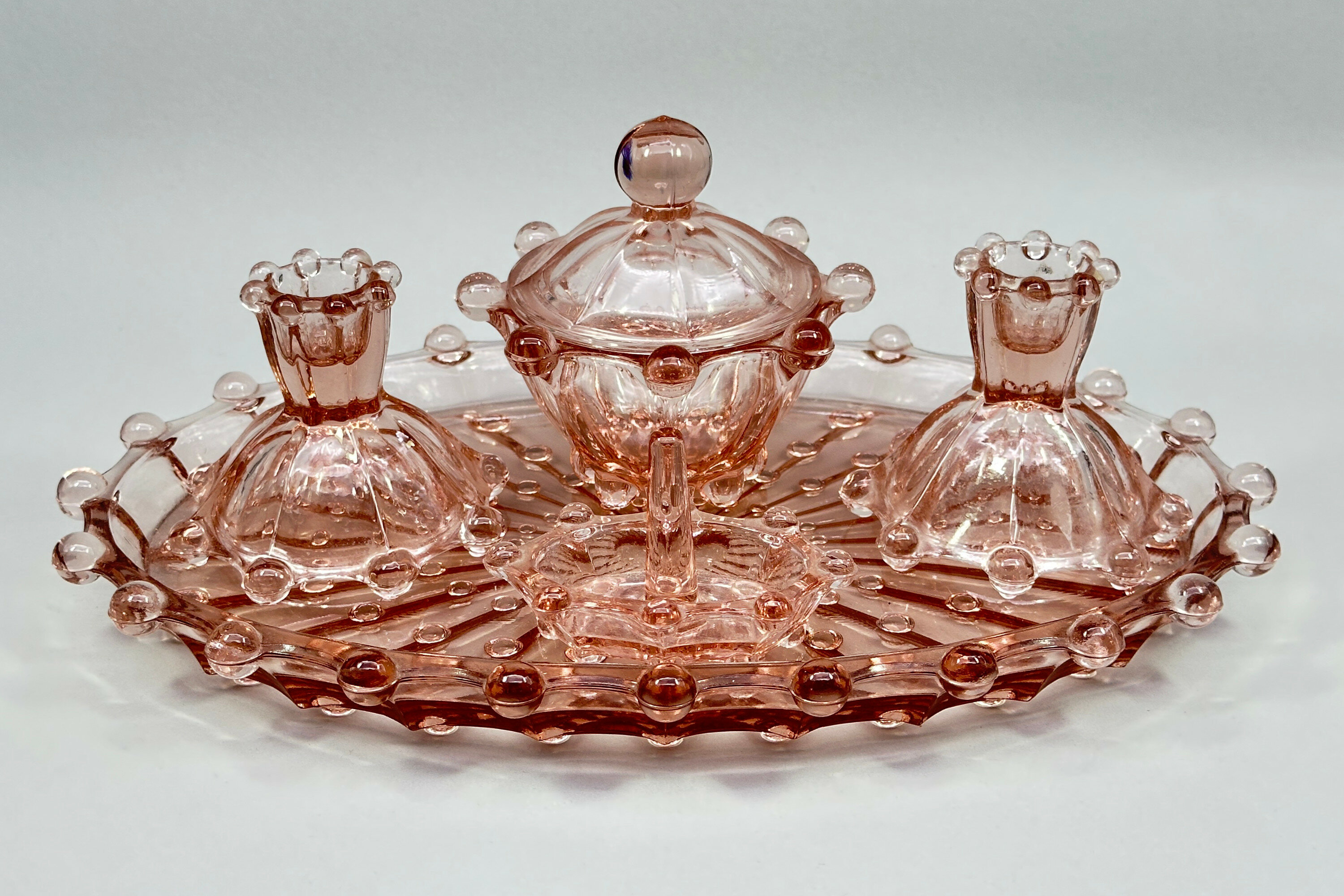
Pink pressed glass dressing table set, Libochoviche, Czech, 1950s
Price: £35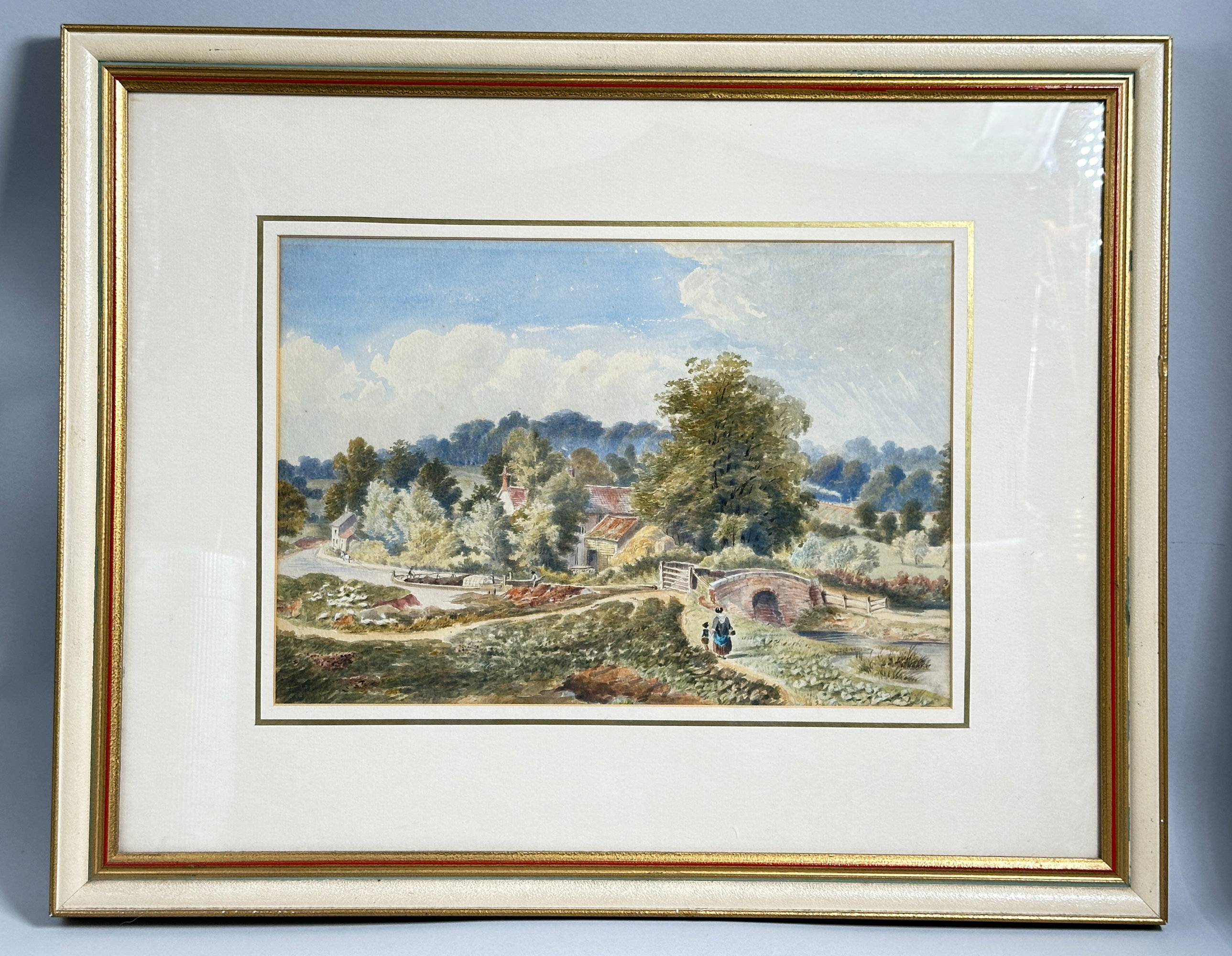
Framed Watercolour of a Countryside Scene, C20th
Price: £45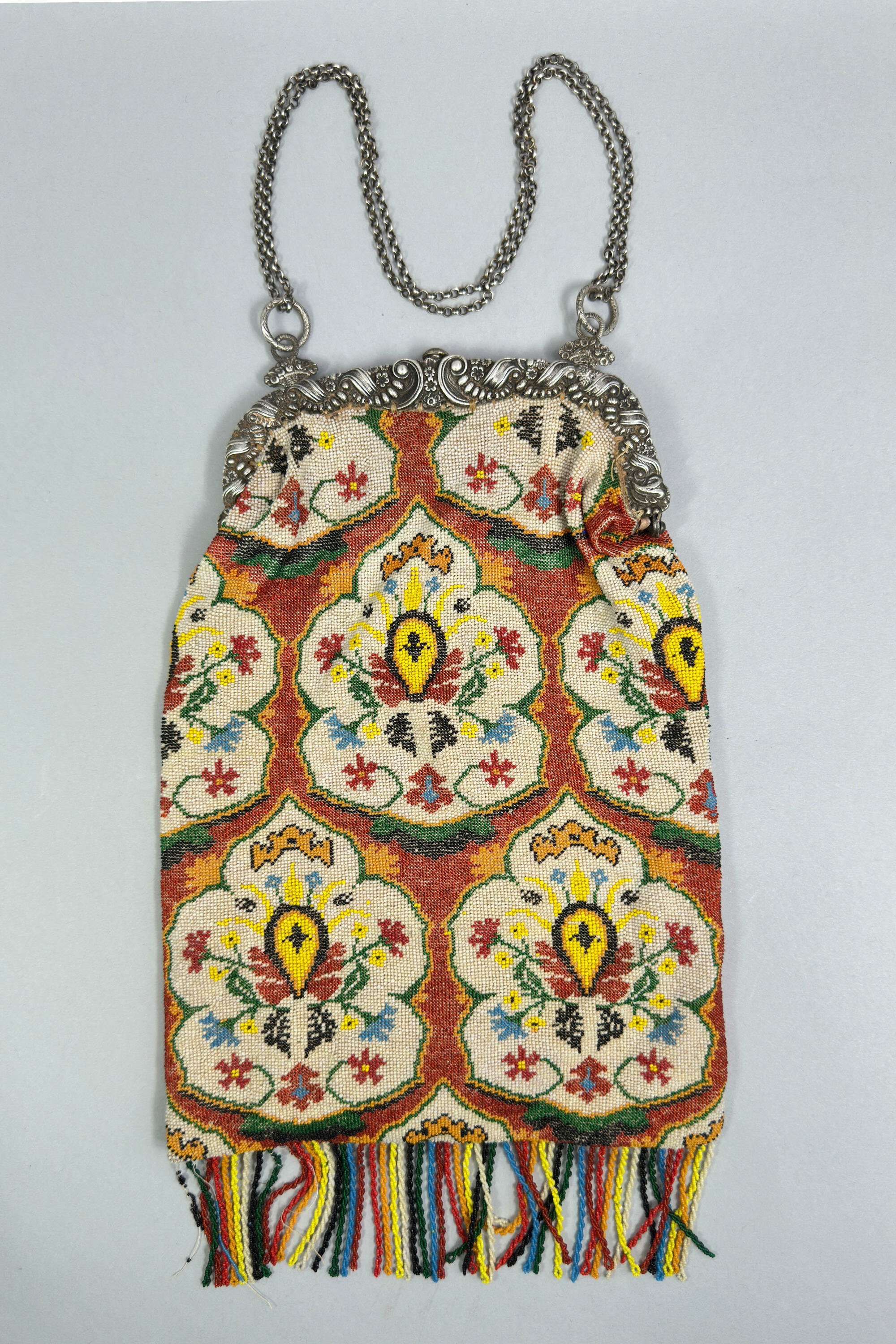
Micro bead silver mounted Flapper Bag, 1920s
Price: £125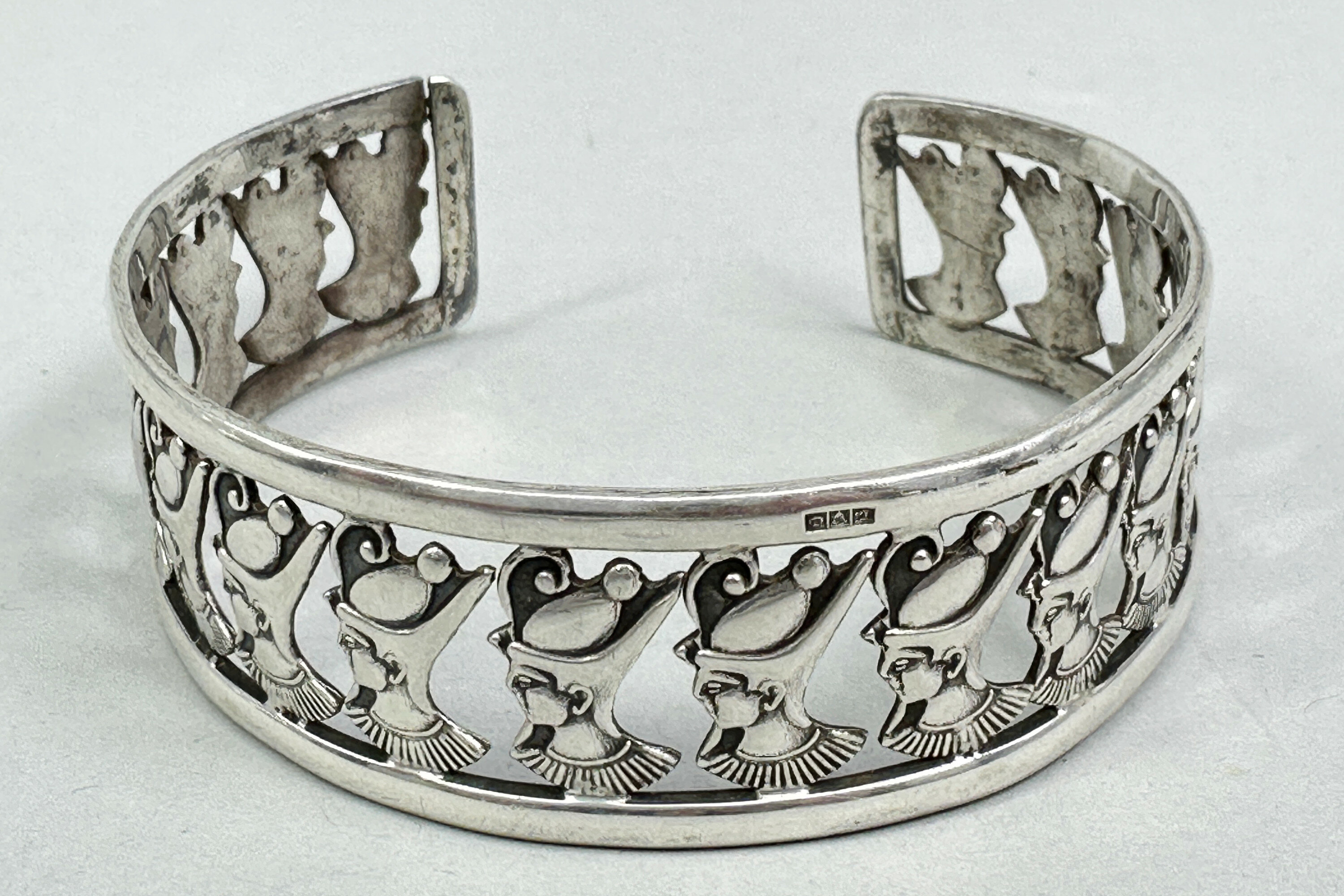
Egyptian revival Tutankhamun head silver Cuff Bracelet, 1940s
Price: £75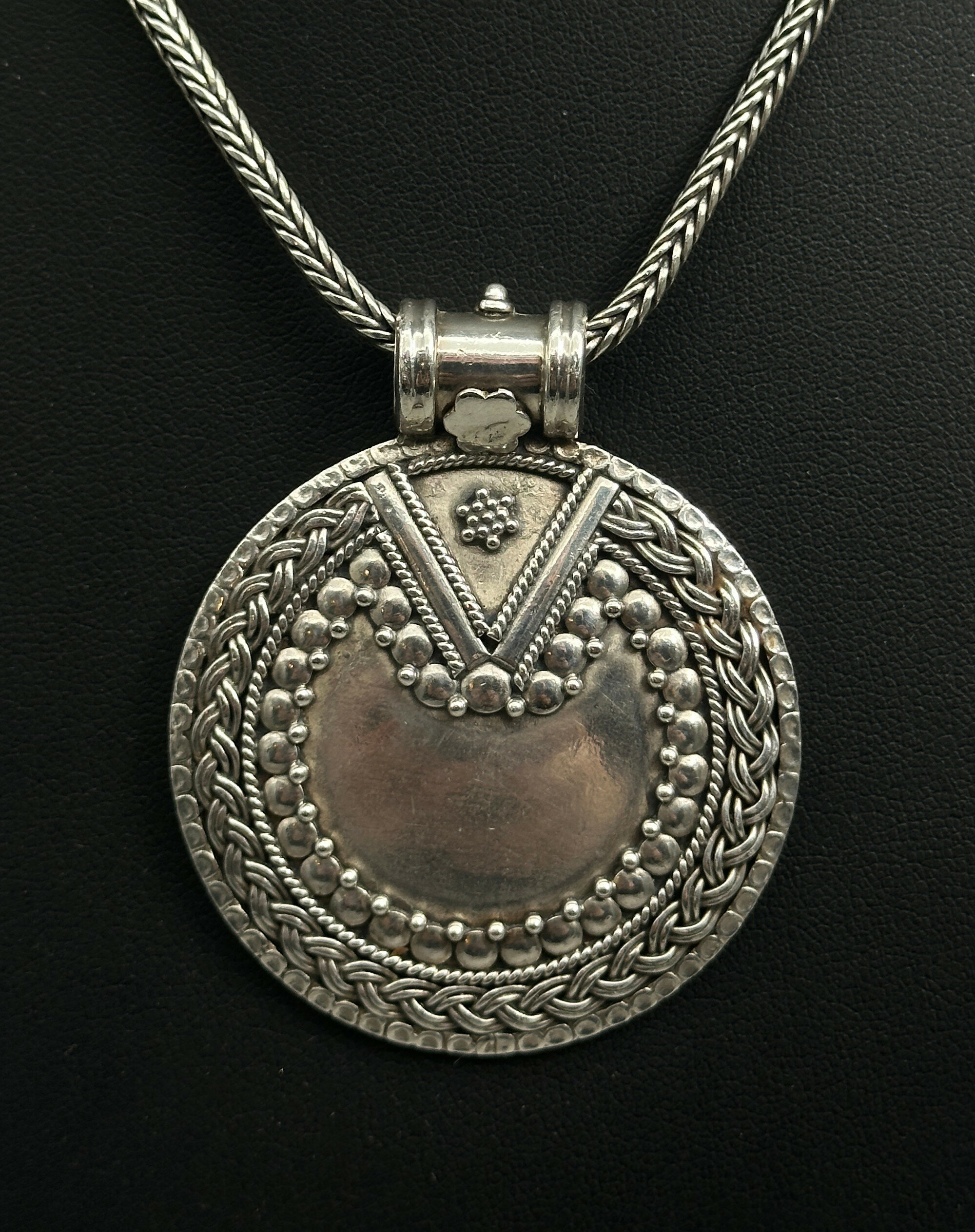
Vintage Indian silver pendant Necklace, 20th century
Price: £85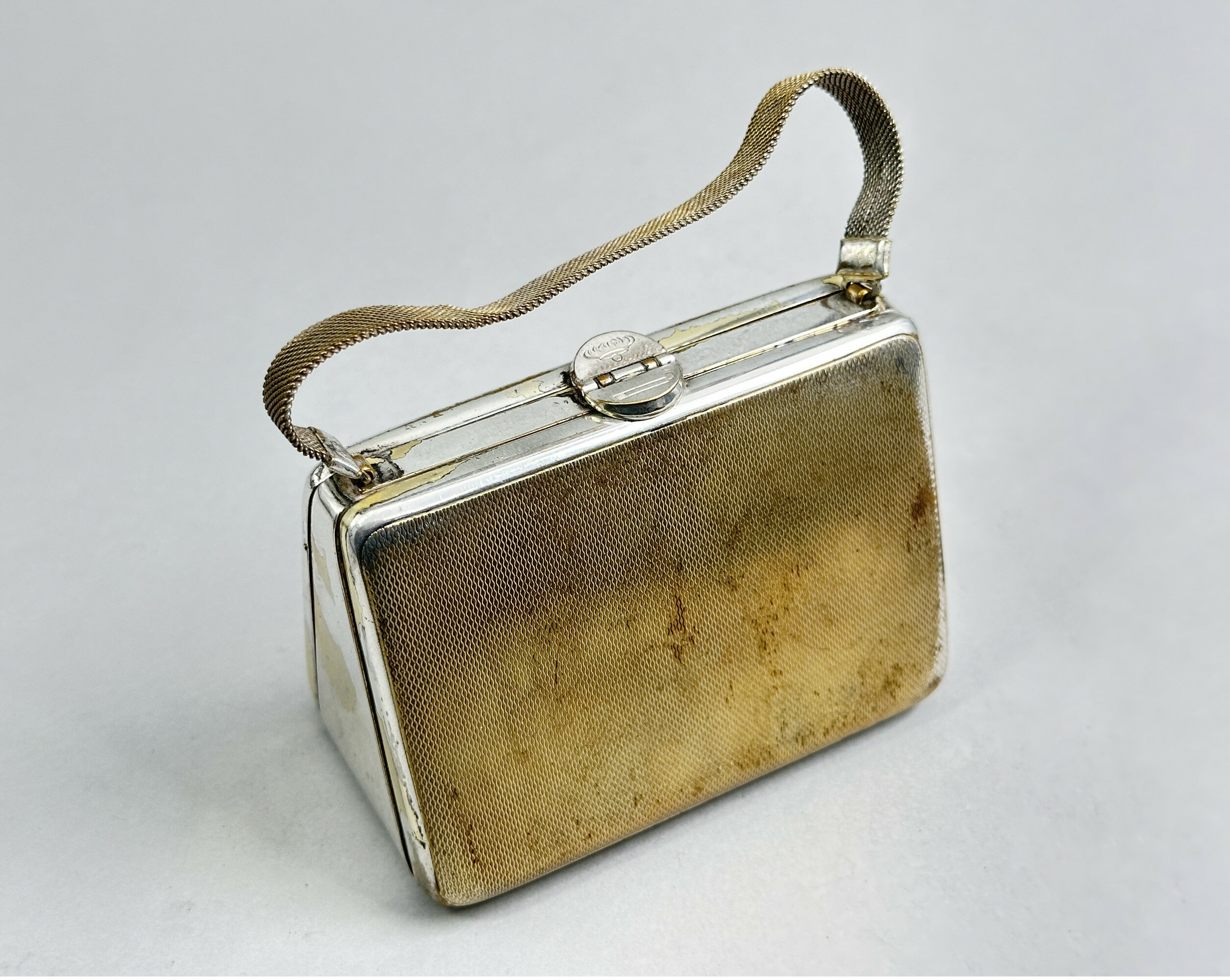
Double sided minaudiere wrist bag 1920
Price: £20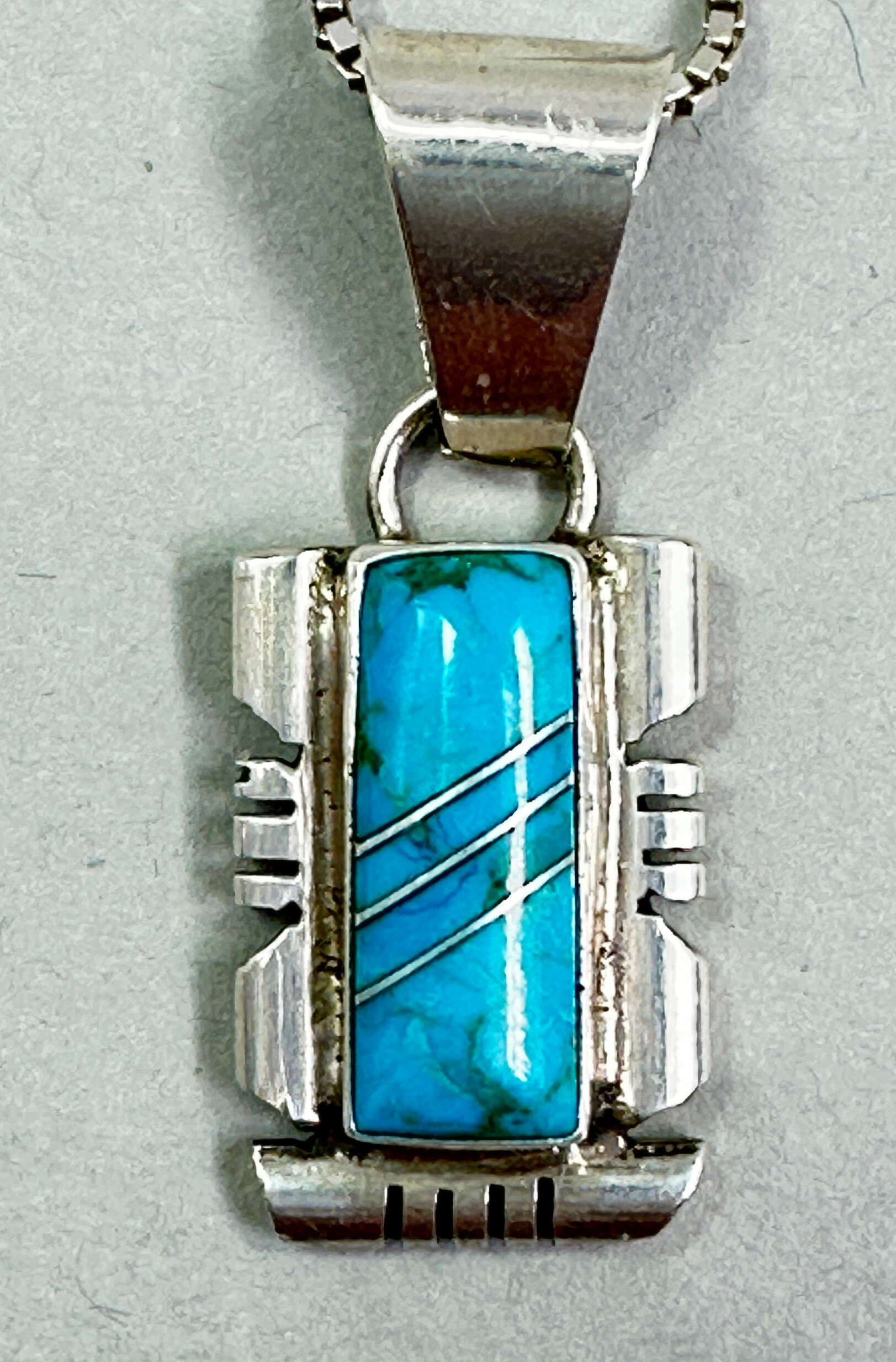
Zuni turquoise silver pendant Necklace, modern
Price: £35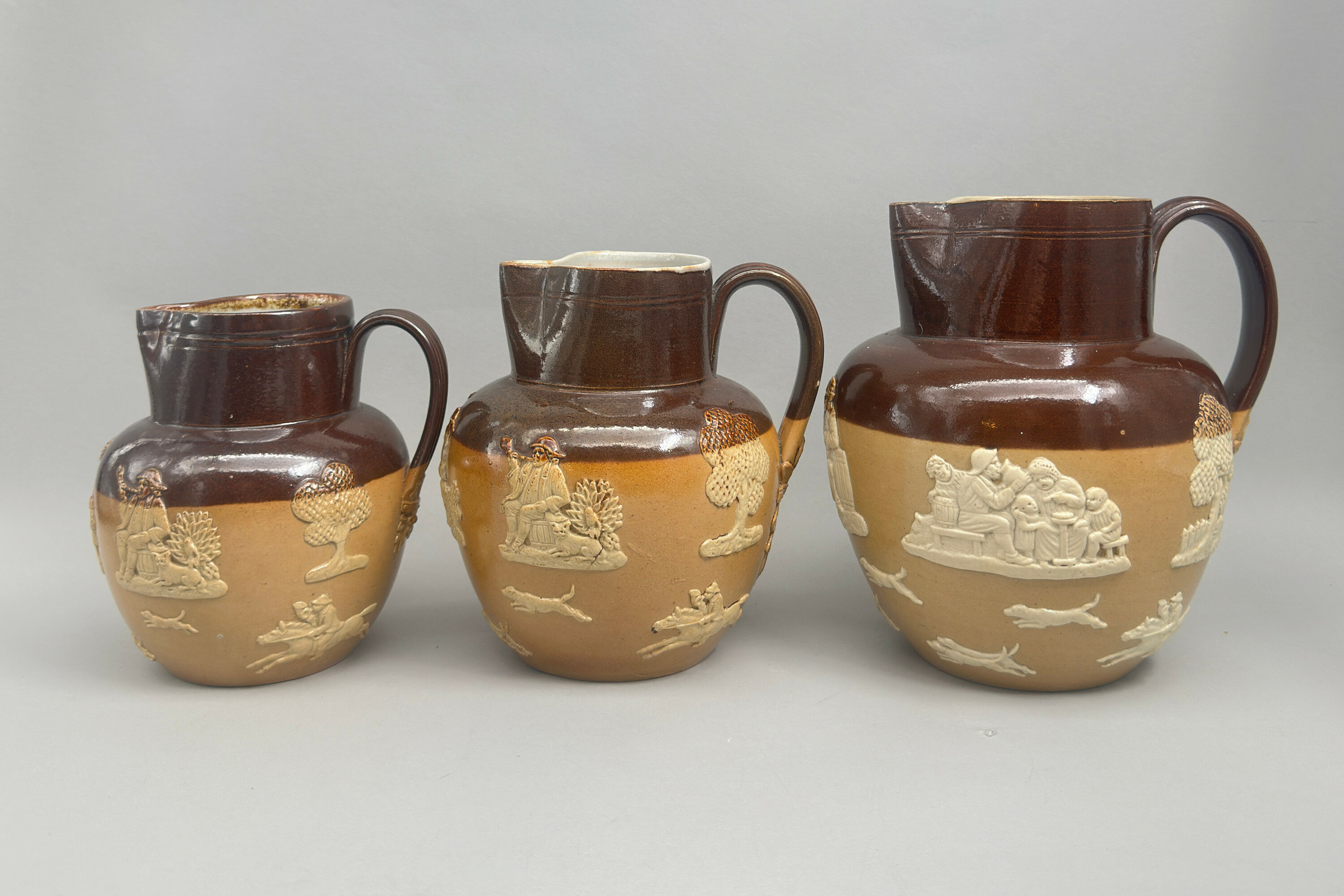
Graduated set of three Royal Doulton Harvest Pattern Jugs, early C20th
Price: £150While this model, often called the ‘harvest pattern’, is found quite often, it is very unusual to see a graduated set of three, all matching. The form of the mark, where the lion does not sit above a crown, was used between 1922 and 1927 which gives us the dating here. The largest jug carries the letter ‘a’ which was a decorator’s mark and stands for Louisa Ayling. Perhaps she worked on all three, but this must remain a guess although the quality of the work on all three is quite consistent producing a highly decorative and attractive ensemble.
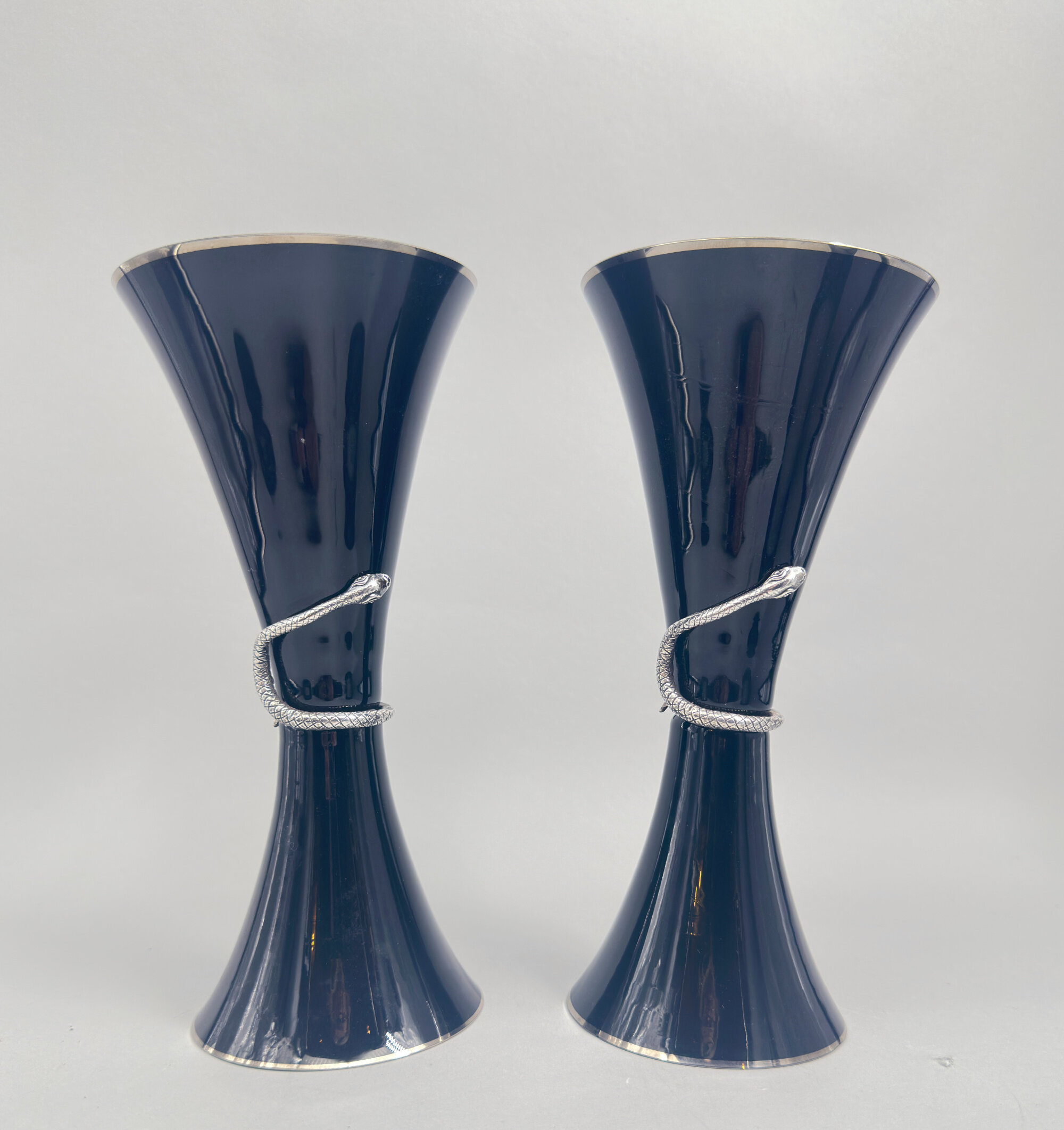
Pair of Art Deco glass Vases with applied silver snakes, 1930s
Price: £95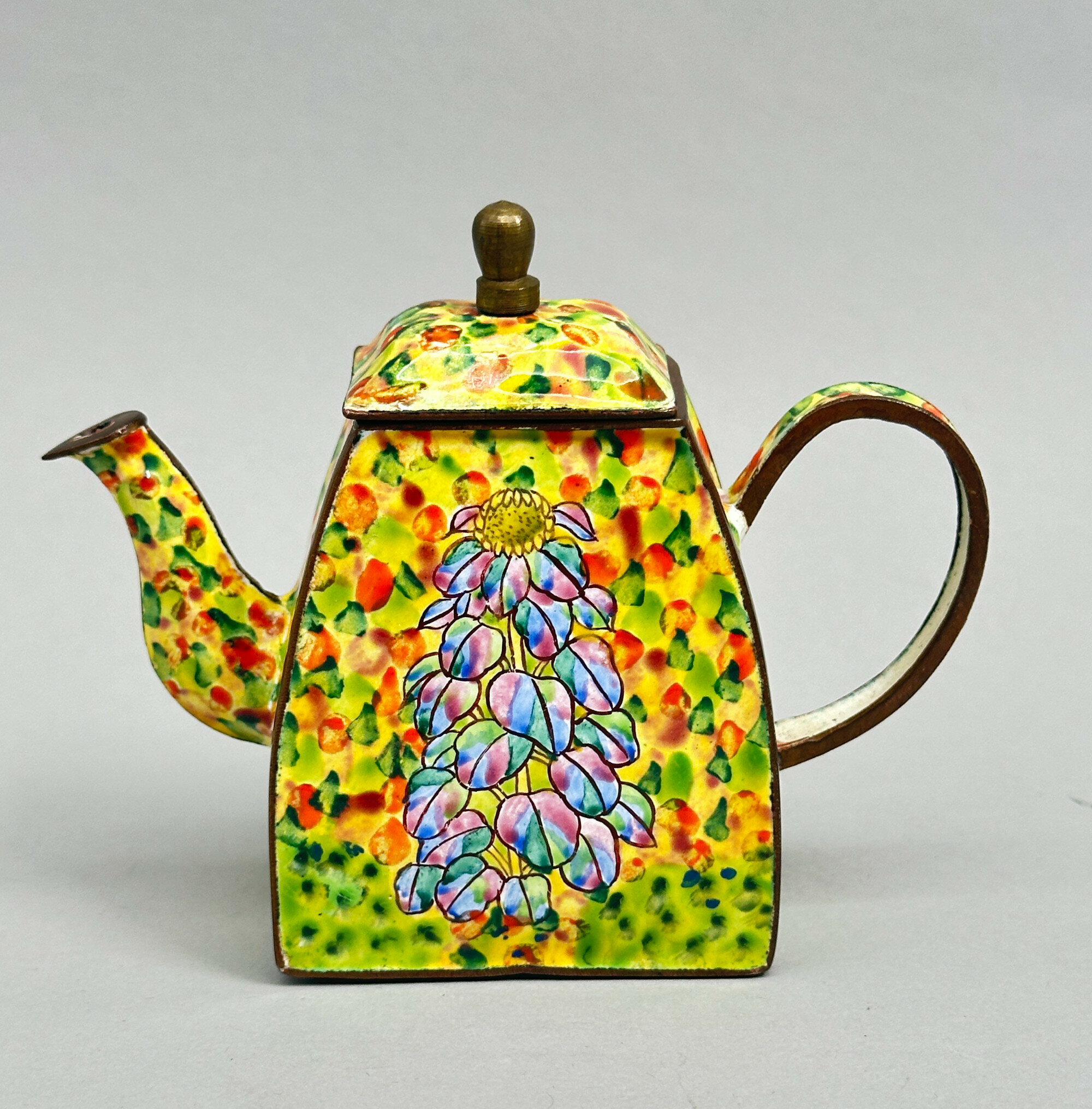
Trade+Aid Enamel Teapot, No.292.UK, 1990s
Price: £25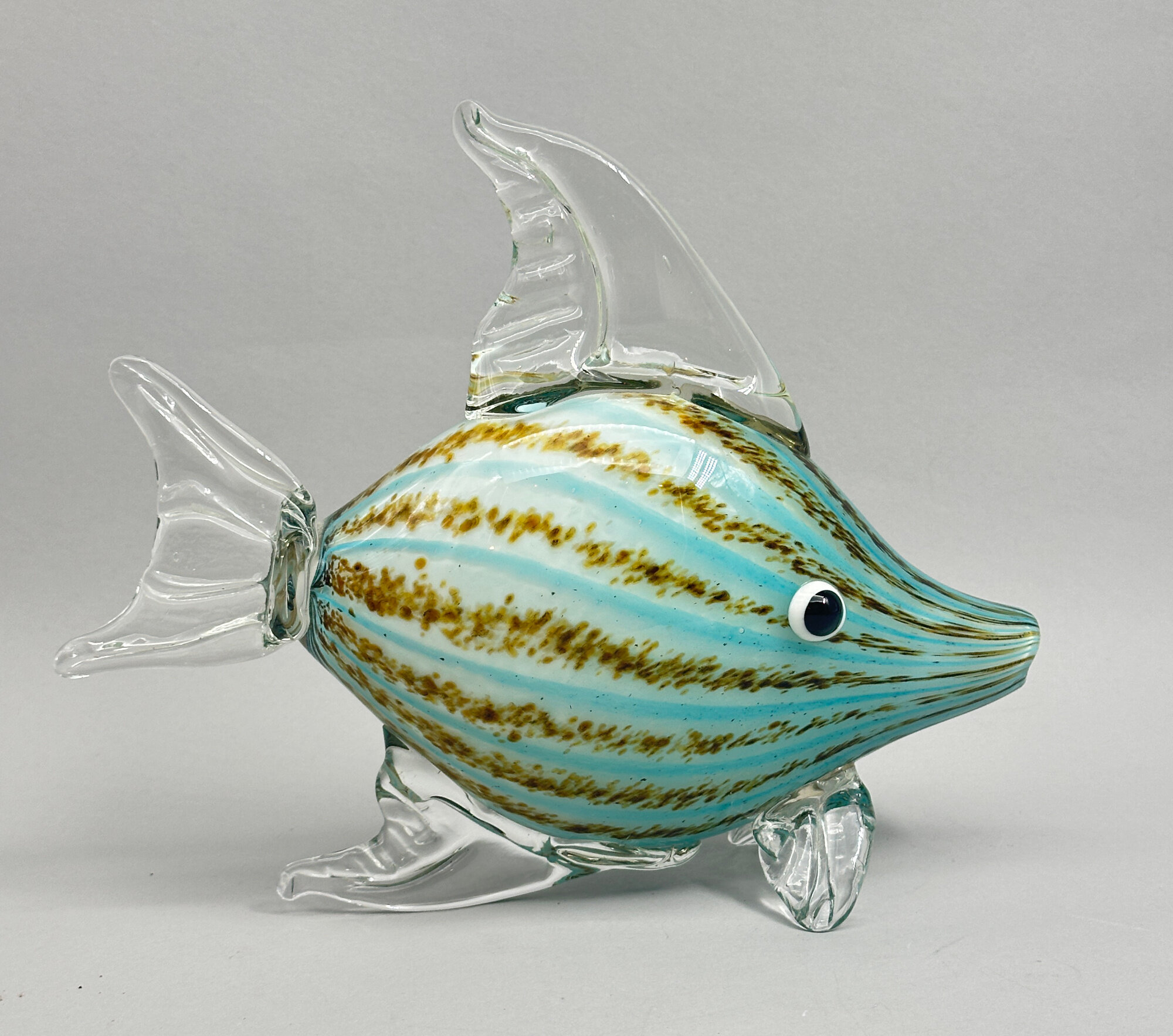
Murano Glass Fish, second half C20th
Price: £55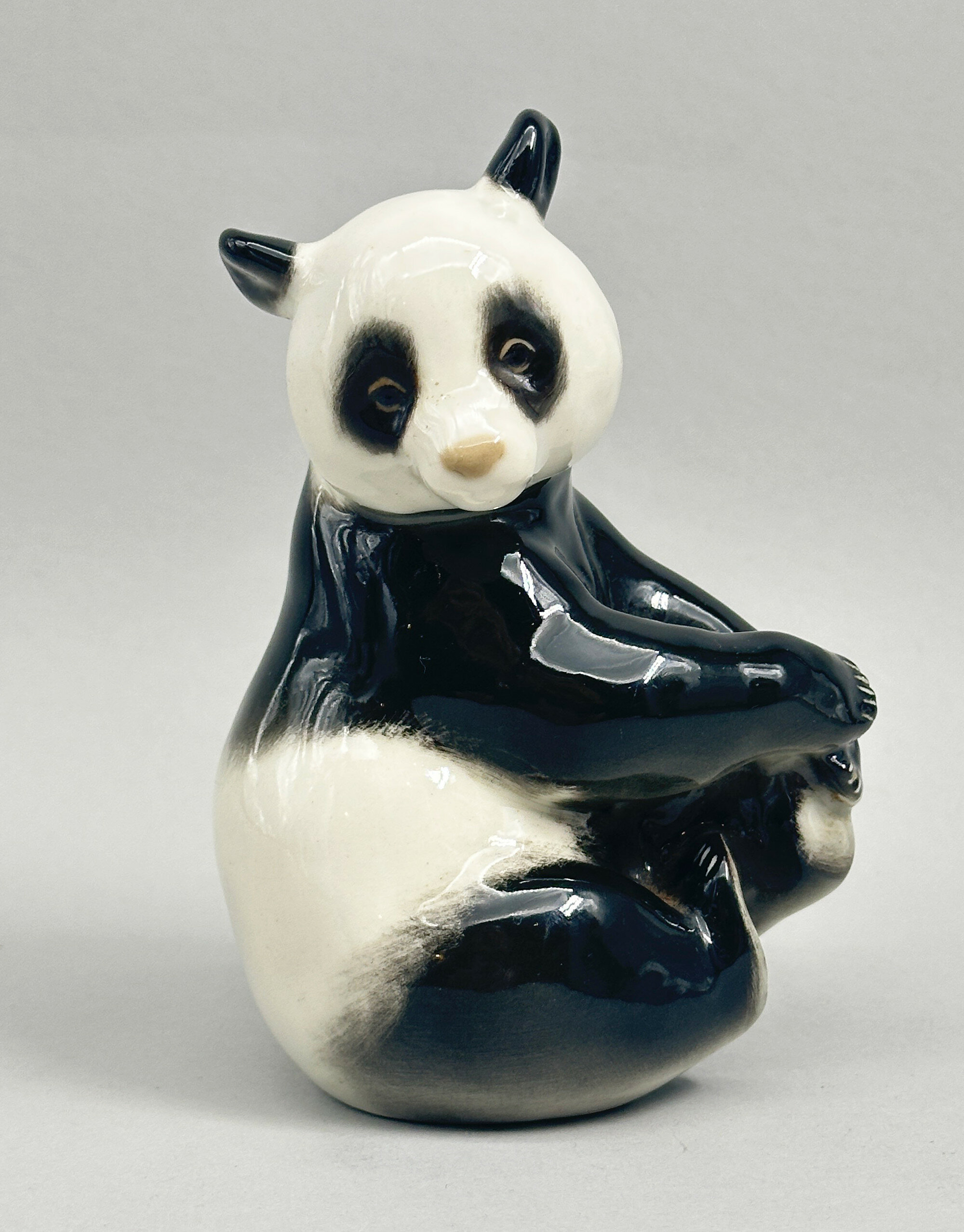
Porcelain Figure of a seated Panda, Lomonosov, USSR late C20th
Price: £25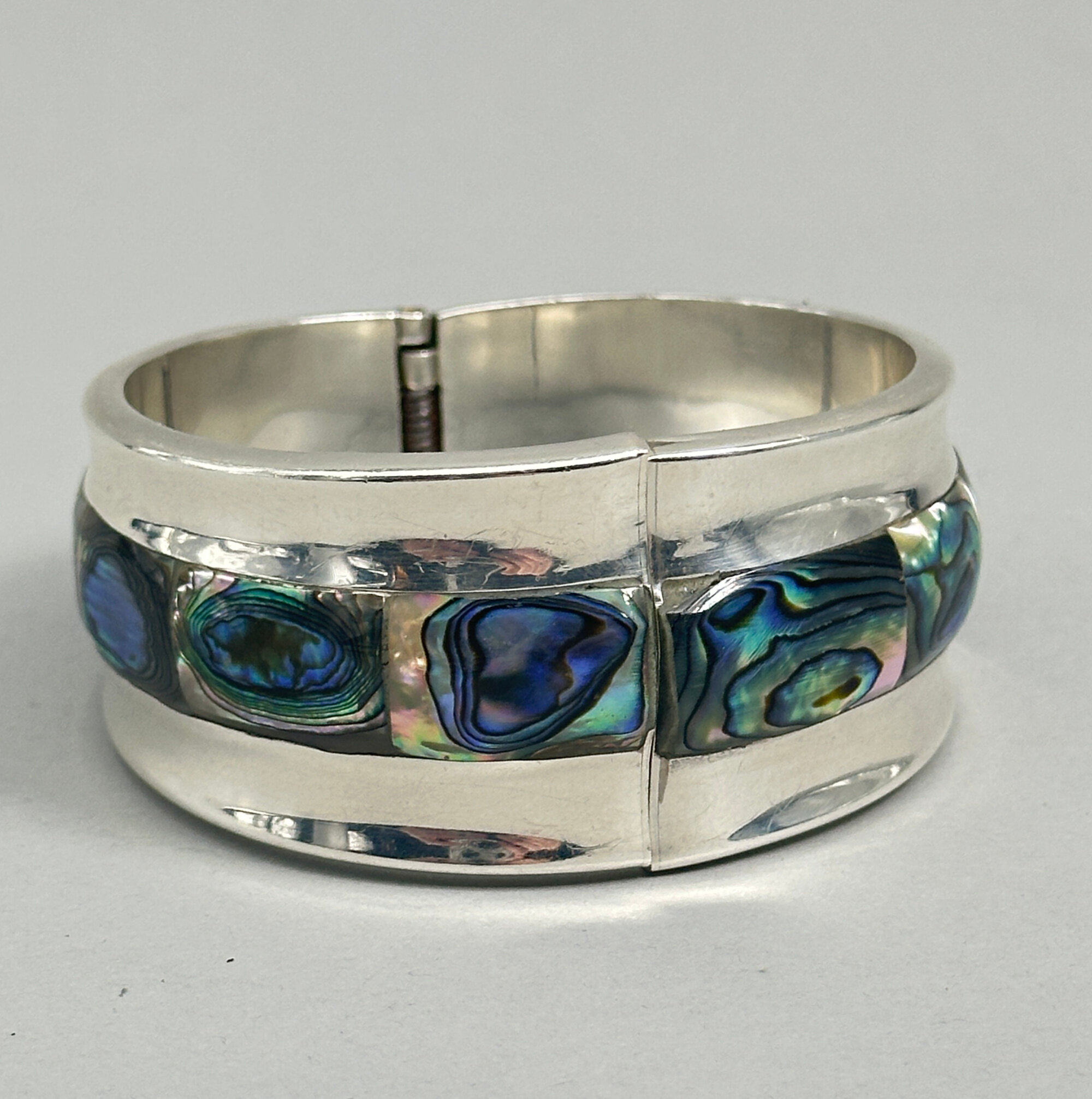
Outstanding Taxco silver and abalone Bangle c1980
Price: £200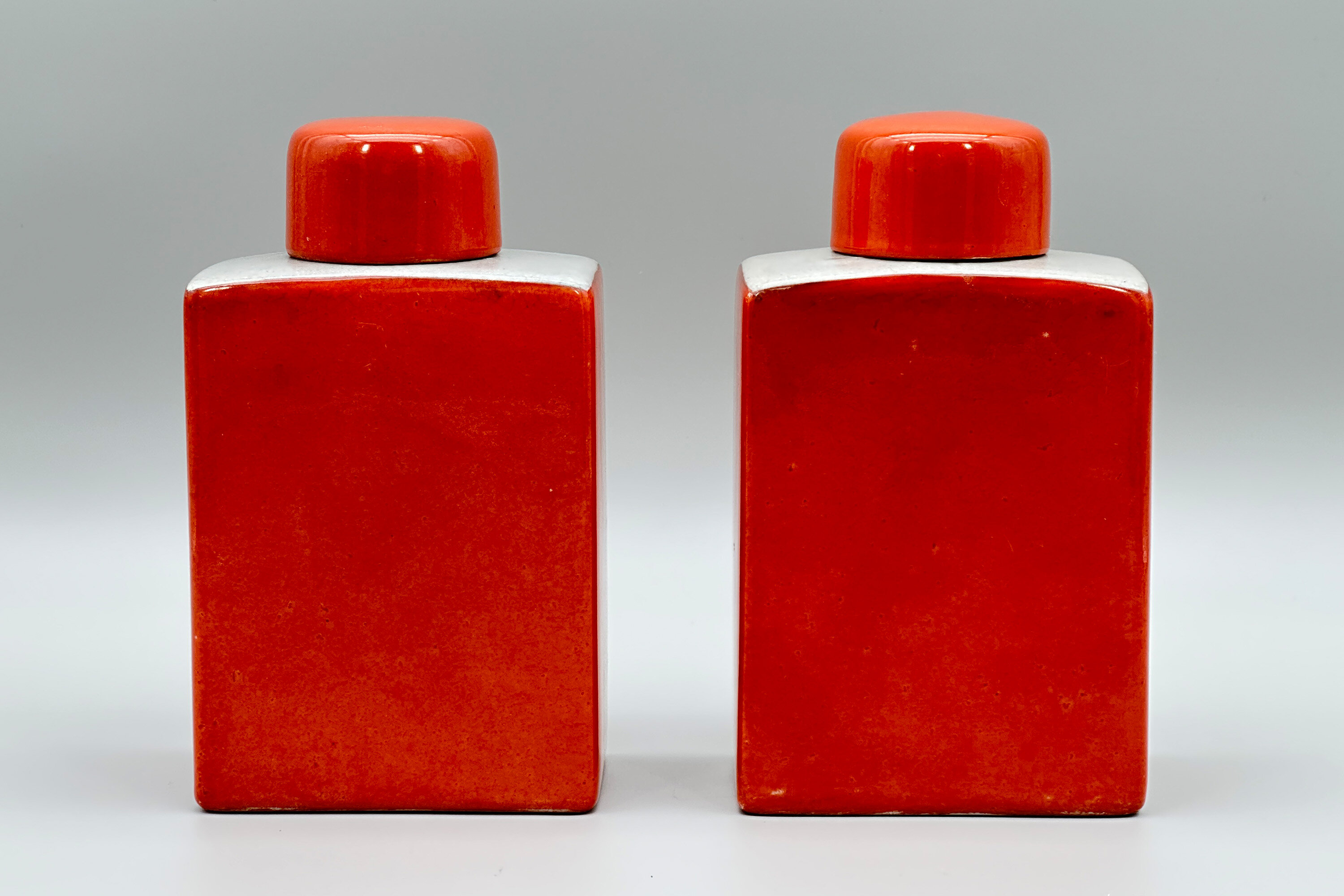
Pair of Orange Glazed Flasks and Covers, Fabienne Jouvin Paris, C20th
Price: £150The French designer Fabienne Jouvin (see image 9) graduated from the superior school of applied arts Duperré in 1985. Since then, she has travelled the world collecting designs for pieces sold and exhibited under her name internationally, with a studio based in Paris. On her website, she writes “From my travels - from Tokyo to The Habana, from the streets of Paris to the sea bed of The Maldives - I bring back sketchbooks, pads of notes, drawings and collages: hispanic or contempory architectures, faces reminding those of Piero Della Francesca, enigmatic objects non identified... These spontaneous sketchbooks give rise to unique pieces and editions painting, textile, porcelain, cloisonné...”. Her first exhibition was in 1989 and in 1996 she began an association with the firm ‘Asiatides’ allowing her to create pieces made in China and Thailand and utilising their designs and techniques.
This pair of flasks, possibly intended as tea caddies, are typical of her ability to give a ‘twist’ to the pieces from which she draws her inspiration. The shape is Chinese from the seventeenth century (see image 10), while the iron red colour is found on Chinese pieces two hundred or more years later. Combining this with a white ‘crackle glaze’, also well known from Chinese ceramics, was Jouvin’s own idea completing the mix of ancient and modern. Marked as from the Asiatides range with the stylised ‘A’, pieces like these are no longer available currently implying that they were probably made early on in her association with the firm and now have a uniqueness of their own.
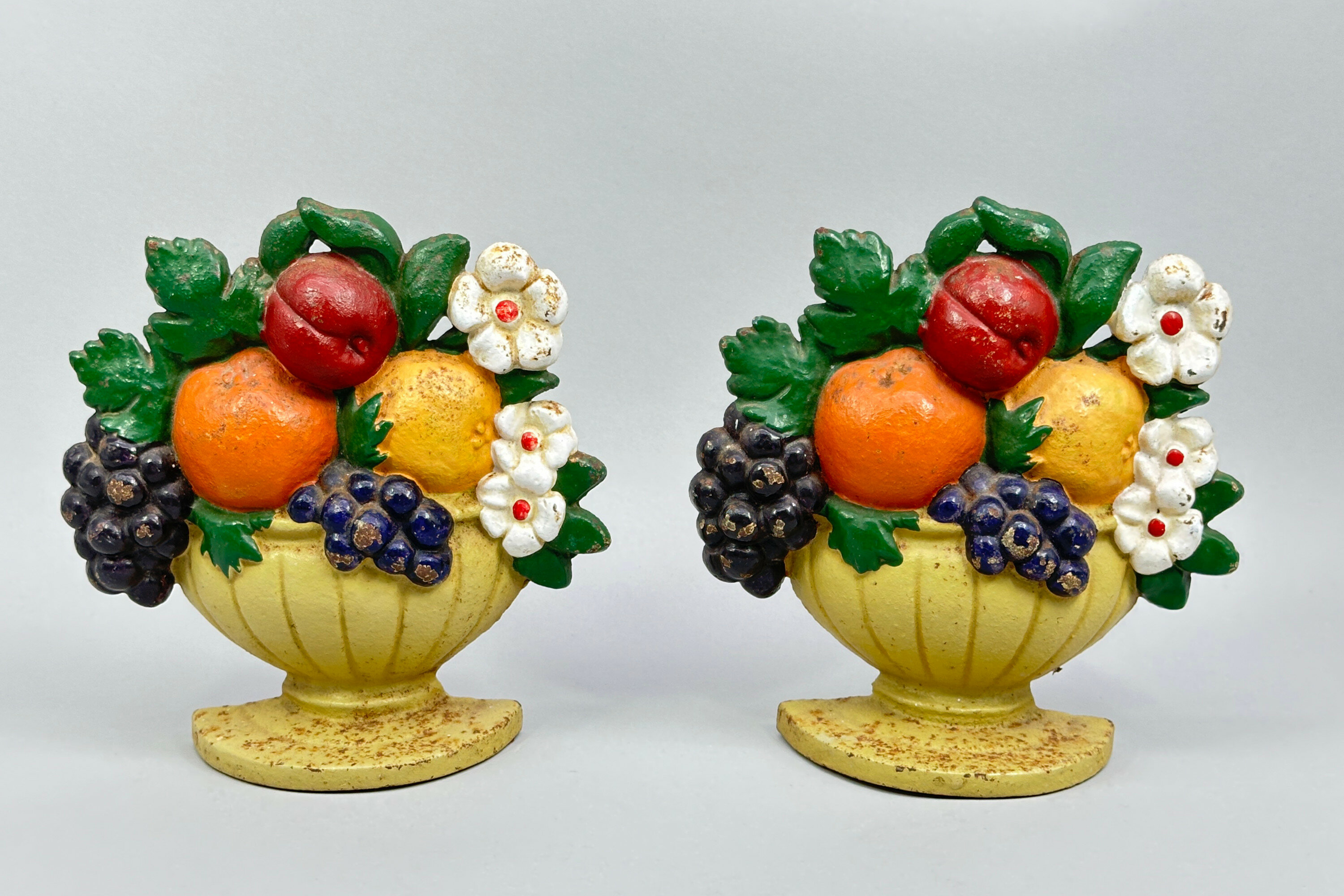
Pair cast iron Doorstops, Basket of Fruit, probably American mid C20th
Price: £45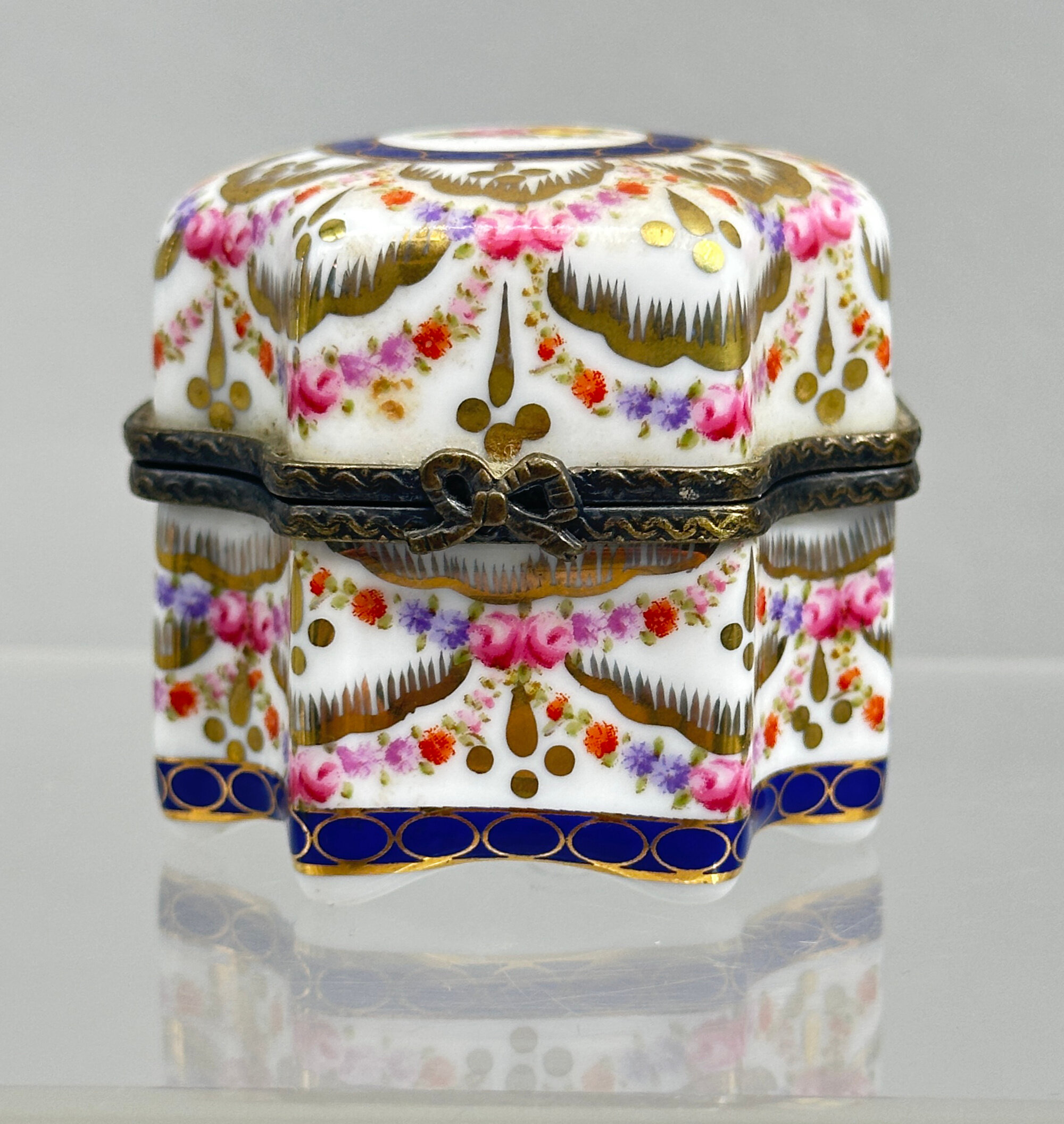
Reproduction Limoges Porcelain Box with Scent Bottles, Modern
Price: £25
Pair of Opera Binocular Glasses in green leather Case, French, first half C20th
Price: £25
Arts and Crafts Hand Mirror with Repousse Decoration, circa 1900
Price: £55Elements of two contrasting contemporary styles combine here with features from both the Arts and Crafts and the Art Nouveau movement. The hammered pewter with the almost rustic nail head fixings and the red bead reflect the former but the elegant depiction of the lotus and butterfly, with more than a hint of the Orient, reflect the latter. The maker is anonymous but doubtless British and clearly a highly skilled craftsman. Much thought and expertise went into the design of this piece which would be a desirable addition for collectors of either or both of the pieces made under the influence of these two highly popular design movements.

Arts and Crafts Hand Mirror with Repousse Decoration, circa 1900
Price: £55Elements of two contrasting contemporary styles combine here with features from both the Arts and Crafts and the Art Nouveau movement. The hammered pewter with the almost rustic nail head fixings and the red bead reflect the former but the elegant depiction of the lotus and butterfly, with more than a hint of the Orient, reflect the latter. The maker is anonymous but doubtless British and clearly a highly skilled craftsman. Much thought and expertise went into the design of this piece which would be a desirable addition for collectors of either or both of the pieces made under the influence of these two highly popular design movements.

Reproduction Queen Victoria Diamond Jubilee Teapot, Modern
Price: £35
Vintage Lacquer Box with an inset ceramic Shard, probably Persian C20th
Price: £25
Past Times Art Nouveau Style Vase, Veronese Collection, 2004
Price: £45‘Past Times’ was founded in 1986 by John Beale, at first as a mail order company but then trading from physical stores and developing into a business which enjoyed enormous popularity with over one hundred shops in the early 2000s. The stock was focused on retro and vintage style items also including a wide range of licensed products, such as Harry Potter and Beatrix Potter merchandise. Badly impacted by the recession in 2008 it went into administration in 2012 and was bought by W.H.Smith a year later leading to the disappearance of its products from the marketplace.
This ‘Art Nouveau’ vase can be seen as an example of their range at its best. Manufactured with care it presents an appealing souvenir of the era it aims to recreate at a rather more affordable price than the authentic originals.

Studio Pottery Bowl, possibly Derek Clarkson (1928-2013) with impressed mark, C20th
Price: £55While it is not absolutely certain the mark on this piece is possibly that of Derek Clarkson (1928-2013). Clarkson trained at the Manchester college of Art between 1944-47 and Burnley School of Art from 1959-61 and then combined a successful lecturing career with the making of his own work which is now to be found in international and private collections including the Victoria and Albert Museum, London. In 1980 he retired from lecturing to focus on his work as a potter, continuing to produce pieces of great skill and attraction until his death in 2013. There are other pieces signed by him which strongly resemble the bowl here (see images 8,9) making it a possibility that this is his work. Certainly, the potter who created this piece and impressed his mark at the bottom was clearly accomplished and this bowl is more than worthy to stand comparison with pieces by more famous contemporaries.

Commemorative Ware Silver Jubilee Plate, James Kent Ltd, England, 1935
Price: £35
Persian Marquetry Khatam Kari Desk Set, second half C20th
Price: £55The intricate marquetry decoration used here, with its repeating star form pattern, is called ‘Khatam’ work. Khatam is the capital of Khatam County in Iran and is the centre for craftsmen working in this technique. Khatam is a Persian version of marquetry in which the surface of wooden articles is decorated with small pieces of wood, bone and metal formed into precisely-cut geometric shapes. The process is time consuming involving the cutting of the shapes and gluing them in place, followed by smoothing, oiling and polishing. In Persian, the work is known as ‘Khatam kari’, ‘the art of crafting Khatam ware’.
These desk sets occur in a wide variety of forms. The drawer is less commonly found and decorated pen holders are, as said above, most unusual. These sets seem to have been made from the 1950s onwards. The use of a ‘biro’ pen indicates a dating from the 1960s onwards and perhaps this example is a bit later than that, but the workmanship speaks for itself and the piece has survived in excellent condition with minimal damage, providing a truly elegant ‘desk tidy’ for the contemporary study!

Art Nouveau repousse Pendant on later chain, c1910
Price: £95
Chinese lotus form Water dropper, C20th
Price: £25
Large Mdina Glass Paperweight/Doorstop, late C 20th
Price: £55
Sack form plastic beaded bag, English, 1950s
Price: £65
Decorative pair of Chinese ceramic figures of children, Yunu and Jintong , late C20th
Price: £45
Lomonosov Teapot decorated Cockerels, late C20th
Price: £45
Pair of Vintage Art Deco style armchair Pipe Rests, English c1930
Price: £55
Pair of Doulton Lambeth Vases, signed and dated 1882
Price: £150The Doulton factory began production in 1815, first at Vauxhall and later moving to Lambeth. In 1882 it opened an additional factory at Burslem, Stoke on Trent in the centre of the English pottery. Known at first mainly for utilitarian works it began to develop decorative wares more extensively in the 1860s and soon gained a reputation for its distinctive designs. As the factory mark indicates, these pieces were made at the Lambeth factory and the absence of ‘England’ below it indicates that it dates to before 1891. The Lambeth ware pieces were often marked with the date of manufacture, here 1882 which is fully consistent with a design inspired by Eastern influence. The artist’s mark, ‘B’ with a tail, which appears on both pieces, is for Alice L Burlton, whose signature can be seen on other pieces of a similar date with similar raised decoration. The other three markings ‘B’ and ‘OO’ presumably indicate the pattern number.
In general, Doulton designs were often both striking an experimental and this pair of vases is an example of their work at its best, a striking form combined with skilful decoration making them true collector’s items.

Novelty Bonnet Posy Vase, 1940s/1950s
Price: £25
Pair of Chinese Dalian Glass Co. Ltd Vases, second half C20th
Price: £45
Two Carnival Glass Vases, Marigold, probably Fenton USA, early C20th
Price: £55
Steiff Hedgehogs : Macki and Mucki, 1950s/1960s
Price: £120…………………………………………………………………………………………........................................................................................…
The firm Steiff was begun by Margarete Steiff in 1880. A seamstress by training Margarete recognised a strong demand for some fabric elephants which she had made and intended for use as pincushions but soon became adopted as toys. Many other animals followed and a felt factory was founded in Giengen, Germany, in 1893 soon to be followed two years later by the first consignment of her wares to Harrods, London. In 1897, Margarete’s nephew Richard joined the firm and went on to design the first plush bear with movable arms and legs for which a substantial order was received of 3000 examples in 1903 from an American buyer who sensed a growing demand for these animals as a result of the US President Theodore ‘Teddy’ Roosevelt being shown in a photograph with a young cub in The Washington Post of the previous year. By 1907 a little under one million of these bears were being produced and turnover went on to increase substantially. Steiff bears can be purchased today and the earlier examples are actively sought after by collectors.
In the 1930s, Steiff began to collaborate with the Walt Disney company and characters from their films were reproduced starting, unsurprisingly, with Mickey Mouse and going on to include some of the most famous creations even up to the present day with ‘Nemo’ and ‘Woody’ from Toy Story being recent and popular additions.
The Hedgehog family, comprising Mecki and Micki with their children Macki and Mucki first appeared in 1951 and continued in production until the 1990s. These four characters are often found, sometimes with the characteristic round Steiff tag bearing their name and with the wording ‘Steiff–Original–Marke’ with an arrow pointing to a teddy bear’s head, but other hedgehog models which can be regarded as ‘cousins’ were made for a brief period in the 1960s. The nuclear family, though, comprised these four and they are sometimes illustrated together on postcards. Some of the round tags have additional wording ‘nach Diehl Film’ (‘from/after the film [maker] Diehl’) which refers to a German film company set up by three brothers Ferdinand, Hermann and Paul Diehl in 1937. They specialised in the ‘stop motion’ technique which involves the minute movement of model figures which, when photographed and with the images displayed in quick succession, allows the illusion of movement, now familiar today in the films featuring Wallace and Gromit.
Mecki and his family were popular characters in some of the films the Diehl brothers made and first made their appearance in 1949 designed as mascots for a German periodical called ‘Hor Zu’ which began publication in 1946 and covered radio and television news. Some of the tags attached to members of the family allude to this and Macki’s here reads at the back ‘Redaktionsigel von Hor Zu’ (‘the hedgehog editor of Hor Zu’). This explains the blue stain on Mucki’s skirt which is clearly meant to represent ink. Other members of the family also display marks on their clothes as a sign of being hard at work. Sensing the popularity of these characters, Stieff negotiated an exclusive right to produce dolls of them in 1951 and the hedgehogs became a staple of their output. The Diehls’ last film was made in 1970 and the hedgehogs featured in more than one over the years, becoming much loved characters in Germany during the 1950s and 1960s.
The techniques of production of the figures varied over time as did the attached labels. The earliest were made from 60% wool and 40% cotton with the faces formed from rubber like latex over a straw filling. Such example of these as survive are in rather poor condition. The very latest versions, made from 1968 to 1990 have a different form of chest name tag and a different ‘button’ label. (From the earliest times, Steiff toys had a yellow rectangular label listing the materials used and the country of origin and sometimes the price, attached by a small button marked ‘Steiff’. Unfortunately, these are missing here but the chest tags are intact and in good condition which does not always occur.) Dating of these two examples is therefore midway and probably to the late 1950s or early 1960s and they survive in near pristine condition making them an excellent addition to a collection of Steiff soft toys and a fine memento of almost iconic companions to so many children in post war Germany.

Pair of Silver Filigree Bonbonnieres, probably continental circa 1900
Price: £110
Hollywood Regency Ormolu and Glass Scent Bottle, second half C20th
Price: £95
Mdina Earthtones Pattern Vase, late C20th
Price: £85Mdina Glass was founded in the Maltese town of Mdina in 1968 by Michael Harris and Eric Dobson. The town had no history of glass making but the venture proved to be a success. Its wares, free formed organic glassware, often in colours inspired from the sea, sand, earth and sky, proved very popular with tourists visiting Malta. Michael Harris left Mdina in 1972 and formed a new company, Isle of Wight Studio Glass, on the Isle of Wight, UK, leaving Eric Dobson in charge, but many of the designs he created continued to be made at Mdina Glass after his departure although new designs and patterns were added as well of which this vase is an example. Ownership of the company later changed but it is still producing a popular range of glasswares today.

Doulton Vase with raised grape and peach decoration, 1920s
Price: £110The mark for Doulton is one of the standard impressed 'Royal Doulton England' marks where the lettering forms part of a circle combined with three thick lines and the centre is filled with four interlocking 'D's. The addition of a lion but not with the usual accompanying crown allows a fairly precise dating to between 1923 and 1927, although the pattern number beginning with ‘X’, which appears on other pieces with similar decoration but a different shape, is supposedly found on pieces made for couple of years thereafter. Either way, the mid to late 1920s dating fits with both the form and the decoration which have a distinctly Art Deco feel. The mark ‘P’ is for the decorator Lizzie Padbury but the scratched mark cannot be identified. Presumably the second set of numbers indicate the shape.
Royal Doulton produced many pieces reflecting the Art Deco style and other similar vases can be found on this site. They are an elegant reinterpretation producing pieces of great decorative appeal.
